Paul van Yperen's Blog, page 139
December 24, 2021
Christmas with the stars
As every year: Gelukkig kerstfeest! Frohe Weihnachten! ¡Feliz Navidad! Joyeux Noël! Buon Natale! Sretan Božić! Καλά Χριστούγεννα! Boldog karácsonyt! Gleðileg jól! Nollaig Shona! Priecīgus Ziemassvētkus! Linksmų Kalėdų! Среќен Божиќ God jul! Wesołych Świąt! Feliz Natal! Crăciun fericit! С Рождеством Срећан Божић veselé Vianoce! Vesel božič! God Jul! Nadolig Llawen! Gëzuar Krishtlindjet! Eguberri! Merry Christmas!

French postcard by Sip, no. 2500. Caption: Reutlinger, Paris. Sent by mail in 1909. Miss Campton .
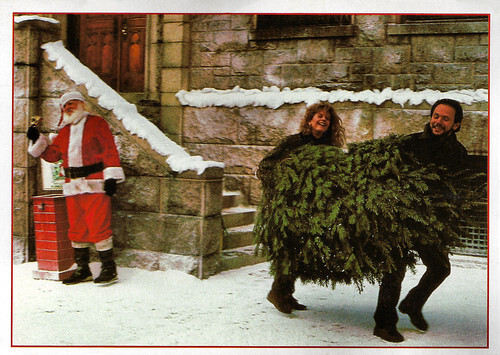
British postcard by Odeon Cinemas. Photo: Meg Ryan and Billy Crystal in When Harry met Sally... (Rob Reiner, 1989). Caption: Season's Greetings from Harry and Sally and everyone at Odeon Cinemas. The hit comedy of the year, Billy Crystal, Meg Ryan, When Harry met Sally..., a new comedy by Rob Reiner. . "A clear winner", Jonathan King - The Sun. "Touching, hilarious, honest...There hasn't been a more satisfying film this year"- 20/20. At Odeon Cinemas from Jan 5th.
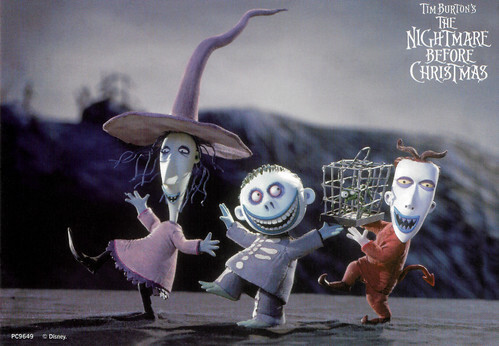
British postcard by Pyramid Posters, Leicester, no. PC 9649. Image: Disney. Spooky kids in The Nightmare Before Christmas (Henry Selick, 1993).
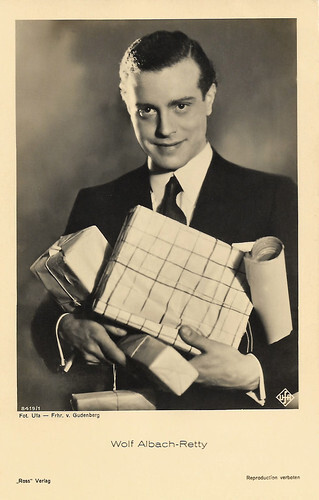
German postcard by Ross Verlag, no. 8419/1, 1933-1934. Photo: Ufa / Frhr. von Gudenberg. Wolf Albach-Retty .
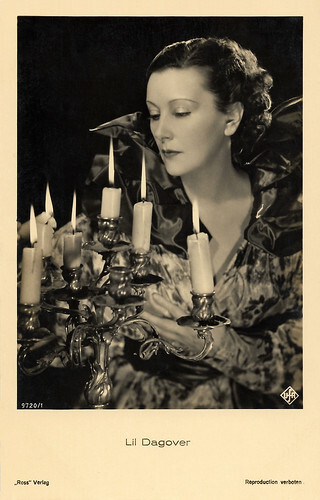
German postcard by Ross Verlag, no. 9720/1, 1935-1936. Photo: Ufa. Lil Dagover .
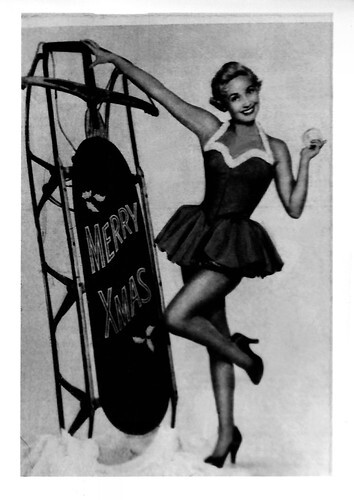
Small Dutch collectors card. Jane Powell .
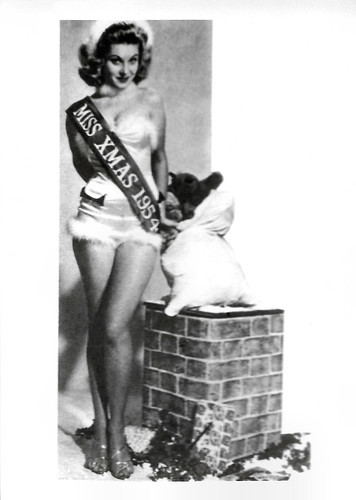
Small Dutch collectors card. Belinda Lee .
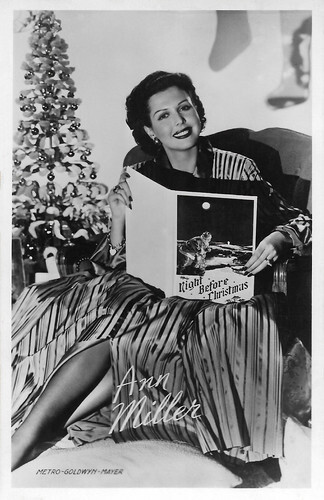
Vintage postcard, no. A.X. 292. Photo: Metro-Goldwyn-Mayer. Ann Miller.
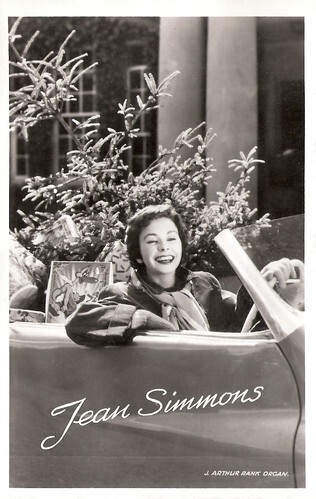
Dutch postcard by Uitg. Takken, Utrecht. Photo: J. Arthur Rank Organ. Jean Simmons .
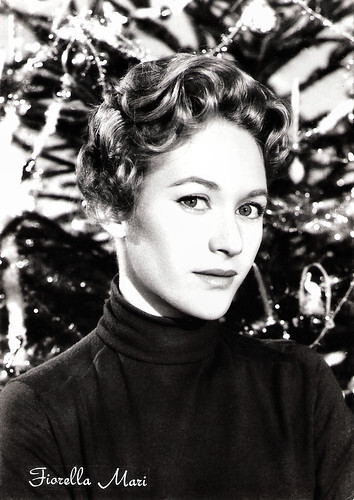
Italian postcard by Rotalfoto, Milano, no. 611.
Italian actress Forella Mari (1928) was the leading lady of a dozen European films of the 1950s. She retired at the end of the decade.
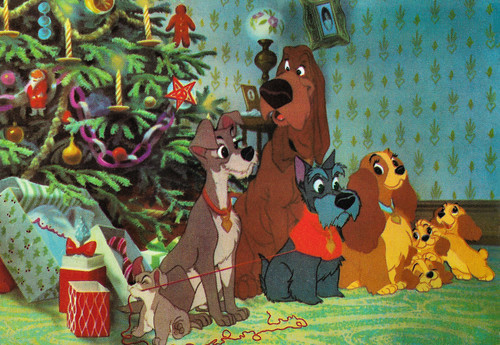
French postcard by Editions Crès, Paris, no. 202, 1964. Caption: The Reunion. Image: Walt Disney Productions. Publicity still for Lady and the Tramp (Clyde Geronimi, Wilfred Jackson, Hamilton Luske, 1955).
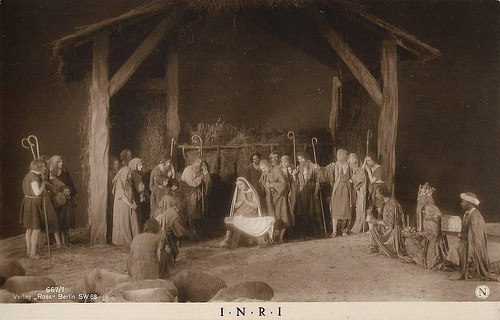
German postcard. Ross Verlag, no. 667/1. Photo: Neumann. The Nativity Scene with Henny Porten as Mary in the Biblical film I.N.R.I. (Robert Wiene, 1923).
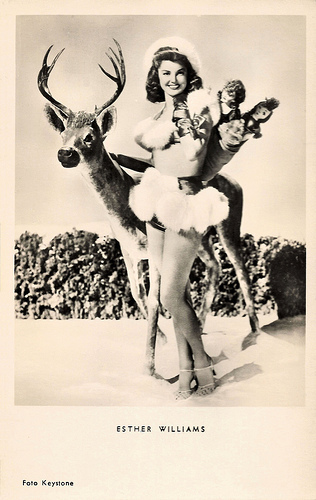
Esther Williams. German postcard by Kunst und Bild, Berlin, no. A 190. Photo: Keystone.
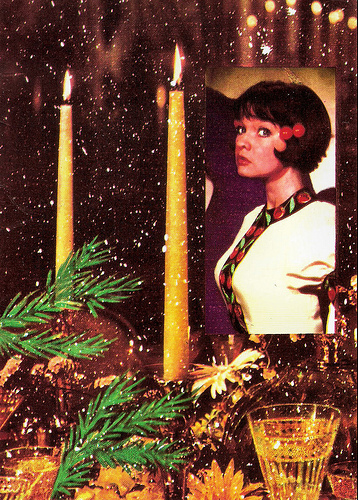
Margareta Pislaru . Romanian postcard by Casa Filmului Acin.
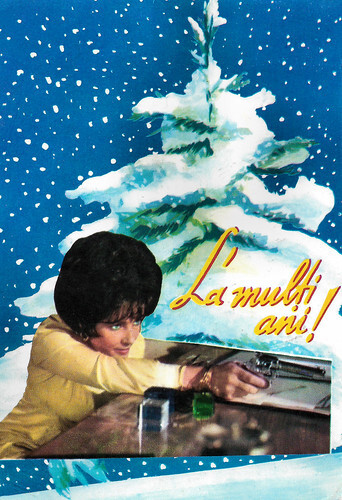
Romanian postcard by Casa Filmului Acin, no. 126. Elizabeth Taylor in The Comedians (Peter Glenville, 1967). Sent by mail in 1971.
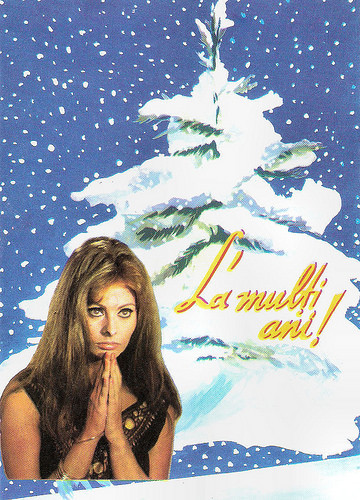
Sophia Loren . Romanian postcard by Casa Filmului Acin.
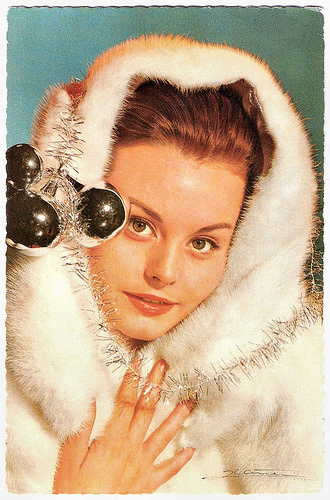
Rocío Dúrcal . Spanish postcard by Ediciones Tarjet-Fher / Ediciones Mandolina, no. 216. Photo: Epoca Films.
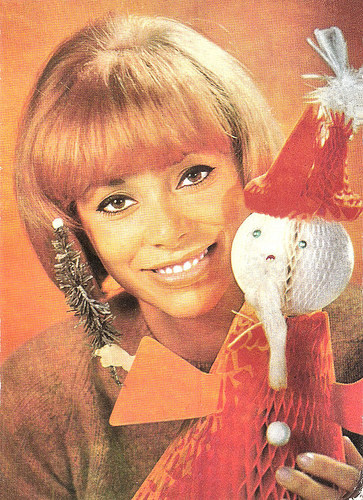
Mireille Darc . Romanian postcard by Casa Filmului Acin, no. 436.
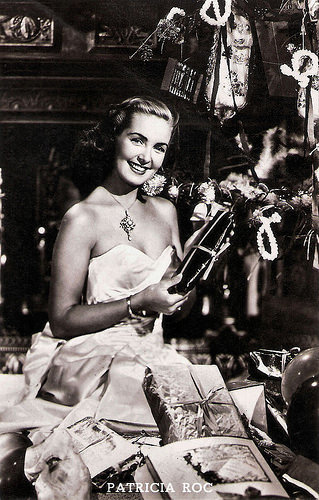
Patricia Roc . Dutch postcard. Photo: British Lion.
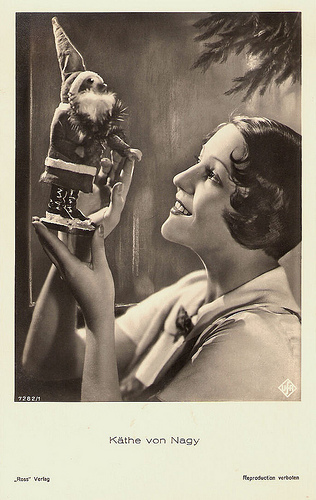
Käthe von Nagy . German postcard by Ross Verlag, no. 7282/1. Photo: Ufa. Released in Italy by Ed. Ballerini & Fratini, Firenze.
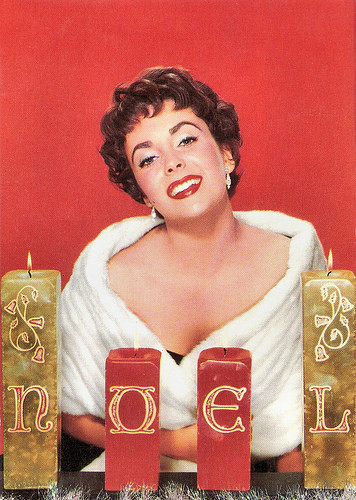
Elizabeth Taylor . French postcard by Editions P.I., Paris, no. 1051. Photo: John Everton / Ufa.
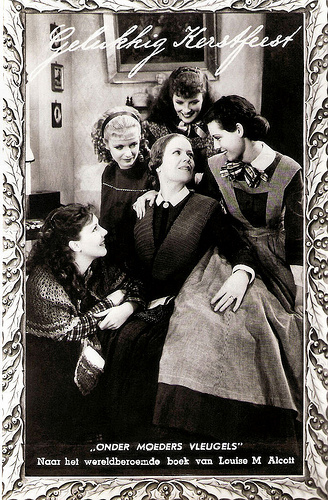
Dutch postcard by the Rialto Theatre, Amsterdam, 1934. Photo: Remaco Radio Picture. Publicity still for Little Women (George Cukor, 1933). In the picture are Katharine Hepburn , Joan Bennett , Frances Dee, Jean Parker, and Spring Byington. The Dutch title of the film and the book by Louise M. Alcott is Onder moeders vleugels.
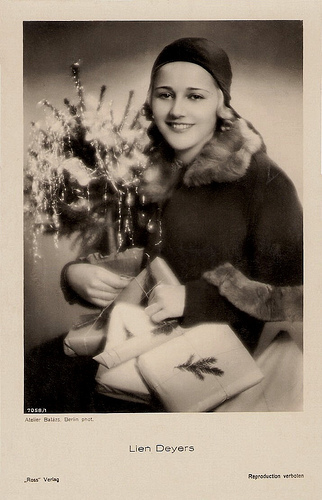
Lien Deyers . German postcard by Ross Verlag, no. 7058/1, 1932-1933. Photo: Atelier Balász, Berlin.
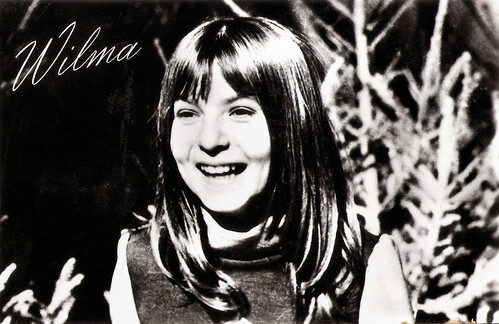
Dutch postcard by Muziek Parade, Amsterdam, no. AX 7249.
In the late 1960s and the early 1970s, sweet little Wilma (1957) was a popular Dutch child star. At 11, she had hits in both the Netherlands and Germany and also appeared in some Schlager films.
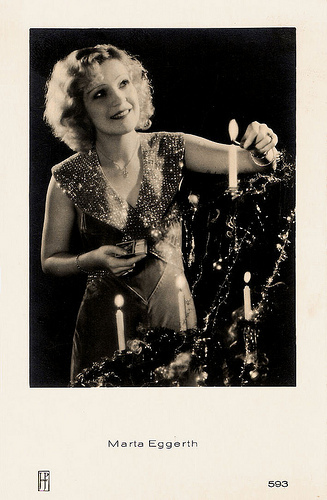
Marta Eggerth . Dutch postcard by JosPe, no. 593.
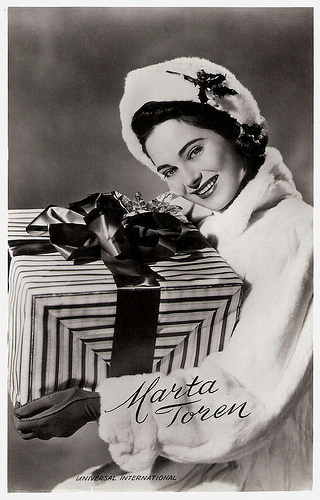
Marta Toren . Dutch postcard, no. 3374. Photo: Universal International / Fotoarchief Film en Toneel.
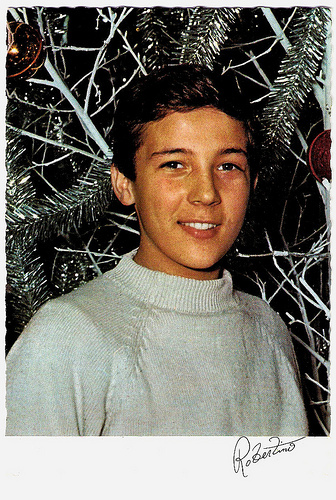
Robertino . French postcard by Editions Publistar, Marseille, no. 811. Photo: President.
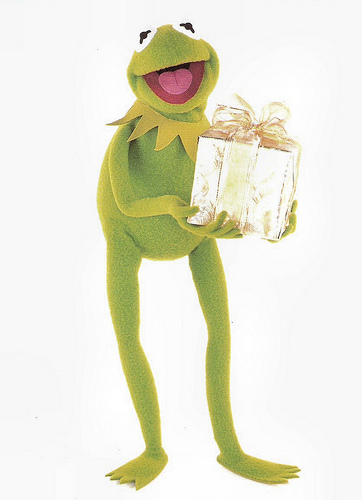
Kermit. Dutch postcard by Interstat, Amsterdam. Photo: The Jim Henson Company.
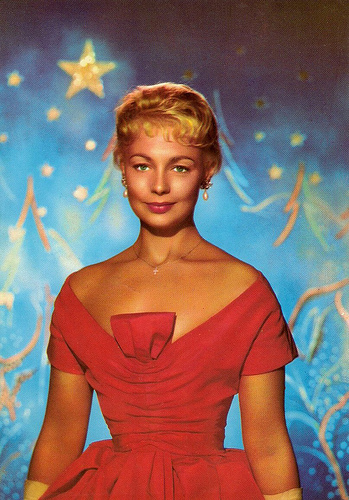
Dany Robin . French postcard by Editions P.I., Paris, no. 1004. Photo: Sam Lévin.
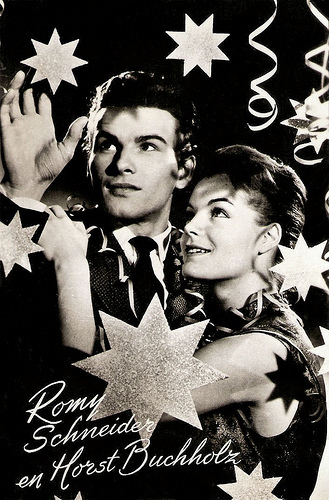
Romy Schneider & Horst Buchholz . Dutch postcard by Uitg. Takken, Utrecht, no. 3572.
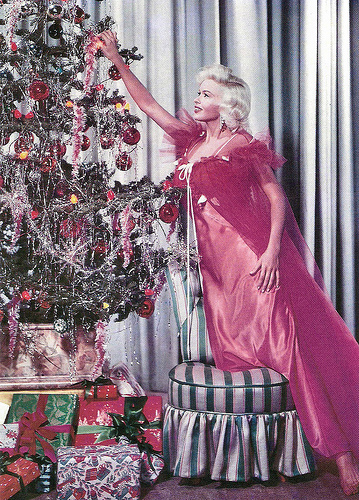
Jayne Mansfield. French postcard by Edition a la carte. Photo: Filmhistorisches Bildarchiv Peter W. Engelmeier.
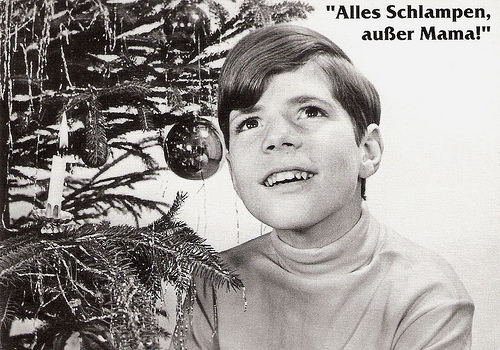
Heintje Simons . German postcard by Modern Times. Photo: Interfoto. Caption: Alles schlampen, ausser mama (All bitches, except mama).
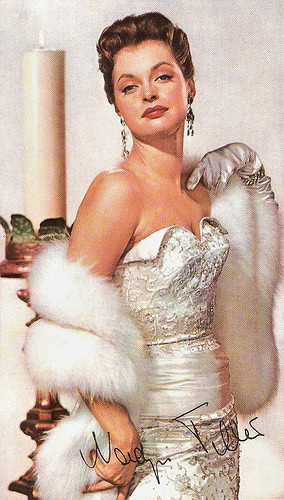
Nadja Tiller . German promotion card for Luxor.

German postcard by Rotophot in the Film Sterne series, no. 542/1. Photo: Messter-Film. Viggo Larsen in Der Sohn des Hannibal/The Son of Hannibal (Viggo Larsen, 1918).
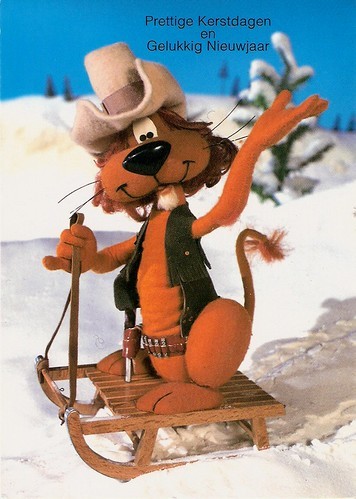
Dutch postcard by Gebr. Spanjersberg, Capelle ad IJssel / Brasschaat. Image: Joop Geesink's Dollywood, 1988. Loekie de Leeuw . Caption: Merry Christmas and Happy New Year. Sent by mail in 1989.

French postcard by Sip, no. 2500. Caption: Reutlinger, Paris. Sent by mail in 1909. Miss Campton .

British postcard by Odeon Cinemas. Photo: Meg Ryan and Billy Crystal in When Harry met Sally... (Rob Reiner, 1989). Caption: Season's Greetings from Harry and Sally and everyone at Odeon Cinemas. The hit comedy of the year, Billy Crystal, Meg Ryan, When Harry met Sally..., a new comedy by Rob Reiner. . "A clear winner", Jonathan King - The Sun. "Touching, hilarious, honest...There hasn't been a more satisfying film this year"- 20/20. At Odeon Cinemas from Jan 5th.

British postcard by Pyramid Posters, Leicester, no. PC 9649. Image: Disney. Spooky kids in The Nightmare Before Christmas (Henry Selick, 1993).

German postcard by Ross Verlag, no. 8419/1, 1933-1934. Photo: Ufa / Frhr. von Gudenberg. Wolf Albach-Retty .

German postcard by Ross Verlag, no. 9720/1, 1935-1936. Photo: Ufa. Lil Dagover .

Small Dutch collectors card. Jane Powell .

Small Dutch collectors card. Belinda Lee .

Vintage postcard, no. A.X. 292. Photo: Metro-Goldwyn-Mayer. Ann Miller.

Dutch postcard by Uitg. Takken, Utrecht. Photo: J. Arthur Rank Organ. Jean Simmons .

Italian postcard by Rotalfoto, Milano, no. 611.
Italian actress Forella Mari (1928) was the leading lady of a dozen European films of the 1950s. She retired at the end of the decade.

French postcard by Editions Crès, Paris, no. 202, 1964. Caption: The Reunion. Image: Walt Disney Productions. Publicity still for Lady and the Tramp (Clyde Geronimi, Wilfred Jackson, Hamilton Luske, 1955).

German postcard. Ross Verlag, no. 667/1. Photo: Neumann. The Nativity Scene with Henny Porten as Mary in the Biblical film I.N.R.I. (Robert Wiene, 1923).

Esther Williams. German postcard by Kunst und Bild, Berlin, no. A 190. Photo: Keystone.

Margareta Pislaru . Romanian postcard by Casa Filmului Acin.

Romanian postcard by Casa Filmului Acin, no. 126. Elizabeth Taylor in The Comedians (Peter Glenville, 1967). Sent by mail in 1971.

Sophia Loren . Romanian postcard by Casa Filmului Acin.

Rocío Dúrcal . Spanish postcard by Ediciones Tarjet-Fher / Ediciones Mandolina, no. 216. Photo: Epoca Films.

Mireille Darc . Romanian postcard by Casa Filmului Acin, no. 436.

Patricia Roc . Dutch postcard. Photo: British Lion.

Käthe von Nagy . German postcard by Ross Verlag, no. 7282/1. Photo: Ufa. Released in Italy by Ed. Ballerini & Fratini, Firenze.

Elizabeth Taylor . French postcard by Editions P.I., Paris, no. 1051. Photo: John Everton / Ufa.

Dutch postcard by the Rialto Theatre, Amsterdam, 1934. Photo: Remaco Radio Picture. Publicity still for Little Women (George Cukor, 1933). In the picture are Katharine Hepburn , Joan Bennett , Frances Dee, Jean Parker, and Spring Byington. The Dutch title of the film and the book by Louise M. Alcott is Onder moeders vleugels.

Lien Deyers . German postcard by Ross Verlag, no. 7058/1, 1932-1933. Photo: Atelier Balász, Berlin.

Dutch postcard by Muziek Parade, Amsterdam, no. AX 7249.
In the late 1960s and the early 1970s, sweet little Wilma (1957) was a popular Dutch child star. At 11, she had hits in both the Netherlands and Germany and also appeared in some Schlager films.

Marta Eggerth . Dutch postcard by JosPe, no. 593.

Marta Toren . Dutch postcard, no. 3374. Photo: Universal International / Fotoarchief Film en Toneel.

Robertino . French postcard by Editions Publistar, Marseille, no. 811. Photo: President.

Kermit. Dutch postcard by Interstat, Amsterdam. Photo: The Jim Henson Company.

Dany Robin . French postcard by Editions P.I., Paris, no. 1004. Photo: Sam Lévin.

Romy Schneider & Horst Buchholz . Dutch postcard by Uitg. Takken, Utrecht, no. 3572.

Jayne Mansfield. French postcard by Edition a la carte. Photo: Filmhistorisches Bildarchiv Peter W. Engelmeier.

Heintje Simons . German postcard by Modern Times. Photo: Interfoto. Caption: Alles schlampen, ausser mama (All bitches, except mama).

Nadja Tiller . German promotion card for Luxor.

German postcard by Rotophot in the Film Sterne series, no. 542/1. Photo: Messter-Film. Viggo Larsen in Der Sohn des Hannibal/The Son of Hannibal (Viggo Larsen, 1918).

Dutch postcard by Gebr. Spanjersberg, Capelle ad IJssel / Brasschaat. Image: Joop Geesink's Dollywood, 1988. Loekie de Leeuw . Caption: Merry Christmas and Happy New Year. Sent by mail in 1989.
Published on December 24, 2021 22:00
December 23, 2021
James Cagney
Energetic, wise-cracking James Cagney (1899-1986) was an American film actor, famous for his gangster roles in the 1930s and 1940s. One of the brightest stars of the Golden Age of Hollywood, Cagney was not only a multifaceted tough guy but also an accomplished dancer and he easily played light comedy.
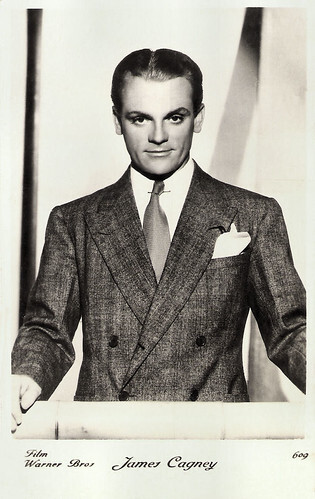
French postcard, no. 609. Photo: Warner Bros.
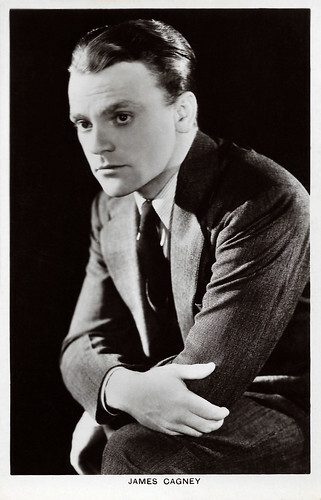
British postcard in the Picturegoer Series, London. no. 655.
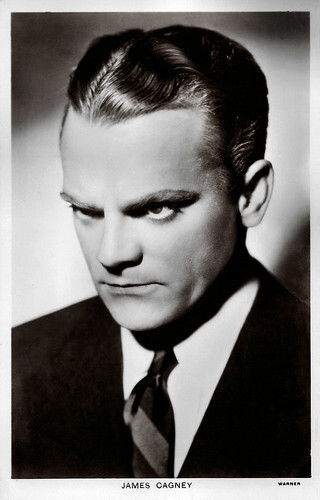
British postcard in the Picturegoer Series, London. no. 655b. Photo: Warner Bros.
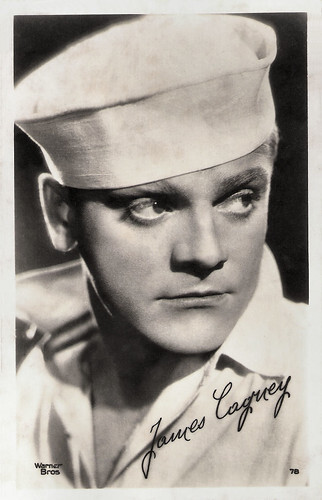
French postcard by Editions et Publications cinématographiques, no. 78. Photo: Warner Bros. James Cagney in Here Comes the Navy (Lloyd Bacon, 1934).
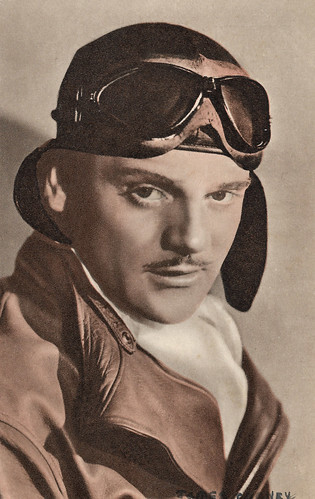
British postcard in the A Real Photogravure Portrait series. Photo: James Cagney in Ceiling Zero (Howard Hawks, 1936). Caption: James Cagney managed to support his family as a dancer and singer. This very keen athlete and boxer was discovered on the New York stage by a film scout and sent to Hollywood. His latest pictures are Frisco Kid and Ceiling Zero.
The sympathetic 'bad' guy
James Francis 'Jimmy' Cagney was born in 1899 on the Lower East Side of Manhattan in New York City. His parents were Carolyn (Nelson) and James Francis Cagney, Sr., who was a bartender and amateur boxer. Jimmy had one sister, the actress Jeanne Cagney, and three brothers, including the actor and film producer William Cagney who was also his manager.
In his first professional acting performance in 1919, Cagney was costumed as a woman when he danced in the chorus line of the revue 'Every Sailor'. In 1920, Cagney was a member of the chorus for the show 'Pitter Patter,' where he met Frances Willard 'Billie' Vernon. They married the following year.
Cagney spent several years in vaudeville as a dancer and comedian, until he got his first major acting part in 1925. He played a young tough guy in the three-act play 'Outside Looking In' by Maxwell Anderson. He secured several other roles, receiving good notices, before landing the lead in the 1929 play 'Penny Arcade'.
When Warner Bros. Pictures bought the film rights to the play, they took Cagney and his colleague Joan Blondell from the theatre to the big-screen version, retitled Sinner's Holiday (John G. Adolfi, 1930). Cagney received a full seven-year contract at $400 a week. His role as the sympathetic 'bad' guy was to become a recurring character type for Cagney throughout his career.
Cagney's fifth film, The Public Enemy (William A. Wellman, 1931) with Jean Harlow , became one of the most influential gangster movies of the period. Notable for a famous scene in which Cagney pushes a grapefruit against Mae Clarke's face, the film thrust him into the spotlight. Cagney starred in many films after that and was nicknamed the tough guy by a series of crime films such as Blonde Crazy (Roy Del Ruth, 1931) with Joan Blondell , and Hard to Handle (Mervyn LeRoy, 1933) with Mary Brian.
Sandra Brennan at AllMovie : "Cagney was a small, rather plain-looking man, and had few of the external qualities usually associated with the traditional Hollywood leading man during the '30s. Yet, inside, he was a dynamo, able to project contentious and arrogant confidence that made him the ideal Hollywood tough guy." However, Cagney was not content to simply play one type of role.
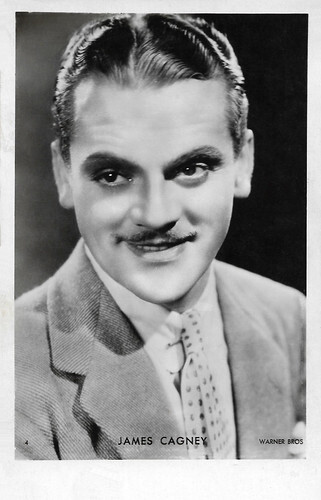
French postcard by Editions Chantal, Paris, no. 4. Photo: Warner Bros.
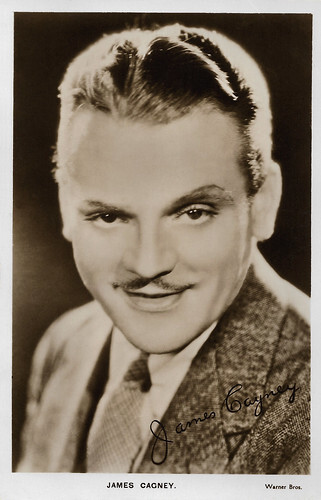
British postcard in the Film Kurier Series, London. no. 70. Photo: Warner Bros.
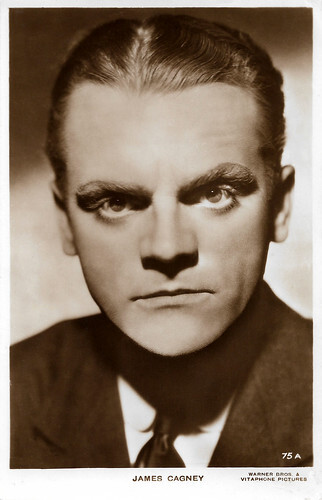
British Real Photograph postcard, no. 75A. Photo: Warner Bros. & Vitaphone Pictures.
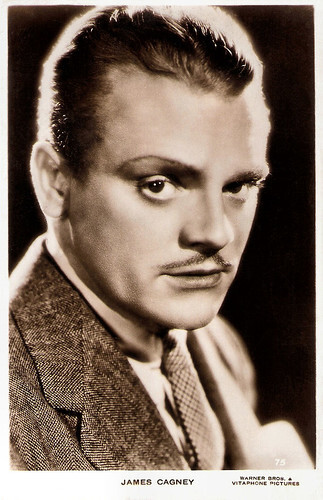
British Real Photograph postcard, no. 75. Photo: Warner Bros & Vitaphone Pictures.
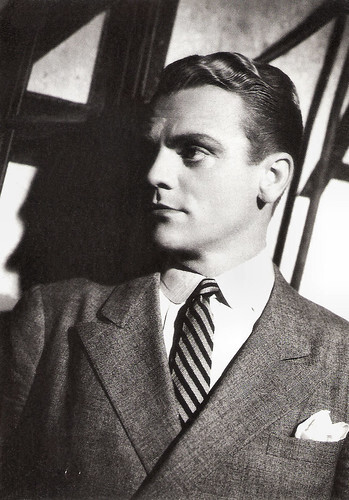
German postcard by Edition Cicero Art Postcard, Hamburg, no. 15008. Photo: Elmer Fryer / Kobal Collection / New Eyes. Caption: James Cagney in 1933.
Made it, Ma! Top of the world!
From 1935 on, James Cagney was cast more frequently in non-gangster roles. He played a lawyer who joins the FBI in G-Men (William Keighley, 1935) with Ann Dvorak. That year, he also took on his first, and only, Shakespearean role, as top-billed Nick Bottom in A Midsummer Night's Dream (Max Reinhardt, 1935) alongside Joe E. Brown as Flute and Mickey Rooney as Puck.
In 1938 he received his first Academy Award nomination for Best Actor for his subtle portrayal of the tough guy/man-child Rocky Sullivan in Angels with Dirty Faces (Michael Curtiz, 1938) with Pat O'Brien. In 1942 Cagney won the Oscar for his energetic portrayal of George M. Cohan in Yankee Doodle Dandy (Michael Curtiz, 1942).
Later memorable films were White Heat (Raoul Walsh, 1949) with the quote "Made it, Ma! Top of the world!", and Mister Roberts (John Ford, Mervyn LeRoy, 1955) opposite Henry Fonda . He was one of the founders of the Screen Actors Guild and was its president from 1942-1944. The satire One, Two, Three (Billy Wilder, 1961) was the end of a career that spanned more than 70 films.
During the next decades, Cagney turned down all roles in order to spend time learning to paint, at which he became very good, and maintaining his farm in Stanfordville, New York. In 1974, he received a Lifetime Achievement Award from the American Film Institute. After 1979, his health declined rapidly and he suffered from diabetes.
Then he returned to the cinema for a small but crucial role in Ragtime (Milos Forman, 1981), the screen adaptation of E.L. Doctorow's novel. In this film, he was reunited with his frequent co-star of the 1930s, Pat O'Brien. In 1984 he also received the Presidential Medal of Freedom from his friend Ronald Reagan.
Cagney's final performance came in the title role of the made-for-TV movie Terrible Joe Moran (Joseph Sargent, 1984), in which he played as a grumpy ex-prizefighter opposite Art Carney. In 1986, he died of a heart attack in Stanfordville (New York), at the age of 86. He is buried in Hawthorne in New York. Cagney and his wife, Frances Wilhard 'Billie' Vernon (1899-1994), were together for 64 years.
They adopted a son, James Cagney Jr., and a daughter, Cathleen 'Casey' Cagney. James Cagney's electric acting style was a huge influence on future generations of actors. According to IMDb , actors as diverse as Clint Eastwood and Malcolm McDowell point to him as their number one influence to become actors.
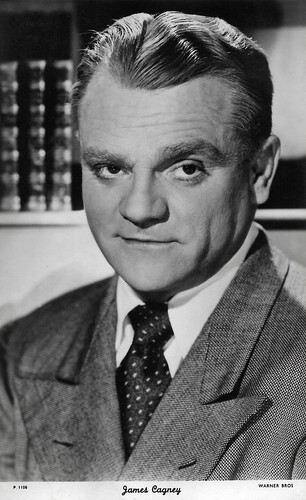
British postcard in The People Series by Show Parade Picture Service, London, no. P 1106. Photo: Warner Bros.

Belgian collectors card by Chocolaterie Clovis, Pepinster, no. 40. Photo: Warner Bros. Collection: Amit Benyovits.
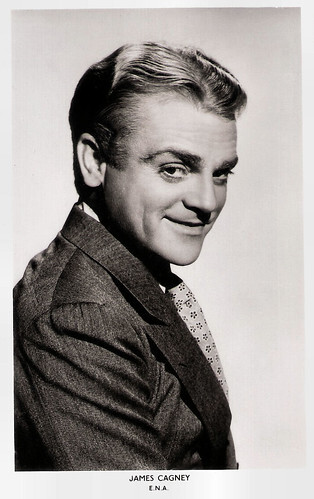
British Real Photograph postcard. Photo: E.N.A.
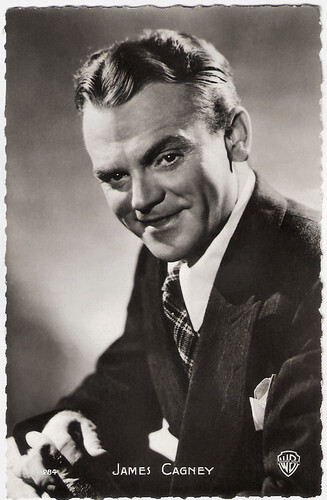
French postcard by Editions P.I., Paris, no. 284. Photo: Warner Bros.
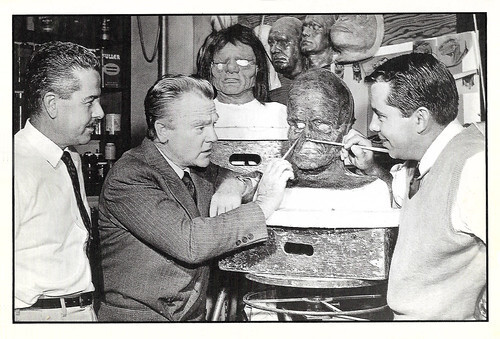
French postcard in the Entr'acte series by Éditions Asphodèle. Mâcon, no. 001/30. James Cagney, Bud Westmore, and Jack Kevan on the set of Man of a Thousand Faces (Joseph Pevney, 1957). Caption: Development of the mask to be worn by James Cagney in the film about Lon Chaney senior 's career with chief make-up artist Bud Westmore and his assistant Jack Kevan.
Sources: Sandra Brennan (AllMovie), (IMDb), Wikipedia (Dutch and English), and .

French postcard, no. 609. Photo: Warner Bros.

British postcard in the Picturegoer Series, London. no. 655.

British postcard in the Picturegoer Series, London. no. 655b. Photo: Warner Bros.

French postcard by Editions et Publications cinématographiques, no. 78. Photo: Warner Bros. James Cagney in Here Comes the Navy (Lloyd Bacon, 1934).

British postcard in the A Real Photogravure Portrait series. Photo: James Cagney in Ceiling Zero (Howard Hawks, 1936). Caption: James Cagney managed to support his family as a dancer and singer. This very keen athlete and boxer was discovered on the New York stage by a film scout and sent to Hollywood. His latest pictures are Frisco Kid and Ceiling Zero.
The sympathetic 'bad' guy
James Francis 'Jimmy' Cagney was born in 1899 on the Lower East Side of Manhattan in New York City. His parents were Carolyn (Nelson) and James Francis Cagney, Sr., who was a bartender and amateur boxer. Jimmy had one sister, the actress Jeanne Cagney, and three brothers, including the actor and film producer William Cagney who was also his manager.
In his first professional acting performance in 1919, Cagney was costumed as a woman when he danced in the chorus line of the revue 'Every Sailor'. In 1920, Cagney was a member of the chorus for the show 'Pitter Patter,' where he met Frances Willard 'Billie' Vernon. They married the following year.
Cagney spent several years in vaudeville as a dancer and comedian, until he got his first major acting part in 1925. He played a young tough guy in the three-act play 'Outside Looking In' by Maxwell Anderson. He secured several other roles, receiving good notices, before landing the lead in the 1929 play 'Penny Arcade'.
When Warner Bros. Pictures bought the film rights to the play, they took Cagney and his colleague Joan Blondell from the theatre to the big-screen version, retitled Sinner's Holiday (John G. Adolfi, 1930). Cagney received a full seven-year contract at $400 a week. His role as the sympathetic 'bad' guy was to become a recurring character type for Cagney throughout his career.
Cagney's fifth film, The Public Enemy (William A. Wellman, 1931) with Jean Harlow , became one of the most influential gangster movies of the period. Notable for a famous scene in which Cagney pushes a grapefruit against Mae Clarke's face, the film thrust him into the spotlight. Cagney starred in many films after that and was nicknamed the tough guy by a series of crime films such as Blonde Crazy (Roy Del Ruth, 1931) with Joan Blondell , and Hard to Handle (Mervyn LeRoy, 1933) with Mary Brian.
Sandra Brennan at AllMovie : "Cagney was a small, rather plain-looking man, and had few of the external qualities usually associated with the traditional Hollywood leading man during the '30s. Yet, inside, he was a dynamo, able to project contentious and arrogant confidence that made him the ideal Hollywood tough guy." However, Cagney was not content to simply play one type of role.

French postcard by Editions Chantal, Paris, no. 4. Photo: Warner Bros.

British postcard in the Film Kurier Series, London. no. 70. Photo: Warner Bros.

British Real Photograph postcard, no. 75A. Photo: Warner Bros. & Vitaphone Pictures.

British Real Photograph postcard, no. 75. Photo: Warner Bros & Vitaphone Pictures.

German postcard by Edition Cicero Art Postcard, Hamburg, no. 15008. Photo: Elmer Fryer / Kobal Collection / New Eyes. Caption: James Cagney in 1933.
Made it, Ma! Top of the world!
From 1935 on, James Cagney was cast more frequently in non-gangster roles. He played a lawyer who joins the FBI in G-Men (William Keighley, 1935) with Ann Dvorak. That year, he also took on his first, and only, Shakespearean role, as top-billed Nick Bottom in A Midsummer Night's Dream (Max Reinhardt, 1935) alongside Joe E. Brown as Flute and Mickey Rooney as Puck.
In 1938 he received his first Academy Award nomination for Best Actor for his subtle portrayal of the tough guy/man-child Rocky Sullivan in Angels with Dirty Faces (Michael Curtiz, 1938) with Pat O'Brien. In 1942 Cagney won the Oscar for his energetic portrayal of George M. Cohan in Yankee Doodle Dandy (Michael Curtiz, 1942).
Later memorable films were White Heat (Raoul Walsh, 1949) with the quote "Made it, Ma! Top of the world!", and Mister Roberts (John Ford, Mervyn LeRoy, 1955) opposite Henry Fonda . He was one of the founders of the Screen Actors Guild and was its president from 1942-1944. The satire One, Two, Three (Billy Wilder, 1961) was the end of a career that spanned more than 70 films.
During the next decades, Cagney turned down all roles in order to spend time learning to paint, at which he became very good, and maintaining his farm in Stanfordville, New York. In 1974, he received a Lifetime Achievement Award from the American Film Institute. After 1979, his health declined rapidly and he suffered from diabetes.
Then he returned to the cinema for a small but crucial role in Ragtime (Milos Forman, 1981), the screen adaptation of E.L. Doctorow's novel. In this film, he was reunited with his frequent co-star of the 1930s, Pat O'Brien. In 1984 he also received the Presidential Medal of Freedom from his friend Ronald Reagan.
Cagney's final performance came in the title role of the made-for-TV movie Terrible Joe Moran (Joseph Sargent, 1984), in which he played as a grumpy ex-prizefighter opposite Art Carney. In 1986, he died of a heart attack in Stanfordville (New York), at the age of 86. He is buried in Hawthorne in New York. Cagney and his wife, Frances Wilhard 'Billie' Vernon (1899-1994), were together for 64 years.
They adopted a son, James Cagney Jr., and a daughter, Cathleen 'Casey' Cagney. James Cagney's electric acting style was a huge influence on future generations of actors. According to IMDb , actors as diverse as Clint Eastwood and Malcolm McDowell point to him as their number one influence to become actors.

British postcard in The People Series by Show Parade Picture Service, London, no. P 1106. Photo: Warner Bros.

Belgian collectors card by Chocolaterie Clovis, Pepinster, no. 40. Photo: Warner Bros. Collection: Amit Benyovits.

British Real Photograph postcard. Photo: E.N.A.

French postcard by Editions P.I., Paris, no. 284. Photo: Warner Bros.

French postcard in the Entr'acte series by Éditions Asphodèle. Mâcon, no. 001/30. James Cagney, Bud Westmore, and Jack Kevan on the set of Man of a Thousand Faces (Joseph Pevney, 1957). Caption: Development of the mask to be worn by James Cagney in the film about Lon Chaney senior 's career with chief make-up artist Bud Westmore and his assistant Jack Kevan.
Sources: Sandra Brennan (AllMovie), (IMDb), Wikipedia (Dutch and English), and .
Published on December 23, 2021 22:00
December 22, 2021
Sally Ann Howes (1930-2021)
English-American actress and singer Sally Ann Howes (1930) passed away on 19 December 2021. She was best known for the role of Truly Scrumptious in Chitty Chitty Bang Bang (1968). She had her first screen test offer on her 12th birthday and went on to star in several films before she turned 20. Her career on stage, screen, and television would span over six decades. Sally Ann Howes was 91
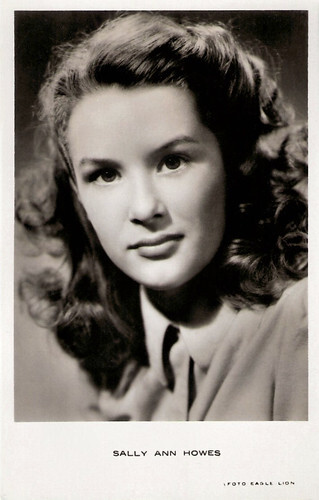
Dutch postcard by Hemo. Photo: Eagle Lion.
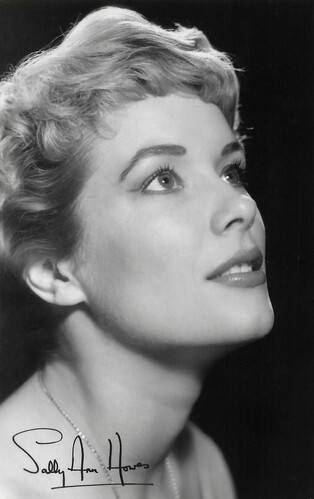
British promotion card for the stage production 'A Hatful of Rain' (1957). Caption: March 1957, A pleasant evening to you - and I hope you enjoy 'A Hatful of Rain'. I hope too you will like the story I have specially written for 'The Star' which is appearing now. Best wishes - Sally Ann Howes.
A leading musical comedy star
Sally Ann Howes was born in St John's Wood, London in 1930. She was the daughter of British comedian/actor Bobby Howes and actress/singer Patricia Malone, and the granddaughter of Capt. J.A.E. Malone, London theatrical director of musicals. Her older brother, Peter Howes, was a professional musician and music professor. She was a show-business baby who lived a quiet, orderly childhood where she grew up with a nanny and was surrounded by a variety of pets and her parents' theatrical peers, including Jack Hulbert and Cicely Courtneidge , who had an adjoining house.
During World War II, Howes moved to the family's country house in Essendon. Another family friend, an agent suggested the young Sally Ann for a role in a film. Two hundred young girls had already been screen-tested for the drama Thursday's Child, written by Rodney Ackland, and his directorial debut. As a juvenile star whose fame wreaked havoc upon her family, Thursday's Child (Rodney Ackland, 1943) launched her career.
A second film, The Halfway House (Basil Dearden, 1944), led to her being put under contract by Michael Balcon of Ealing Studios. This was followed by many other film roles as a child actress, including the multi-storied horror classic Dead of Night (Alberto Cavalcanti, Charles Crichton, Basil Dearden, Robert Hamer, 1945) with Sir Michael Redgrave , Pink String and Sealing Wax (Robert Hamer, 1946), Nicholas Nickleby (Alberto Cavalcanti, 1947), My Sister and I (Harmot Huth, 1948) and Anna Karenina (Julien Duvivier, 1948), with Vivien Leigh .
At the age of 18, the Rank Organisation put her under a seven-year contract, and she went on to make such films as The History of Mr. Polly (Anthony Pelissier, 1949) with John Mills , and the Italian-British comedy Due mogli sono trope/Honeymoon Deferred (Mario Camerini, 1950).
Howes had begun taking singing lessons on the recommendation of a visiting teacher friend not only to bring out her natural talents but also in an effort to lower her speaking voice which was quite high-pitched. While still in her teens, she made her first musical-comedy stage appearance in 'Fancy Free'. At 20, she received her first starring stage role in Glasgow in the Sandy Wilson musical 'Caprice'.
It forced her to terminate her contract with Rank, where she'd been unhappy with the film roles and being on ‘loan out’. She was finding gainful employment in television and radio, including a starring role in a BBC TV version of Cinderella (1950). Howes was looking to flex her singing talent, something that both Balcon and Rank had overlooked. 'Caprice' was followed by 'Bet Your Life' with Julie Wilson.
In 1953, she starred on the West End in the musical 'Paint Your Wagon' with her father, Bobby Howes. The show ran for 18 months. It was followed by 148 performances in 'Summer Song', also on the West End, firmly establishing her as a leading musical comedy star. This was followed by her critically acclaimed performance in the stage drama, 'A Hatful of Rain'(1957). She mixed her theatre with television appearances and even modelling, commercials, and product endorsements.
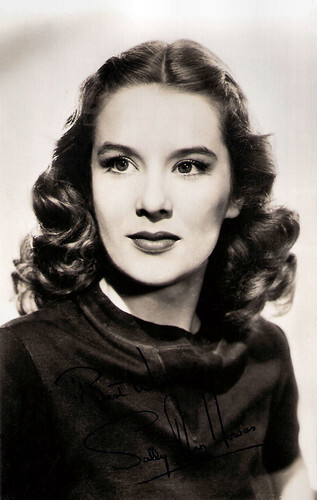
British autograph card.
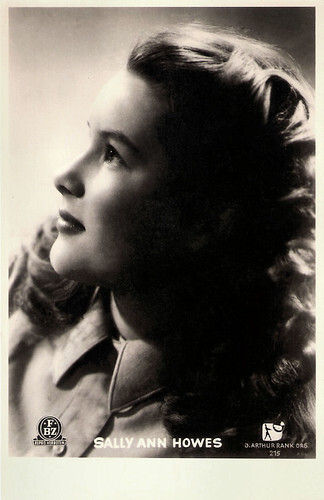
German postcard by F.B.Z., no. 215. Photo: J. Arthur Rank Org.
Broadway
Sally Ann Howes became a popular celebrity in England, even appearing as a comic-strip character in TV Fun serial comics and annuals, as a young, wholesome teacher in the wild American west at a time when Western TV shows were very popular. She made incidental film appearances such as in The admirable Crichton (Lewis Gilbert, 1957) with Kenneth More.
In 1958 she accepted the role of Eliza Doolittle in Broadway's 'My Fair Lady', taking over from Julie Andrews . The role had been offered to her three times previously, but film and stage commitments kept her from assuming the part. With the persistence of Lerner and Loewe, however, she accepted the third time, for a year's contract, but at a higher salary than Julie Andrews. She became an instant hit as a very fiery Eliza Doolittle.
In January 1958, Howes married Tony-winning composer Richard Adler ('The Pajama Game', 'Damn Yankees'). The following December, she appeared on television in Adler's musical adaptation of O. Henry's short story, The Gift of the Magi.
Adler and Bob Merrill collaborated on a musical version of W. Somerset Maugham's 'Of Human Bondage' so that Howes could play Mildred. She appeared on many TV shows including The Ed Sullivan Show four times. Howes returned to Broadway in 1961 in the short run of 'Kwamina', another Adler musical.
In 1962, she starred in a short revival of the musical 'Brigadoon' at the New York City Opera and received a Tony nomination, the first performer to be nominated for a revival performance. In 1964 she starred on Broadway opposite Robert Alda and Steve Lawrence in the energetic 'What Makes Sammy Run?' that lasted for over 500 performances. A TV version of Brigadoon (1966) with Howes, Robert Goulet, and Peter Falk won six Emmy Awards.
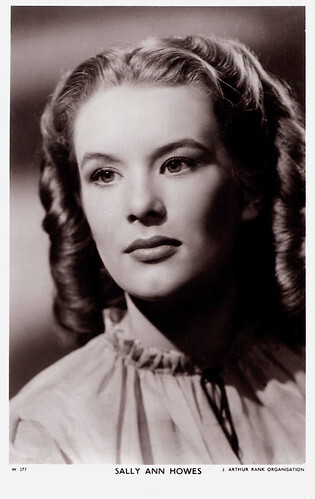
British postcard in the Picturegoer Series, no. W 377. Photo: J. Arthur Rank Organisation.
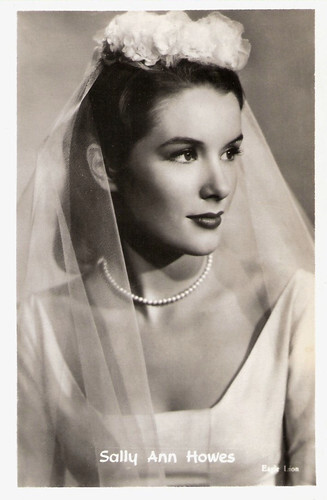
Dutch postcard. Photo: Eagle Lion.
Chitty Chitty Bang Bang
In 1967, Sally Ann Howes began the 14 months film shoot of Chitty Chitty Bang Bang (Ken Hughes, 1968). In the children's fantasy musical she starred opposite Dick van Dyke as Truly Scrumptious, the lovely and charming daughter of a confectionery magnate. The film became a fondly remembered hit.
Chitty Chitty Bang Bang did not, however, restart her film career. In addition, musicals were now failing at the box office and that avenue was closed to her. As a result, she returned almost exclusively to the musical stage, appearing in only a few more films and TV productions.
In the 1970s, she toured Britain with 'The King and I' and later the USA with 'The Sound of Music'. After her debut with the Los Angeles Civic Light Opera in 1972 with 'The Sound of Music', she returned to Britain to star in the stage drama, 'Lover', which was written specifically for her.
In the 1970s and 1980s, she began to cross over from standard musicals to operettas. She performed two summers with the Kenley Players in 'Blossom Time' and 'The Great Waltz', and she later added Franz Lehár's 'The Merry Widow' and then two seasons of Stephen Sondheim's 'A Little Night Music' at the New York City Opera. She also added the role of Gertrude in 'Hamlet' to her repertoire.
In 1990, she debuted her one-woman show, 'From This Moment On' at the Edinburgh Festival and at a benefit for the Long Island AIDS Association at the John Drew Theatre in Easthampton, New York. Her last screen acting was in the TV Mini Series Judith Krantz's Secrets (Michael Stich, 1992). That marked her 50th year in film.
Later projects included her narrations of Cubby Broccoli, The Man Behind Bond (2000) for the DVD release of Diamonds Are Forever, The Making of Chitty Chitty Bang Bang The Musical (2002), and her appearance in the documentary After They Were Famous - Chitty Chitty Bang Bang (2004).
Sally Ann Howes was semi-retired, although she still hosted events or performs two or three times per year. She was married four times. Her first marriage was to H. Maxwell Coker. Howes adopted second husband Richard Adler's two sons, Andrew and Broadway Lyricist Christopher, after the death of his first wife (1964). They divorced in 1966. Then she was shortly married to Andrew Morgan Maree. Since the early 1970s, she was married to Douglas Rae. She was a naturalized US citizen and resided in New York.
Trailer Chitty Chitty Bang Bang (1968). Source: Movieclips Classic Trailers (YouTube).
Trailer Death Ship (Alvin Rakoff, 1980). Howes had a supporting part in this Canadian-British horror film about a Nazi torture ship that has sailed the seas for years, luring unsuspecting sailors aboard and killing them off one by one. Source: Drippledblood1 (youTube).
Sources: (IMDb), Hal Erickson (AllMovie), Wikipedia, and .

Dutch postcard by Hemo. Photo: Eagle Lion.

British promotion card for the stage production 'A Hatful of Rain' (1957). Caption: March 1957, A pleasant evening to you - and I hope you enjoy 'A Hatful of Rain'. I hope too you will like the story I have specially written for 'The Star' which is appearing now. Best wishes - Sally Ann Howes.
A leading musical comedy star
Sally Ann Howes was born in St John's Wood, London in 1930. She was the daughter of British comedian/actor Bobby Howes and actress/singer Patricia Malone, and the granddaughter of Capt. J.A.E. Malone, London theatrical director of musicals. Her older brother, Peter Howes, was a professional musician and music professor. She was a show-business baby who lived a quiet, orderly childhood where she grew up with a nanny and was surrounded by a variety of pets and her parents' theatrical peers, including Jack Hulbert and Cicely Courtneidge , who had an adjoining house.
During World War II, Howes moved to the family's country house in Essendon. Another family friend, an agent suggested the young Sally Ann for a role in a film. Two hundred young girls had already been screen-tested for the drama Thursday's Child, written by Rodney Ackland, and his directorial debut. As a juvenile star whose fame wreaked havoc upon her family, Thursday's Child (Rodney Ackland, 1943) launched her career.
A second film, The Halfway House (Basil Dearden, 1944), led to her being put under contract by Michael Balcon of Ealing Studios. This was followed by many other film roles as a child actress, including the multi-storied horror classic Dead of Night (Alberto Cavalcanti, Charles Crichton, Basil Dearden, Robert Hamer, 1945) with Sir Michael Redgrave , Pink String and Sealing Wax (Robert Hamer, 1946), Nicholas Nickleby (Alberto Cavalcanti, 1947), My Sister and I (Harmot Huth, 1948) and Anna Karenina (Julien Duvivier, 1948), with Vivien Leigh .
At the age of 18, the Rank Organisation put her under a seven-year contract, and she went on to make such films as The History of Mr. Polly (Anthony Pelissier, 1949) with John Mills , and the Italian-British comedy Due mogli sono trope/Honeymoon Deferred (Mario Camerini, 1950).
Howes had begun taking singing lessons on the recommendation of a visiting teacher friend not only to bring out her natural talents but also in an effort to lower her speaking voice which was quite high-pitched. While still in her teens, she made her first musical-comedy stage appearance in 'Fancy Free'. At 20, she received her first starring stage role in Glasgow in the Sandy Wilson musical 'Caprice'.
It forced her to terminate her contract with Rank, where she'd been unhappy with the film roles and being on ‘loan out’. She was finding gainful employment in television and radio, including a starring role in a BBC TV version of Cinderella (1950). Howes was looking to flex her singing talent, something that both Balcon and Rank had overlooked. 'Caprice' was followed by 'Bet Your Life' with Julie Wilson.
In 1953, she starred on the West End in the musical 'Paint Your Wagon' with her father, Bobby Howes. The show ran for 18 months. It was followed by 148 performances in 'Summer Song', also on the West End, firmly establishing her as a leading musical comedy star. This was followed by her critically acclaimed performance in the stage drama, 'A Hatful of Rain'(1957). She mixed her theatre with television appearances and even modelling, commercials, and product endorsements.

British autograph card.

German postcard by F.B.Z., no. 215. Photo: J. Arthur Rank Org.
Broadway
Sally Ann Howes became a popular celebrity in England, even appearing as a comic-strip character in TV Fun serial comics and annuals, as a young, wholesome teacher in the wild American west at a time when Western TV shows were very popular. She made incidental film appearances such as in The admirable Crichton (Lewis Gilbert, 1957) with Kenneth More.
In 1958 she accepted the role of Eliza Doolittle in Broadway's 'My Fair Lady', taking over from Julie Andrews . The role had been offered to her three times previously, but film and stage commitments kept her from assuming the part. With the persistence of Lerner and Loewe, however, she accepted the third time, for a year's contract, but at a higher salary than Julie Andrews. She became an instant hit as a very fiery Eliza Doolittle.
In January 1958, Howes married Tony-winning composer Richard Adler ('The Pajama Game', 'Damn Yankees'). The following December, she appeared on television in Adler's musical adaptation of O. Henry's short story, The Gift of the Magi.
Adler and Bob Merrill collaborated on a musical version of W. Somerset Maugham's 'Of Human Bondage' so that Howes could play Mildred. She appeared on many TV shows including The Ed Sullivan Show four times. Howes returned to Broadway in 1961 in the short run of 'Kwamina', another Adler musical.
In 1962, she starred in a short revival of the musical 'Brigadoon' at the New York City Opera and received a Tony nomination, the first performer to be nominated for a revival performance. In 1964 she starred on Broadway opposite Robert Alda and Steve Lawrence in the energetic 'What Makes Sammy Run?' that lasted for over 500 performances. A TV version of Brigadoon (1966) with Howes, Robert Goulet, and Peter Falk won six Emmy Awards.

British postcard in the Picturegoer Series, no. W 377. Photo: J. Arthur Rank Organisation.

Dutch postcard. Photo: Eagle Lion.
Chitty Chitty Bang Bang
In 1967, Sally Ann Howes began the 14 months film shoot of Chitty Chitty Bang Bang (Ken Hughes, 1968). In the children's fantasy musical she starred opposite Dick van Dyke as Truly Scrumptious, the lovely and charming daughter of a confectionery magnate. The film became a fondly remembered hit.
Chitty Chitty Bang Bang did not, however, restart her film career. In addition, musicals were now failing at the box office and that avenue was closed to her. As a result, she returned almost exclusively to the musical stage, appearing in only a few more films and TV productions.
In the 1970s, she toured Britain with 'The King and I' and later the USA with 'The Sound of Music'. After her debut with the Los Angeles Civic Light Opera in 1972 with 'The Sound of Music', she returned to Britain to star in the stage drama, 'Lover', which was written specifically for her.
In the 1970s and 1980s, she began to cross over from standard musicals to operettas. She performed two summers with the Kenley Players in 'Blossom Time' and 'The Great Waltz', and she later added Franz Lehár's 'The Merry Widow' and then two seasons of Stephen Sondheim's 'A Little Night Music' at the New York City Opera. She also added the role of Gertrude in 'Hamlet' to her repertoire.
In 1990, she debuted her one-woman show, 'From This Moment On' at the Edinburgh Festival and at a benefit for the Long Island AIDS Association at the John Drew Theatre in Easthampton, New York. Her last screen acting was in the TV Mini Series Judith Krantz's Secrets (Michael Stich, 1992). That marked her 50th year in film.
Later projects included her narrations of Cubby Broccoli, The Man Behind Bond (2000) for the DVD release of Diamonds Are Forever, The Making of Chitty Chitty Bang Bang The Musical (2002), and her appearance in the documentary After They Were Famous - Chitty Chitty Bang Bang (2004).
Sally Ann Howes was semi-retired, although she still hosted events or performs two or three times per year. She was married four times. Her first marriage was to H. Maxwell Coker. Howes adopted second husband Richard Adler's two sons, Andrew and Broadway Lyricist Christopher, after the death of his first wife (1964). They divorced in 1966. Then she was shortly married to Andrew Morgan Maree. Since the early 1970s, she was married to Douglas Rae. She was a naturalized US citizen and resided in New York.
Trailer Chitty Chitty Bang Bang (1968). Source: Movieclips Classic Trailers (YouTube).
Trailer Death Ship (Alvin Rakoff, 1980). Howes had a supporting part in this Canadian-British horror film about a Nazi torture ship that has sailed the seas for years, luring unsuspecting sailors aboard and killing them off one by one. Source: Drippledblood1 (youTube).
Sources: (IMDb), Hal Erickson (AllMovie), Wikipedia, and .
Published on December 22, 2021 22:00
December 21, 2021
Three films starring Diana Karenne
Polish actress Diana Karenne (1888-1940) was one of the divas of Italian silent cinema. Between 1916 and 1920, Karenne fascinated European audiences with her eccentric dresses and make-up, and with her primadonna behavior. From this period, Ivo Blom found three series of vintage Cromos (Spanish collectors cards produced for chocolate factories) of three films of the diva, Lea (1916), Sofia di Kravonia (1916), and La peccatrice casta (1919). From the latter two series, one card is still missing in our collection.
Lea (1916)
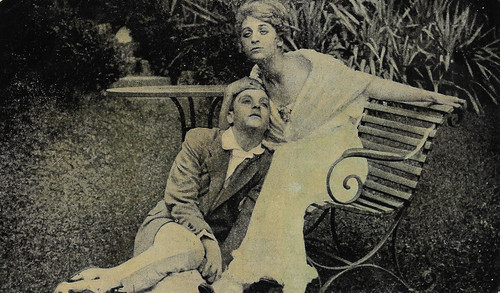
Spanish cromo by Chocolate Imperiale, no. 1 of 6. Photo: Sabaudo Film / J. Verdaguer. Diana Karenne and Umberto Casilini in Lea (Diana Karenne, Salvatore Aversano, 1916).
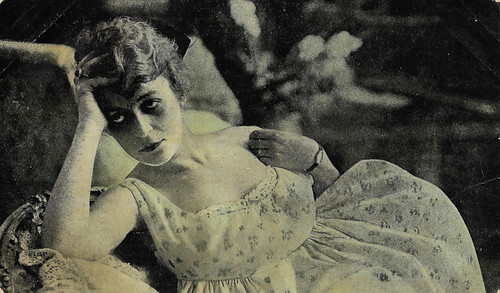
Spanish cromo by Chocolate Imperiale, no. 2 of 6. Photo: Sabaudo Film / J. Verdaguer. Diana Karenne in Lea (Diana Karenne, Salvatore Aversano, 1916).
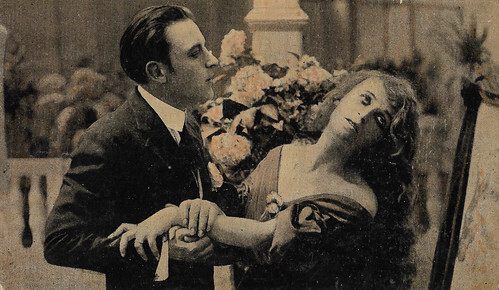
Spanish cromo by Chocolate Imperiale, no. 3 of 6. Photo: Sabaudo Film / J. Verdaguer. Diana Karenne and Umberto Casilini in Lea (Diana Karenne, Salvatore Aversano, 1916).
Lea ( Diana Karenne ) leaves her parents' home to marry the artist Riccardo (Umberto Casilini). She returns when she is warned her mother is ill, but she arrives too late. Her mother already died. Lea goes out of her mind and is locked up in a convent by her relatives.
After eight years, she is declared sane and looks for Riccardo. Yet, he was told she died, so he has remarried Ida (Alfonsina Pieri). Initially, Lea tries to claim her rights over the second wife, but when she discovers the latter has given Riccardo two children, she retreats into silence and forever.
Lea was officially directed by Diana Karenne herself, but Salvatore Aversano was her uncredited co-director. The film was based on an eponymous play (1888) by the radical writer Felice Cavallotti, adapted for the screen by director-screenwriter Guglielmo Zorzi. The plot shares a few similar elements with Dario Niccodemi's play 'L'ombra' (1915), which was filmed three times in the silent era including a 1923 version with Italia Almirante .
The cinematography of Lea was done by Carlo Montuori. Montuori was a long-standing operator and DOP in Italian cinema history, who started out at Comerio Film in 1907. He would be one of the most sought cinematographers of Italian sound cinema of the 1930s and 1940s, and, after the war, would shoot such classics as De Sica's films Ladri di biciclette/Bicycle Thieves (1948), L'oro di Napoli/The Gold of Naples (1954), and Il tetto/The Roof (1956).
The Turinese film journal La Vita Cinematografica praised the story and script of Lea but thought Karenne had overdone the number of close-ups of herself. Instead, the public success of Karenne's first film as a director inspired the founding in 1917 of the company David-Karenne Film, later named Karenne Film.
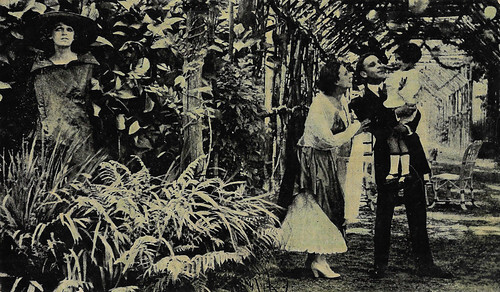
Spanish cromo by Chocolate Imperiale, no. 4 of 6. Photo: Sabaudo Film / J. Verdaguer. Diana Karenne (left), Alfonsina Pieri and Umberto Casilini in Lea (Diana Karenne, Salvatore Aversano, 1916).
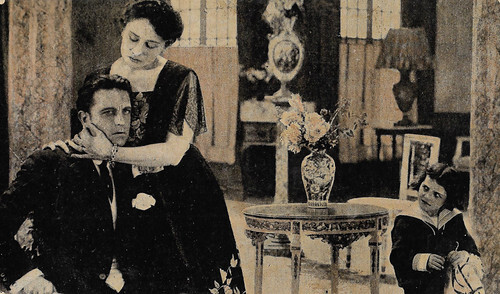
Spanish cromo by Chocolate Imperiale, no. 5 of 6. Photo: Sabaudo Film / J. Verdaguer. Possibly Umberto Casilini and Alfonsina Pieri in Lea (Diana Karenne, Salvatore Aversano, 1916). The two could also be Teresa Boetti-Valvassura (the Duchess) and Roberto Vilani (Duke of Baiamonte), as indeed Pieri seems to look different. The little boy could be a girl actress, Carmen Varriale, who plays little Peppino in the film.
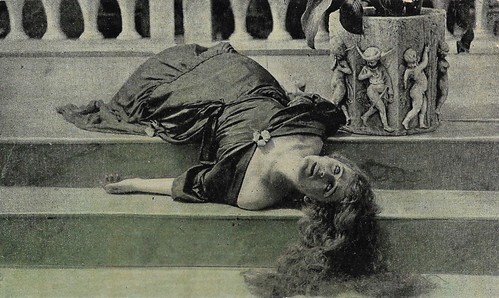
Spanish cromo by Chocolate Imperiale, no. 6 of 6. Photo: Sabaudo Film / J. Verdaguer. Diana Karenne in Lea (Diana Karenne, Salvatore Aversano, 1916).
Sofia di Kravonia (1916)
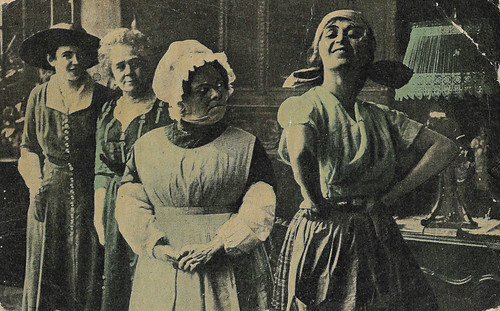
Spanish cromo by Chocolate Imperiale, no. 1 of 6. Photo: Pasquali / Vay Film / J. Verdaguer. Diana Karenne in Sofia di Kravonia (Ernesto Maria Pasquali, 1916).
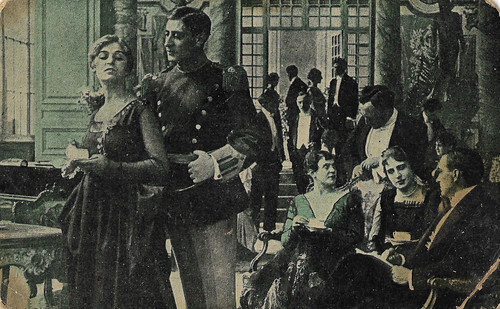
Spanish cromo by Chocolate Imperiale, no. 3 of 6. Photo: Pasquali / Vay Film / J. Verdaguer. Diana Karenne in Sofia di Kravonia (Ernesto Maria Pasquali, 1916).
After Lea,Diana Karenne went back to Pasquali Film to be directed in Sofia di Kravonia (1916). Sofia ( Diana Karenne ) is a poor orphan who is picked up by the Smiker couple and becomes their assistant cook, but at every new mischief of the rather unskilled assistant, the cook Teresa exclaims: I think they've sent Sofia as punishment for our sins. Ms. Zerkowich visits the Smikers and Sofia manages to get into her service.
Lieutenant Casimir de Savres meets her at Ms. Zerkowich and the young man falls in love with her, yet the king of Kravonia is in the middle of a war and Savres is called to arms. The King himself is quite old and ill. The Countess of Ellenburg (probably Mary-Cléo Tarlarini), the morganatic second wife of the king, thus plots to have her son Alexis ascend to the throne and orders her aid, captain Mistich, to kill the crown prince Sergio ( Angelo Ferrari ), the king's son from his first wife. Sofia herself meanwhile has become the widow of the lieutenant and is present at the court. By killing the hitman she prevents the assault on the crown prince, who then falls in love with her. The king out of gratitude promotes her to a baroness, to the great jealousy of the Countess, her new rival.
Alexis' mother must save the captain or else she herself may be compromised by her close relationship with him and to do so she resorts to the Minister of War. Meanwhile prince Sergio, at the head of his loyal mountain people, wants to obtain some canons at the Ministry, which the Minister uses to save the captain. "Your Highness, we will give the guns if you pardon captain Mistich", the Minister says to the prince. The latter disregards the offer and forcibly takes over the canons. The Royal court is in mourning, as the King has fallen victim to an apoplectic stroke, but the Countess of Ellenburg hides the death of the sovereign to the people and prepares a new disappearance of prince Sergio so that her son may ascend the throne.
Forced to lead her horse in a frenetic gallop through the fields, Sofia reunites with Sergio and informs him of the danger that awaits him in the capital, while meanwhile Mistich and his horsemen try to get hold of them so that Alexis of Ellenburg can be proclaimed heir to the throne. Yet, the mountain people led by Sergio and Sofia fight the horsemen and win. Still, Sergio is badly hurt which jeopardizes the victory. However, Sofia proves to have a real hero's heart, becomes colonel, and leads the small army to victory and into the capital, where she finally triumphs. One day after, the new sovereigns ascend to the throne: Sergio and Sofia.
Other actors in the film were Armand Pouget (who often played villains, so he may have been Mistich), Mario Cimarra, and Giusto Olivieri. The film premiered in Rome on 26 March 1917. While the critic of the northern (Turin-based) journal La Vita Cinematografica panned the film, the critic from the southern (Neapolitan) journal Film loved it, and so did the audience: the rapid, diverse and emotional action, the excellent exteriors and interiors, and Karenne's splendid and manly performance, in particular as the frenzied colonel.
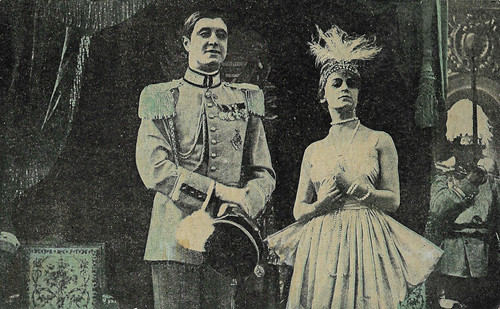
Spanish cromo by Chocolate Imperiale, no. 4 of 6. Photo: Pasquali / Vay Film / J. Verdaguer. Diana Karenne and Angelo Ferrari in Sofia di Kravonia (Ernesto Maria Pasquali, 1916).
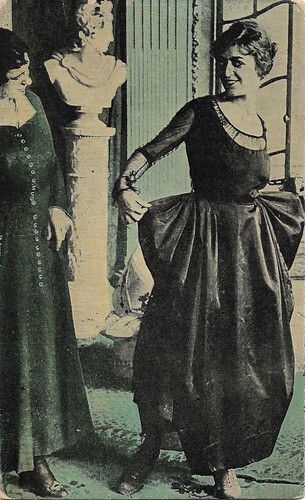
Spanish cromo by Chocolate Imperiale, no. 5 of 6. Photo: Pasquali / Vay Film / J. Verdaguer. Diana Karenne in Sofia di Kravonia (Ernesto Maria Pasquali, 1916). NB A copy of the head of the Apollo Belvedere in the background.
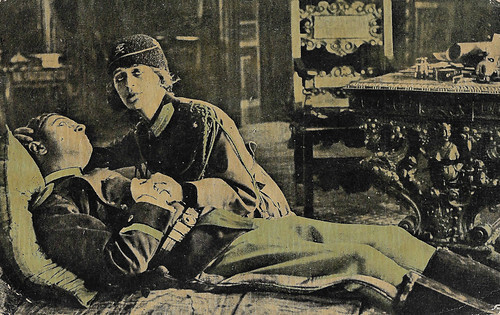
Spanish cromo by Chocolate Imperiale, no. 6 of 6. Photo: Pasquali / Vay Film / J. Verdaguer. Diana Karenne and Angelo Ferrari in Sofia di Kravonia (Ernesto Maria Pasquali, 1916).
La peccatrice casta (1919)
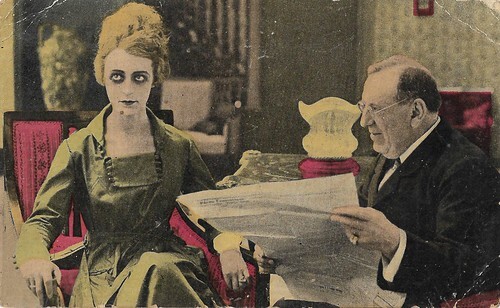
Spanish cromo by Chocolat Imperiale, Barcelona, no. 1 of 6. Photo: Tiber Film / Verdaguer. Diana Karenne in La peccatrice casta (Diana Karenne, Gennaro Righelli, 1919).
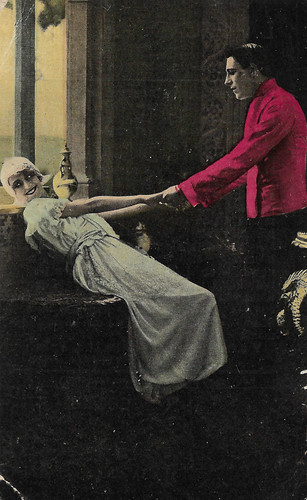
Spanish cromo by Chocolat Imperiale, Barcelona, no. 3 of 6. Photo: Tiber Film / Verdaguer. Diana Karenne and Alberto Pasquali in La peccatrice casta (Diana Karenne, Gennaro Righelli, 1919).
In 1918, Tiber Film, in Rome, launched, especially for her, the series 'Karenne Films'. This series included La peccatrice casta/The chaste sinner (Diana Karenne, Gennaro Righelli, 1919). In 1919, Karenne left Tiber Film already, probably because of some internal disagreement.
Wanda ( Diana Karenne ) is a popular dancer, but very ill. When she collapses during a performance, a count ( Alberto Pasquali ), comes to aid, falls in love with her, and wants to marry her.
Wanda accepts but after the wedding she starts dancing and her mundane life again, which she never could say goodbye to. She ends up falling for another man ( Mario Parpagnoli ), while her husband, after finding out, bitterly leaves for the US.
One year after, the husband returns and finds her alone, with a child, and left by her lover. He reunites with her, pardons her, and accepts the child too.
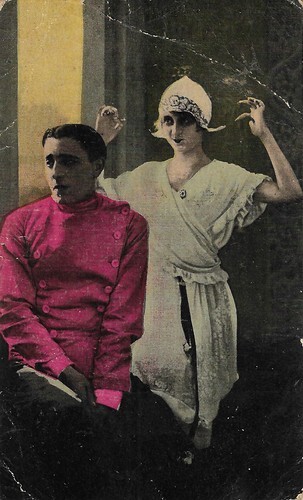
Spanish cromo by Chocolat Imperiale, Barcelona, no. 4 of 6. Photo: Tiber Film / Verdaguer. Diana Karenne and Alberto Pasquali in La peccatrice casta (Diana Karenne, Gennaro Righelli, 1919).
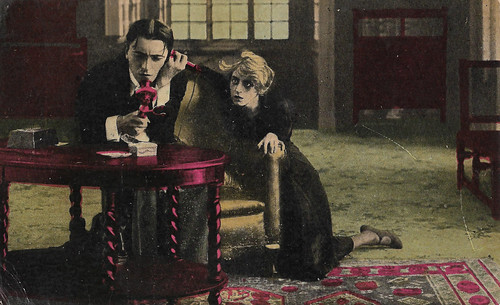
Spanish cromo by Chocolat Imperiale, Barcelona, no. 5 of 6. Photo: Tiber Film / Verdaguer. Diana Karenne and Alberto Pasquali in La peccatrice casta (Diana Karenne, Gennaro Righelli, 1919).
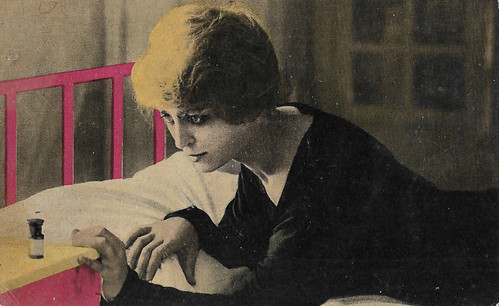
Spanish cromo by Chocolat Imperiale, Barcelona, no. 6 of 6. Photo: Tiber Film / Verdaguer. Diana Karenne in La peccatrice casta (Diana Karenne, Gennaro Righelli, 1919).
Sources: Vittorio Martinelli (Il cinema muto italiano, 1916, II), Cristina Jandelli and Linda Del Gamba (Women Film Pioneers Project), Wikipedia (Italian), and .
Lea (1916)

Spanish cromo by Chocolate Imperiale, no. 1 of 6. Photo: Sabaudo Film / J. Verdaguer. Diana Karenne and Umberto Casilini in Lea (Diana Karenne, Salvatore Aversano, 1916).

Spanish cromo by Chocolate Imperiale, no. 2 of 6. Photo: Sabaudo Film / J. Verdaguer. Diana Karenne in Lea (Diana Karenne, Salvatore Aversano, 1916).

Spanish cromo by Chocolate Imperiale, no. 3 of 6. Photo: Sabaudo Film / J. Verdaguer. Diana Karenne and Umberto Casilini in Lea (Diana Karenne, Salvatore Aversano, 1916).
Lea ( Diana Karenne ) leaves her parents' home to marry the artist Riccardo (Umberto Casilini). She returns when she is warned her mother is ill, but she arrives too late. Her mother already died. Lea goes out of her mind and is locked up in a convent by her relatives.
After eight years, she is declared sane and looks for Riccardo. Yet, he was told she died, so he has remarried Ida (Alfonsina Pieri). Initially, Lea tries to claim her rights over the second wife, but when she discovers the latter has given Riccardo two children, she retreats into silence and forever.
Lea was officially directed by Diana Karenne herself, but Salvatore Aversano was her uncredited co-director. The film was based on an eponymous play (1888) by the radical writer Felice Cavallotti, adapted for the screen by director-screenwriter Guglielmo Zorzi. The plot shares a few similar elements with Dario Niccodemi's play 'L'ombra' (1915), which was filmed three times in the silent era including a 1923 version with Italia Almirante .
The cinematography of Lea was done by Carlo Montuori. Montuori was a long-standing operator and DOP in Italian cinema history, who started out at Comerio Film in 1907. He would be one of the most sought cinematographers of Italian sound cinema of the 1930s and 1940s, and, after the war, would shoot such classics as De Sica's films Ladri di biciclette/Bicycle Thieves (1948), L'oro di Napoli/The Gold of Naples (1954), and Il tetto/The Roof (1956).
The Turinese film journal La Vita Cinematografica praised the story and script of Lea but thought Karenne had overdone the number of close-ups of herself. Instead, the public success of Karenne's first film as a director inspired the founding in 1917 of the company David-Karenne Film, later named Karenne Film.

Spanish cromo by Chocolate Imperiale, no. 4 of 6. Photo: Sabaudo Film / J. Verdaguer. Diana Karenne (left), Alfonsina Pieri and Umberto Casilini in Lea (Diana Karenne, Salvatore Aversano, 1916).

Spanish cromo by Chocolate Imperiale, no. 5 of 6. Photo: Sabaudo Film / J. Verdaguer. Possibly Umberto Casilini and Alfonsina Pieri in Lea (Diana Karenne, Salvatore Aversano, 1916). The two could also be Teresa Boetti-Valvassura (the Duchess) and Roberto Vilani (Duke of Baiamonte), as indeed Pieri seems to look different. The little boy could be a girl actress, Carmen Varriale, who plays little Peppino in the film.

Spanish cromo by Chocolate Imperiale, no. 6 of 6. Photo: Sabaudo Film / J. Verdaguer. Diana Karenne in Lea (Diana Karenne, Salvatore Aversano, 1916).
Sofia di Kravonia (1916)

Spanish cromo by Chocolate Imperiale, no. 1 of 6. Photo: Pasquali / Vay Film / J. Verdaguer. Diana Karenne in Sofia di Kravonia (Ernesto Maria Pasquali, 1916).

Spanish cromo by Chocolate Imperiale, no. 3 of 6. Photo: Pasquali / Vay Film / J. Verdaguer. Diana Karenne in Sofia di Kravonia (Ernesto Maria Pasquali, 1916).
After Lea,Diana Karenne went back to Pasquali Film to be directed in Sofia di Kravonia (1916). Sofia ( Diana Karenne ) is a poor orphan who is picked up by the Smiker couple and becomes their assistant cook, but at every new mischief of the rather unskilled assistant, the cook Teresa exclaims: I think they've sent Sofia as punishment for our sins. Ms. Zerkowich visits the Smikers and Sofia manages to get into her service.
Lieutenant Casimir de Savres meets her at Ms. Zerkowich and the young man falls in love with her, yet the king of Kravonia is in the middle of a war and Savres is called to arms. The King himself is quite old and ill. The Countess of Ellenburg (probably Mary-Cléo Tarlarini), the morganatic second wife of the king, thus plots to have her son Alexis ascend to the throne and orders her aid, captain Mistich, to kill the crown prince Sergio ( Angelo Ferrari ), the king's son from his first wife. Sofia herself meanwhile has become the widow of the lieutenant and is present at the court. By killing the hitman she prevents the assault on the crown prince, who then falls in love with her. The king out of gratitude promotes her to a baroness, to the great jealousy of the Countess, her new rival.
Alexis' mother must save the captain or else she herself may be compromised by her close relationship with him and to do so she resorts to the Minister of War. Meanwhile prince Sergio, at the head of his loyal mountain people, wants to obtain some canons at the Ministry, which the Minister uses to save the captain. "Your Highness, we will give the guns if you pardon captain Mistich", the Minister says to the prince. The latter disregards the offer and forcibly takes over the canons. The Royal court is in mourning, as the King has fallen victim to an apoplectic stroke, but the Countess of Ellenburg hides the death of the sovereign to the people and prepares a new disappearance of prince Sergio so that her son may ascend the throne.
Forced to lead her horse in a frenetic gallop through the fields, Sofia reunites with Sergio and informs him of the danger that awaits him in the capital, while meanwhile Mistich and his horsemen try to get hold of them so that Alexis of Ellenburg can be proclaimed heir to the throne. Yet, the mountain people led by Sergio and Sofia fight the horsemen and win. Still, Sergio is badly hurt which jeopardizes the victory. However, Sofia proves to have a real hero's heart, becomes colonel, and leads the small army to victory and into the capital, where she finally triumphs. One day after, the new sovereigns ascend to the throne: Sergio and Sofia.
Other actors in the film were Armand Pouget (who often played villains, so he may have been Mistich), Mario Cimarra, and Giusto Olivieri. The film premiered in Rome on 26 March 1917. While the critic of the northern (Turin-based) journal La Vita Cinematografica panned the film, the critic from the southern (Neapolitan) journal Film loved it, and so did the audience: the rapid, diverse and emotional action, the excellent exteriors and interiors, and Karenne's splendid and manly performance, in particular as the frenzied colonel.

Spanish cromo by Chocolate Imperiale, no. 4 of 6. Photo: Pasquali / Vay Film / J. Verdaguer. Diana Karenne and Angelo Ferrari in Sofia di Kravonia (Ernesto Maria Pasquali, 1916).

Spanish cromo by Chocolate Imperiale, no. 5 of 6. Photo: Pasquali / Vay Film / J. Verdaguer. Diana Karenne in Sofia di Kravonia (Ernesto Maria Pasquali, 1916). NB A copy of the head of the Apollo Belvedere in the background.

Spanish cromo by Chocolate Imperiale, no. 6 of 6. Photo: Pasquali / Vay Film / J. Verdaguer. Diana Karenne and Angelo Ferrari in Sofia di Kravonia (Ernesto Maria Pasquali, 1916).
La peccatrice casta (1919)

Spanish cromo by Chocolat Imperiale, Barcelona, no. 1 of 6. Photo: Tiber Film / Verdaguer. Diana Karenne in La peccatrice casta (Diana Karenne, Gennaro Righelli, 1919).

Spanish cromo by Chocolat Imperiale, Barcelona, no. 3 of 6. Photo: Tiber Film / Verdaguer. Diana Karenne and Alberto Pasquali in La peccatrice casta (Diana Karenne, Gennaro Righelli, 1919).
In 1918, Tiber Film, in Rome, launched, especially for her, the series 'Karenne Films'. This series included La peccatrice casta/The chaste sinner (Diana Karenne, Gennaro Righelli, 1919). In 1919, Karenne left Tiber Film already, probably because of some internal disagreement.
Wanda ( Diana Karenne ) is a popular dancer, but very ill. When she collapses during a performance, a count ( Alberto Pasquali ), comes to aid, falls in love with her, and wants to marry her.
Wanda accepts but after the wedding she starts dancing and her mundane life again, which she never could say goodbye to. She ends up falling for another man ( Mario Parpagnoli ), while her husband, after finding out, bitterly leaves for the US.
One year after, the husband returns and finds her alone, with a child, and left by her lover. He reunites with her, pardons her, and accepts the child too.

Spanish cromo by Chocolat Imperiale, Barcelona, no. 4 of 6. Photo: Tiber Film / Verdaguer. Diana Karenne and Alberto Pasquali in La peccatrice casta (Diana Karenne, Gennaro Righelli, 1919).

Spanish cromo by Chocolat Imperiale, Barcelona, no. 5 of 6. Photo: Tiber Film / Verdaguer. Diana Karenne and Alberto Pasquali in La peccatrice casta (Diana Karenne, Gennaro Righelli, 1919).

Spanish cromo by Chocolat Imperiale, Barcelona, no. 6 of 6. Photo: Tiber Film / Verdaguer. Diana Karenne in La peccatrice casta (Diana Karenne, Gennaro Righelli, 1919).
Sources: Vittorio Martinelli (Il cinema muto italiano, 1916, II), Cristina Jandelli and Linda Del Gamba (Women Film Pioneers Project), Wikipedia (Italian), and .
Published on December 21, 2021 22:00
December 20, 2021
Harrison Ford
American film actor Harrison Ford (1942) specialises in roles of cynical, world-weary heroes in popular film series. He played Han Solo in the Star Wars franchise, archaeologist Indiana Jones in a series of four adventure films, Rick Deckard in the Science Fiction films Blade Runner (1982) and Blade Runner 2049 (2017), and secret agent Jack Ryan in the spy thrillers Patriot Games (1992) and Clear and Present Danger (1994). These film roles have made him one of the most successful stars in Hollywood. In all, his films have grossed about $5.4 billion in the United States and $9.3 billion worldwide.
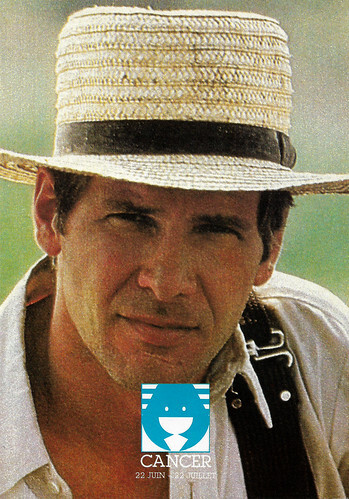
French postcard by Editions F. Nugeron in the Signes du zodiaque series, no. 17. Harrison Ford - Cancer. Photo: Harrison Ford in Witness (Peter Weir, 1985).
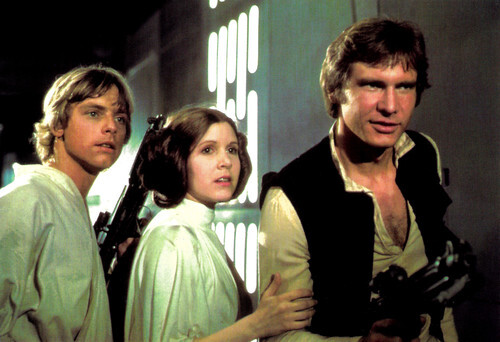
American postcard by Classico San Francisco, no. 105-527. Photo: Lucasfilm Ltd. Harrison Ford, Carrie Fisher and Mark Hamill in Star Wars - Episode IV - A New Hope (George Lucas, 1977). Caption: Luke Skywalker, Princess Leia and Han Solo.
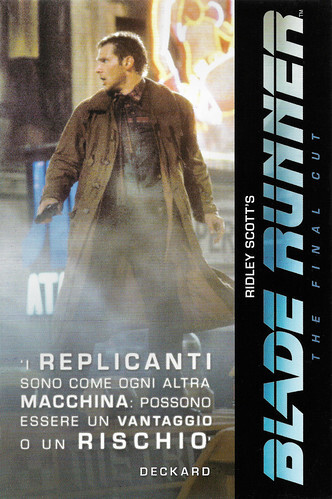
Italian postcard. Photo: Warner Bros. Harrison Ford in Blade Runner - The Final Cut (Ridley Scott, 1981). In 2007, Ridley Scott released Blade Runner: The Final Cut, digitally remastered with improved visual and sound effects, and with numerous revisions to the 1992 Director's Cut. Caption: 'Replicants are like any other machine: they can be an advantage or a risk', Deckard.
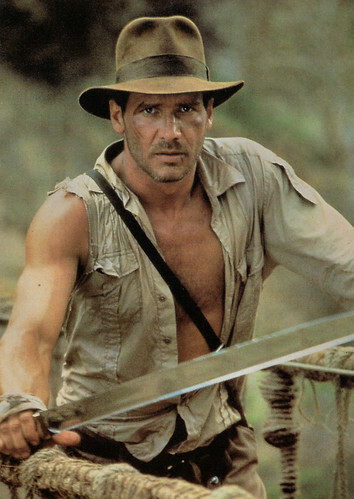
West-German postcard by G. Barth, Frankfurt, no. GB 69. Photo: Lucasfilm Ltd. Harrison Ford in Indiana Jones and the Temple of Doom (Steven Spielberg, 1984).
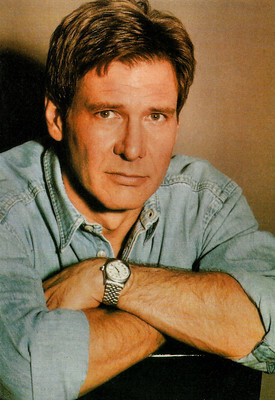
French postcard, Ref. 973.
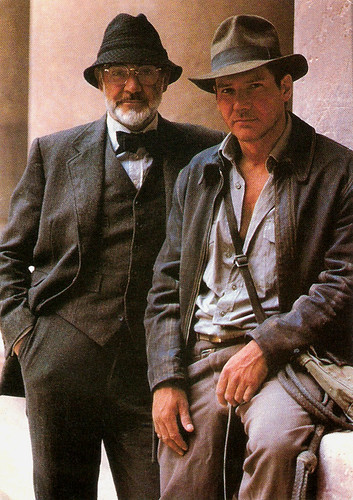
French postcard by Editions Nugeron, no. Star 206. Photo: Lucasfilm. Publicity still for Indiana Jones and the Last Crusade (Steven Spielberg, 1989).
One of the most successful and groundbreaking films of all time
Harrison Ford was born in Chicago, Illinois, in 1942. His parents were former radio actress Dorothy (née Nidelman) and the advertising executive and former actor John William "Christopher" Ford.
Harrison graduated in 1960 from Maine East High School in Park Ridge, Illinois. His voice was the first student voice broadcast on his high school's new radio station, WMTH, and he was its first sportscaster during his senior year. He attended Ripon College in Ripon, Wisconsin, where he was a philosophy major and did some acting.
After dropping out of college, he first wanted to work as a DJ in radio and left for California to work at a large national radio station. He was unable to find work and, in order to make a living, he accepted a job as a carpenter. Another part-time job was auditioning, where he had to read out lines that the opposing actor would say to an actor auditioning for a particular role. Harrison did this so well that he was advised to take up acting.
He was also briefly a roadie for the rock group The Doors. From 1964, Ford regularly played bit roles in films. He was finally credited as "Harrison J. Ford" in the Western A Time for Killing (Phil Karlson, 1967), starring Glenn Ford , George Hamilton, and Inger Stevens. The "J" did not stand for anything since he has no middle name but was added to avoid confusion with a silent film actor named Harrison Ford, who appeared in more than 80 films between 1915 and 1932 and died in 1957.
French filmmaker Jacques Demy chose Ford for the lead role of his first American film, Model Shop (1969), but the head of Columbia Pictures thought Ford had "no future" in the film business and told Demy to hire a more experienced actor. The part eventually went to Gary Lockwood.
He had an uncredited, non-speaking role in Michelangelo Antonioni's film Zabriskie Point (1970) as an arrested student protester. His first major role was in the coming-of-age comedy American Graffiti (George Lucas, 1973). Ford became friends with the directors George Lucas and Francis Ford Coppola, and he made a number of films with them. In 1974, he acted in The Conversation (Francis Ford Coppola, 1974) starring Gene Hackman, and played an army officer named "G. Lucas" in Apocalypse Now (Francis Ford Coppola, 1979, co-produced by George Lucas.
Ford made his breakthrough as Han Solo in Lucas's epic space opera Star Wars: Episode IV: A New Hope (George Lucas, 1977). Star Wars became one of the most successful and groundbreaking films of all time and brought Ford, and his co-stars Mark Hamill and Carrie Fisher, widespread recognition. He reprised the role in four sequels over the course of the next 42 years: Star Wars: Episode V: The Empire Strikes Back (Irvin Kershner, 1980), Star Wars: Episode VI: Return of the Jedi (Richard Marquand, 1983), Star Wars: Episode VII: The Force Awakens (J. J. Abrams, 2015), and Star Wars: Episode IX: The Rise of Skywalker (J.J. Abrams, 2019).

French postcard by Studio Erving, Paris, no. 696. Photo: Lucasfilm Ltd. Harrison Ford in Star Wars - Episode IV - A New Hope (George Lucas, 1977).
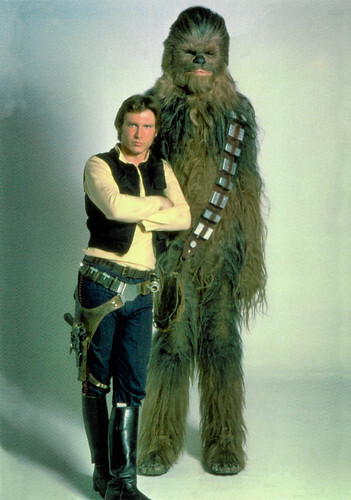
West-German postcard by Filmwelt Berlin, Bad Münder, no. SW 4.082, 1997. Photo: Lucasfilm Ltd. Harrison Ford and Peter Mayhew in Star Wars - Episode IV - A New Hope (George Lucas, 1977).

West-German postcard by Filmwelt Berlin, Bad Münder, no. SW 4.039, 1995. Photo: Lucasfilm Ltd. Harrison Ford in Star Wars - Episode IV - A New Hope (George Lucas, 1977).
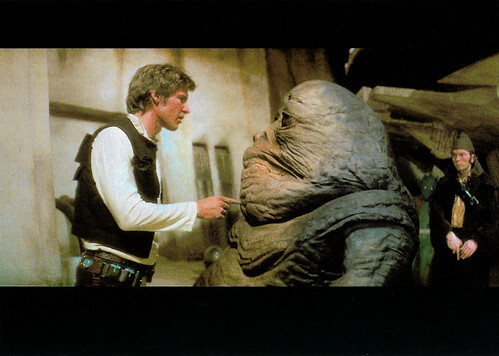
West-German postcard by Filmwelt Berlin, Bad Münder, no. SW 0.0226, 1997. Photo: Lucasfilm Ltd. Harrison Ford in Star Wars - Episode IV - A New Hope (George Lucas, 1977).
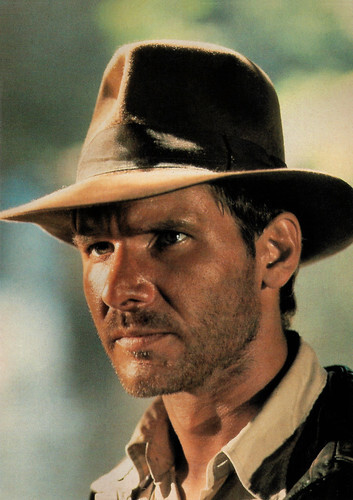
West-German postcard by G. Barth, Frankfurt, no. GB 66. Photo: Lucasfilm Ltd. Harrison Ford in Raiders of the Lost Ark (Steven Spielberg, 1981).
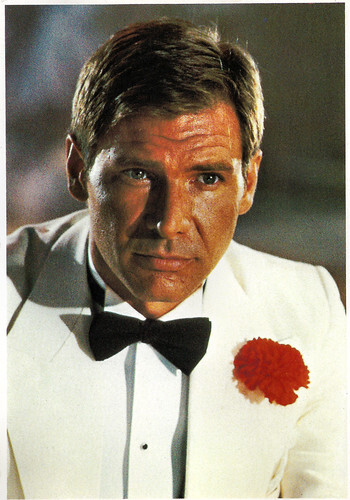
British postcard by Santoro Graphics, London, no C212. Photo: Lucasfilm Ltd., 1984. Harrison Ford as Indiana Jones in Indiana Jones and the Temple of Doom (Steven Spielberg, 1984).
A heroic, globe-trotting archaeologist
Harrison Ford also worked with George Lucas and Steven Spielberg on the successful Indiana Jones adventure series playing the heroic, globe-trotting archaeologist Indiana Jones. The series started with the action-adventure film Raiders of the Lost Ark (Steven Spielberg, 1981). Like Star Wars, the film was massively successful and became the highest-grossing film of the year.
Ford went on to reprise the role throughout the rest of the decade in the prequel Indiana Jones and the Temple of Doom (Steven Spielberg, 1984), and the sequel Indiana Jones and the Last Crusade (Steven Spielberg, 1989), which co-starred Sean Connery as Indy's father, Henry Jones Sr. and River Phoenix as young Indiana.
In between the successful film series, Ford also played very daring roles in more artistic films. He played the role of a lonely depressed detective in the Sci-Fi film Blade Runner, (Ridley Scott, 1981) opposite Rutger Hauer . While not initially a success, Blade Runner went on to become a cult classic and one of Ford's most highly regarded films. Ford received an Oscar nomination for Best Actor for the crime drama Witness (Peter Weir, 1985) with Kelly McGillis, and also starred for Weir as a house-father in the survival drama The Mosquito Coast (Peter Weir, 1986) with River Phoenix as his son.
In 1988, he played a desperate man searching for his kidnapped wife in Roman Polanski's Frantic. For his role as a wrongly accused prisoner Dr. Richard Kimble in the action thriller The Fugitive (Andrew Davis, 1993), also starring Tommy Lee Jones , Ford received some of the best reviews of his career. He became the second of five actors to portray Jack Ryan in two films of the film series based on the literary character created by Tom Clancy: the spy thrillers Patriot Games (Phillip Noyce, 1992) and Clear and Present Danger (Phillip Noyce, 1994).
He then played the American president in the blockbuster Air Force One (Wolfgang Petersen, 1997) opposite Gary Oldman . Later his success waned somewhat and his films Random Hearts (Sydney Pollack, 1999) and Six Days Seven Nights (Ivan Reitman, 1998) both disappointed at the box office. However, he did play a few special roles, such as an assassin in the supernatural horror-thriller What Lies Beneath (Robert Zemeckis, 2000) opposite Michele Pfeiffer , and a Russian submarine captain in K-19: The Widowmaker (Kathryn Bigelow, 2002) with Liam Neeson.
In 2008, he reprised his role as Indiana Jones in Indiana Jones and the Kingdom of the Crystal Skull (Steven Spielberg, 2008) with Cate Blanchett. The film received generally positive reviews and was the second highest-grossing film worldwide in 2008. Later Ford accepted more supporting roles, such as in the sports film 42 (Brian Helgeland, 2013) about baseball player Jackie Robinson (Chadwick Boseman), the first black athlete to play in Major League Baseball.
Ford reprised the role of Han Solo in the long-awaited Star Wars sequel Star Wars: The Force Awakens (J.J. Abrams, 2015), which became massively successful like its predecessors. He also reprised his role as Rick Deckard in Blade Runner 2049 (Denis Villeneuve, 2017), co-starring Ryan Gosling.
Harrison Ford has been married three times and has four biological children and one adopted child. From 1964 to 1979, Ford was married to Mary Marquardt, a marriage that produced two children. From 1983 to 2003, he was married to Melissa Mathison, from which marriage two more children were born. In 2010, he married actress Calista Flockhart, famous for her role in the TV series Ally McBeal. He owns a ranch in Jackson Hole (Wyoming).
Besides being an actor, Ford is also an experienced pilot. Ford survived three plane crashes of planes he piloted himself. The most recent accident occurred in 2015 when he suffered an engine failure with a Ryan PT-22 Recruit and made an emergency landing on a golf course. Among other injuries, Ford sustained a broken pelvis and ankle from this latest accident. In 2003, he received a star on the Hollywood Walk of Fame.
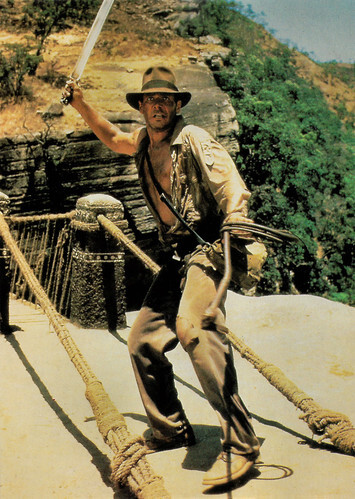
West-German postcard by G. Barth, Frankfurt, no. GB 60. Photo: Lucasfilm Ltd. Harrison Ford in Indiana Jones and the Temple of Doom (Steven Spielberg, 1984).
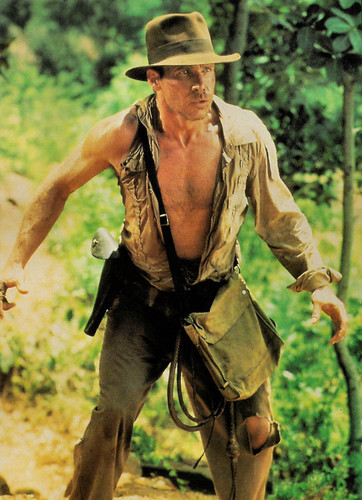
West-German postcard by G. Barth, Frankfurt, no. GB 64. Photo: Lucasfilm Ltd. Harrison Ford in Indiana Jones and the Temple of Doom (Steven Spielberg, 1984).
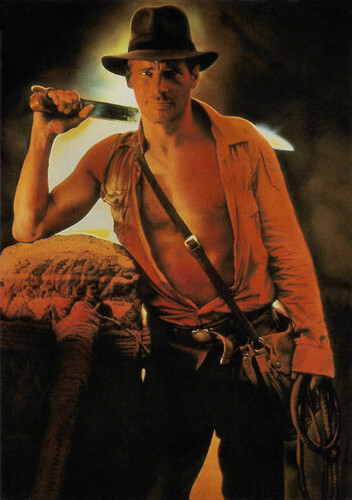
West-German postcard by G. Barth, Frankfurt, no. GB 65. Photo: Lucasfilm Ltd. Harrison Ford in Indiana Jones and the Temple of Doom (Steven Spielberg, 1984).
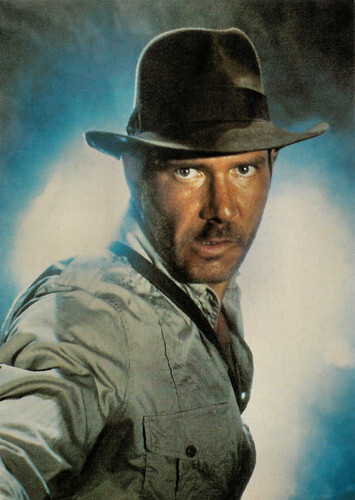
West-German postcard by G. Barth, Frankfurt, no. GB 67. Photo: Lucasfilm Ltd. Harrison Ford in Indiana Jones and the Temple of Doom (Steven Spielberg, 1984).
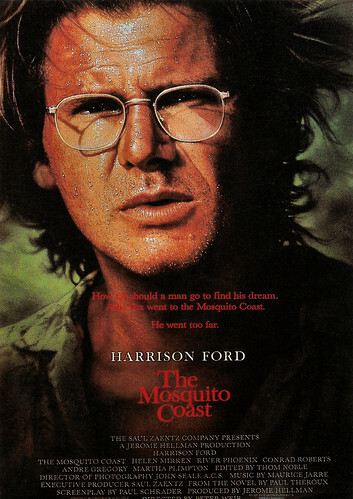
French postcard by Editions F. Nugeron, no. E 404. Image: film poster for The Mosquito Coast (Peter Weir, 1986) with Harrison Ford.
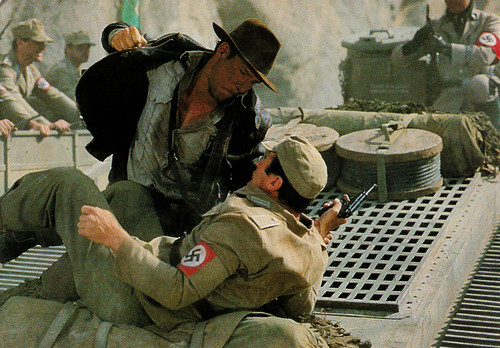
French postcard by Editions Nugeron, no. Star 194. Photo: Lucasfilm Ltd. Harrison Ford in Indiana Jones and the Last Crusade (Steven Spielberg, 1989).
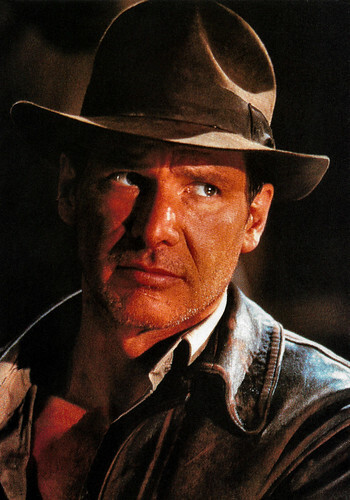
French postcard by Editions Nugeron, no. Star 195. Photo: Lucasfilm Ltd. Harrison Ford in Indiana Jones and the Last Cruisade (Steven Spielberg, 1989).
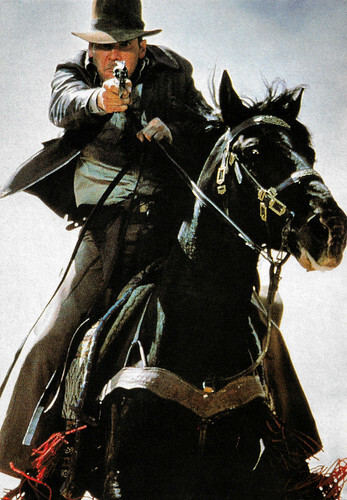
French postcard by Editions Nugeron, no. Star 196. Photo: Lucasfilm Ltd. Harrison Ford in Indiana Jones and the Last Cruisade (Steven Spielberg, 1989).
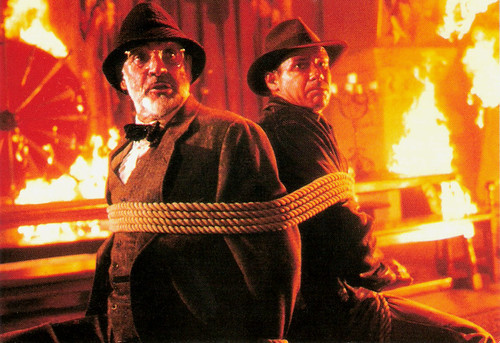
French postcard by Editions Nugeron, no. 198. Photo: Lucasfilm. Sean Connery and Harrison Ford in Indiana Jones and the Last Crusade (Steven Spielberg, 1989).
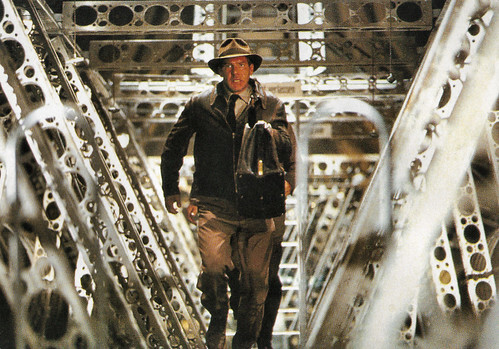
French postcard by Editions Nugeron, no. Star 199. Photo: Lucasfilm Ltd. Harrison Ford in Indiana Jones and the Last Crusade (Steven Spielberg, 1989).
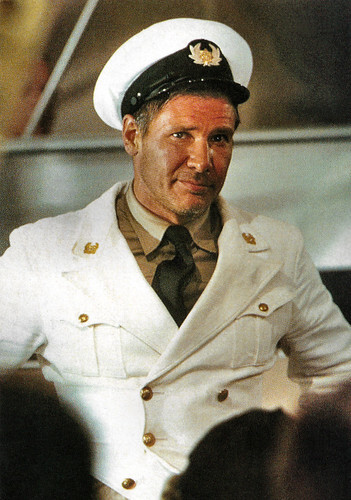
French postcard by Editions Nugeron, no. Star 202. Photo: Lucasfilm Ltd. Harrison Ford in Indiana Jones and the Last Cruisade (Steven Spielberg, 1989).
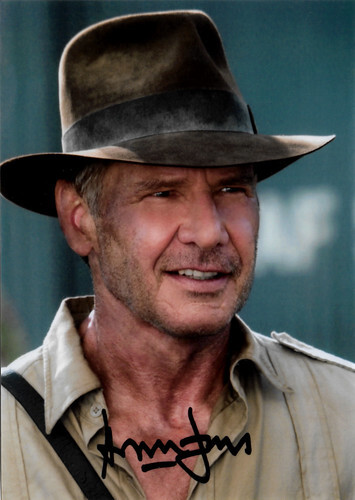
Vintage photo with autograph. Harrison Ford in Indiana Jones and the Kingdom of the Crystal Skull (Steven Spielberg, 2008).
Sources: Wikipedia (Dutch and English), and .

French postcard by Editions F. Nugeron in the Signes du zodiaque series, no. 17. Harrison Ford - Cancer. Photo: Harrison Ford in Witness (Peter Weir, 1985).

American postcard by Classico San Francisco, no. 105-527. Photo: Lucasfilm Ltd. Harrison Ford, Carrie Fisher and Mark Hamill in Star Wars - Episode IV - A New Hope (George Lucas, 1977). Caption: Luke Skywalker, Princess Leia and Han Solo.

Italian postcard. Photo: Warner Bros. Harrison Ford in Blade Runner - The Final Cut (Ridley Scott, 1981). In 2007, Ridley Scott released Blade Runner: The Final Cut, digitally remastered with improved visual and sound effects, and with numerous revisions to the 1992 Director's Cut. Caption: 'Replicants are like any other machine: they can be an advantage or a risk', Deckard.

West-German postcard by G. Barth, Frankfurt, no. GB 69. Photo: Lucasfilm Ltd. Harrison Ford in Indiana Jones and the Temple of Doom (Steven Spielberg, 1984).

French postcard, Ref. 973.

French postcard by Editions Nugeron, no. Star 206. Photo: Lucasfilm. Publicity still for Indiana Jones and the Last Crusade (Steven Spielberg, 1989).
One of the most successful and groundbreaking films of all time
Harrison Ford was born in Chicago, Illinois, in 1942. His parents were former radio actress Dorothy (née Nidelman) and the advertising executive and former actor John William "Christopher" Ford.
Harrison graduated in 1960 from Maine East High School in Park Ridge, Illinois. His voice was the first student voice broadcast on his high school's new radio station, WMTH, and he was its first sportscaster during his senior year. He attended Ripon College in Ripon, Wisconsin, where he was a philosophy major and did some acting.
After dropping out of college, he first wanted to work as a DJ in radio and left for California to work at a large national radio station. He was unable to find work and, in order to make a living, he accepted a job as a carpenter. Another part-time job was auditioning, where he had to read out lines that the opposing actor would say to an actor auditioning for a particular role. Harrison did this so well that he was advised to take up acting.
He was also briefly a roadie for the rock group The Doors. From 1964, Ford regularly played bit roles in films. He was finally credited as "Harrison J. Ford" in the Western A Time for Killing (Phil Karlson, 1967), starring Glenn Ford , George Hamilton, and Inger Stevens. The "J" did not stand for anything since he has no middle name but was added to avoid confusion with a silent film actor named Harrison Ford, who appeared in more than 80 films between 1915 and 1932 and died in 1957.
French filmmaker Jacques Demy chose Ford for the lead role of his first American film, Model Shop (1969), but the head of Columbia Pictures thought Ford had "no future" in the film business and told Demy to hire a more experienced actor. The part eventually went to Gary Lockwood.
He had an uncredited, non-speaking role in Michelangelo Antonioni's film Zabriskie Point (1970) as an arrested student protester. His first major role was in the coming-of-age comedy American Graffiti (George Lucas, 1973). Ford became friends with the directors George Lucas and Francis Ford Coppola, and he made a number of films with them. In 1974, he acted in The Conversation (Francis Ford Coppola, 1974) starring Gene Hackman, and played an army officer named "G. Lucas" in Apocalypse Now (Francis Ford Coppola, 1979, co-produced by George Lucas.
Ford made his breakthrough as Han Solo in Lucas's epic space opera Star Wars: Episode IV: A New Hope (George Lucas, 1977). Star Wars became one of the most successful and groundbreaking films of all time and brought Ford, and his co-stars Mark Hamill and Carrie Fisher, widespread recognition. He reprised the role in four sequels over the course of the next 42 years: Star Wars: Episode V: The Empire Strikes Back (Irvin Kershner, 1980), Star Wars: Episode VI: Return of the Jedi (Richard Marquand, 1983), Star Wars: Episode VII: The Force Awakens (J. J. Abrams, 2015), and Star Wars: Episode IX: The Rise of Skywalker (J.J. Abrams, 2019).

French postcard by Studio Erving, Paris, no. 696. Photo: Lucasfilm Ltd. Harrison Ford in Star Wars - Episode IV - A New Hope (George Lucas, 1977).

West-German postcard by Filmwelt Berlin, Bad Münder, no. SW 4.082, 1997. Photo: Lucasfilm Ltd. Harrison Ford and Peter Mayhew in Star Wars - Episode IV - A New Hope (George Lucas, 1977).

West-German postcard by Filmwelt Berlin, Bad Münder, no. SW 4.039, 1995. Photo: Lucasfilm Ltd. Harrison Ford in Star Wars - Episode IV - A New Hope (George Lucas, 1977).

West-German postcard by Filmwelt Berlin, Bad Münder, no. SW 0.0226, 1997. Photo: Lucasfilm Ltd. Harrison Ford in Star Wars - Episode IV - A New Hope (George Lucas, 1977).

West-German postcard by G. Barth, Frankfurt, no. GB 66. Photo: Lucasfilm Ltd. Harrison Ford in Raiders of the Lost Ark (Steven Spielberg, 1981).

British postcard by Santoro Graphics, London, no C212. Photo: Lucasfilm Ltd., 1984. Harrison Ford as Indiana Jones in Indiana Jones and the Temple of Doom (Steven Spielberg, 1984).
A heroic, globe-trotting archaeologist
Harrison Ford also worked with George Lucas and Steven Spielberg on the successful Indiana Jones adventure series playing the heroic, globe-trotting archaeologist Indiana Jones. The series started with the action-adventure film Raiders of the Lost Ark (Steven Spielberg, 1981). Like Star Wars, the film was massively successful and became the highest-grossing film of the year.
Ford went on to reprise the role throughout the rest of the decade in the prequel Indiana Jones and the Temple of Doom (Steven Spielberg, 1984), and the sequel Indiana Jones and the Last Crusade (Steven Spielberg, 1989), which co-starred Sean Connery as Indy's father, Henry Jones Sr. and River Phoenix as young Indiana.
In between the successful film series, Ford also played very daring roles in more artistic films. He played the role of a lonely depressed detective in the Sci-Fi film Blade Runner, (Ridley Scott, 1981) opposite Rutger Hauer . While not initially a success, Blade Runner went on to become a cult classic and one of Ford's most highly regarded films. Ford received an Oscar nomination for Best Actor for the crime drama Witness (Peter Weir, 1985) with Kelly McGillis, and also starred for Weir as a house-father in the survival drama The Mosquito Coast (Peter Weir, 1986) with River Phoenix as his son.
In 1988, he played a desperate man searching for his kidnapped wife in Roman Polanski's Frantic. For his role as a wrongly accused prisoner Dr. Richard Kimble in the action thriller The Fugitive (Andrew Davis, 1993), also starring Tommy Lee Jones , Ford received some of the best reviews of his career. He became the second of five actors to portray Jack Ryan in two films of the film series based on the literary character created by Tom Clancy: the spy thrillers Patriot Games (Phillip Noyce, 1992) and Clear and Present Danger (Phillip Noyce, 1994).
He then played the American president in the blockbuster Air Force One (Wolfgang Petersen, 1997) opposite Gary Oldman . Later his success waned somewhat and his films Random Hearts (Sydney Pollack, 1999) and Six Days Seven Nights (Ivan Reitman, 1998) both disappointed at the box office. However, he did play a few special roles, such as an assassin in the supernatural horror-thriller What Lies Beneath (Robert Zemeckis, 2000) opposite Michele Pfeiffer , and a Russian submarine captain in K-19: The Widowmaker (Kathryn Bigelow, 2002) with Liam Neeson.
In 2008, he reprised his role as Indiana Jones in Indiana Jones and the Kingdom of the Crystal Skull (Steven Spielberg, 2008) with Cate Blanchett. The film received generally positive reviews and was the second highest-grossing film worldwide in 2008. Later Ford accepted more supporting roles, such as in the sports film 42 (Brian Helgeland, 2013) about baseball player Jackie Robinson (Chadwick Boseman), the first black athlete to play in Major League Baseball.
Ford reprised the role of Han Solo in the long-awaited Star Wars sequel Star Wars: The Force Awakens (J.J. Abrams, 2015), which became massively successful like its predecessors. He also reprised his role as Rick Deckard in Blade Runner 2049 (Denis Villeneuve, 2017), co-starring Ryan Gosling.
Harrison Ford has been married three times and has four biological children and one adopted child. From 1964 to 1979, Ford was married to Mary Marquardt, a marriage that produced two children. From 1983 to 2003, he was married to Melissa Mathison, from which marriage two more children were born. In 2010, he married actress Calista Flockhart, famous for her role in the TV series Ally McBeal. He owns a ranch in Jackson Hole (Wyoming).
Besides being an actor, Ford is also an experienced pilot. Ford survived three plane crashes of planes he piloted himself. The most recent accident occurred in 2015 when he suffered an engine failure with a Ryan PT-22 Recruit and made an emergency landing on a golf course. Among other injuries, Ford sustained a broken pelvis and ankle from this latest accident. In 2003, he received a star on the Hollywood Walk of Fame.

West-German postcard by G. Barth, Frankfurt, no. GB 60. Photo: Lucasfilm Ltd. Harrison Ford in Indiana Jones and the Temple of Doom (Steven Spielberg, 1984).

West-German postcard by G. Barth, Frankfurt, no. GB 64. Photo: Lucasfilm Ltd. Harrison Ford in Indiana Jones and the Temple of Doom (Steven Spielberg, 1984).

West-German postcard by G. Barth, Frankfurt, no. GB 65. Photo: Lucasfilm Ltd. Harrison Ford in Indiana Jones and the Temple of Doom (Steven Spielberg, 1984).

West-German postcard by G. Barth, Frankfurt, no. GB 67. Photo: Lucasfilm Ltd. Harrison Ford in Indiana Jones and the Temple of Doom (Steven Spielberg, 1984).

French postcard by Editions F. Nugeron, no. E 404. Image: film poster for The Mosquito Coast (Peter Weir, 1986) with Harrison Ford.

French postcard by Editions Nugeron, no. Star 194. Photo: Lucasfilm Ltd. Harrison Ford in Indiana Jones and the Last Crusade (Steven Spielberg, 1989).

French postcard by Editions Nugeron, no. Star 195. Photo: Lucasfilm Ltd. Harrison Ford in Indiana Jones and the Last Cruisade (Steven Spielberg, 1989).

French postcard by Editions Nugeron, no. Star 196. Photo: Lucasfilm Ltd. Harrison Ford in Indiana Jones and the Last Cruisade (Steven Spielberg, 1989).

French postcard by Editions Nugeron, no. 198. Photo: Lucasfilm. Sean Connery and Harrison Ford in Indiana Jones and the Last Crusade (Steven Spielberg, 1989).

French postcard by Editions Nugeron, no. Star 199. Photo: Lucasfilm Ltd. Harrison Ford in Indiana Jones and the Last Crusade (Steven Spielberg, 1989).

French postcard by Editions Nugeron, no. Star 202. Photo: Lucasfilm Ltd. Harrison Ford in Indiana Jones and the Last Cruisade (Steven Spielberg, 1989).

Vintage photo with autograph. Harrison Ford in Indiana Jones and the Kingdom of the Crystal Skull (Steven Spielberg, 2008).
Sources: Wikipedia (Dutch and English), and .
Published on December 20, 2021 22:00
December 19, 2021
Published by News Productions
News Productions in Baulmes, Switzerland, was a publisher of many stylish black and white postcards with classic film scenes, set photos, and mesmerising star portraits by such photographers as Sam Shaw, Larry Shaw, and Laurence Sudre. The company, led by photographer Armand Deriaz, operated during the 1980s and 1990s. Many of the portrait postcards were published for Musée de l'Elysée in Lausanne and the photos probably are in the collection of this museum. The film stills often came from the collections of the Cinémathèque Suisse in Lausanne and the Cinemathèque française in Paris. News Productions also worked together with the German publisher Filmwelt Berlin which was located in Bakede and with CVB Productions. For a while, News Productions had an annex in Stroud in Great Britain. The company went bankrupt in 2004.

Swiss postcard by News Productions, Baulmes, no. 55087. Photo: John Phillips / Musée de l'Elysée, Lausanne. Roberto Rossellini on the set of Viva l'Italia/Garibaldi (Roberto Rossellini, 1961). Caption: Italy, Sicily, 1960. Neo-realist film director, Roberto Rossellini shooting on location 'Viva L'Italia'.

Swiss postcard by Musée de l'Elysée, Lausanne / News Productions, Baulmes, no. 55108. Photo: Michelangelo Durazzo / AMA, Paris. Federico Fellini directing a scene of the film 8½ (1963).

Swiss postcard by News Productions, Baulmes, no. 55207. Photo: Sam Tata. Caption: Buster Keaton , Montreal, 1964. In Canada, Buster Keaton played in the short film The Railrodder (Gerald Potterton, 1965), which Keaton uncredited co-directed.
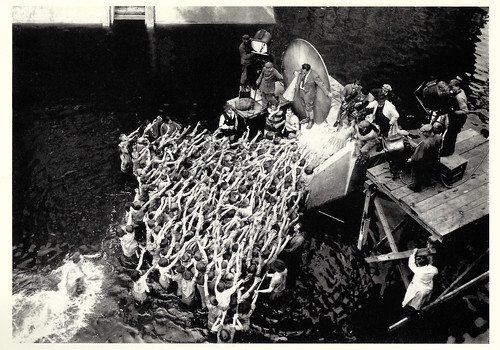
Swiss postcard by Musée de l'Elysée, Lausanne / News Productions, Baulmes, no. 55458. Photo: Horst von Harbou / Collection de la Cinemathèque française, Paris. Caption: Fritz Lang during the shooting of Metropolis, 1926.
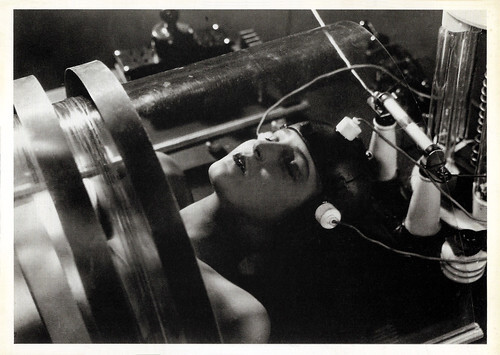
Swiss postcard by Musée de l'Elysée, Lausanne / News Productions, Baulmes, no. 55459. Photo: Horst von Harbou, 1926 / Collection de la Cinemathèque française, Paris. Brigitte Helm in Metropolis (Fritz Lang, 1927).
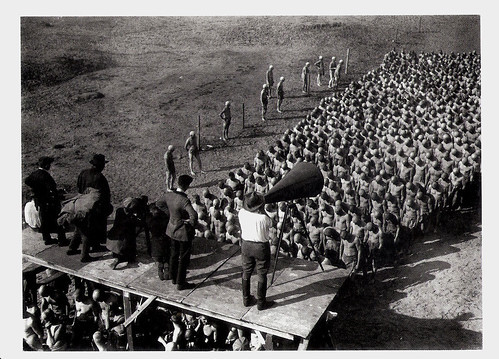
Swiss postcard by Musée de l'Elysée, Lausanne / News Productions, Baulmes, no. 55468. Photo: Horst von Harbou / Collection de la Cinemathèque française, Paris. Caption: Fritz Lang during the shooting of Metropolis, 1926.
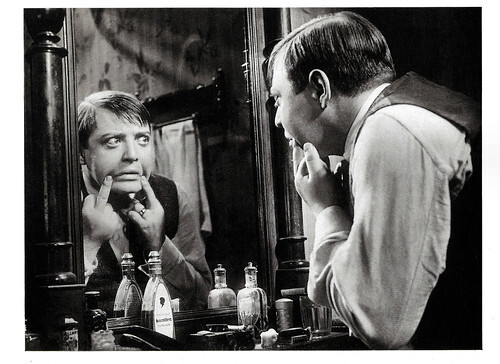
Swiss-British-German postcard by News Productions, Baulmes and Stroud / Filmwelt Berlin, Bakede, no. 56537. Photo: Collection Cinémathèque Suisse / Nero Film. Peter Lorre in M – Eine Stadt sucht einen Mörder/M (Fritz Lang, 1931).
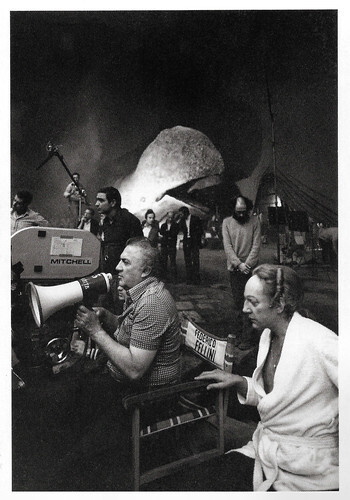
Swiss postcard by News Productions, Baulmes, no. 55592. Photo: Michelangelo Durazzo / ANA, Paris. Caption: Federico Fellini during the shooting of the film Casanova. At right Donald Sutherland who played Casanova.
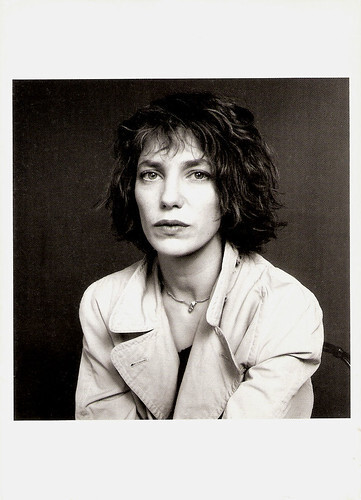
Swiss postcard by Musée de l'Elysée, Lausanne / News Productions, Baulmes, no. 55594. Photo: Laurence Sudre. Jane Birkin .
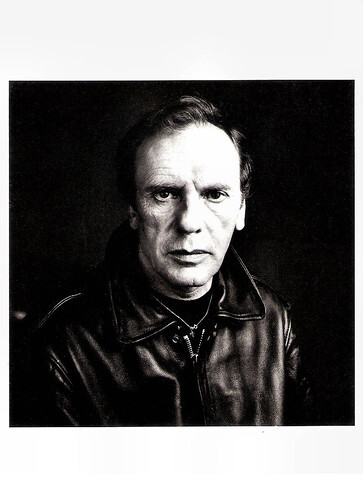
Swiss postcard by Musée de l'Elysée, Lausanne / News Productions, Baulmes, no. 55598. Photo: Laurence Sudre. Jean-Louis Trintignant .

Swiss postcard by News Productions, Baulmes, no. 55873, 1988. Photo: Dennis Hopper / Kunsthalle, Bâle / Musée de l'Elysée, Lausanne / Tony Shafrazi Gallery. Caption: Photography 1961-67.
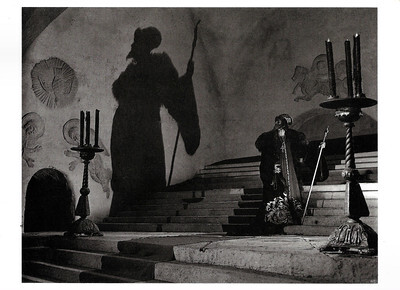
Swiss postcard by News Productions, Baulmes / Filmwelt Berlin, Bakede / News Productions, Stroud, no. 56511. Photo: COKS / Collection Cinémathèque Suisse, Lausanne. Nikolay Cherkasov in Ivan Groznyy/Ivan the Terrible (Sergei Eisenstein, 1944).
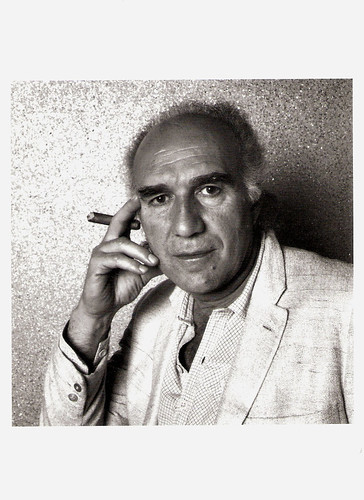
Swiss postcard by Musée de l'Elysée, Lausanne / News Productions, Baulmes, no. 55603. Photo: Laurence Sudre. Michel Piccoli .
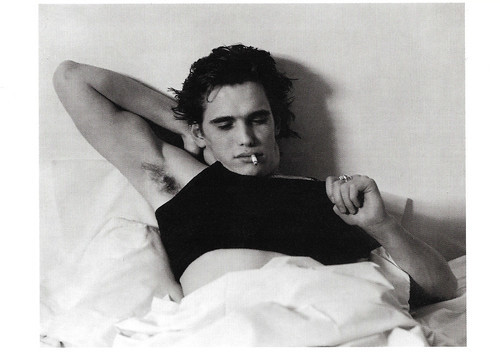
Swiss postcard by Musée de l'Elysée, Lausanne / News Productions, Baulmes, no. 55736. Photo: Bruce Weber. Caption: Matt Dillon , New York City, 1982.
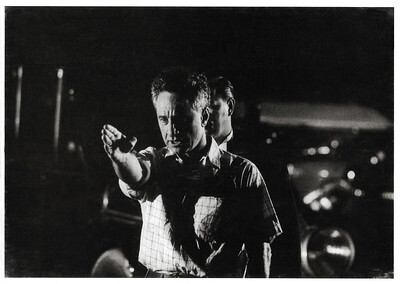
Swiss-British postcard by News Productions, Baulmes / Stroud, no. 56760. Photo: Larry Shaw. Elia Kazan on the set of Splendor in the Grass (Elia Kazan, 1960).
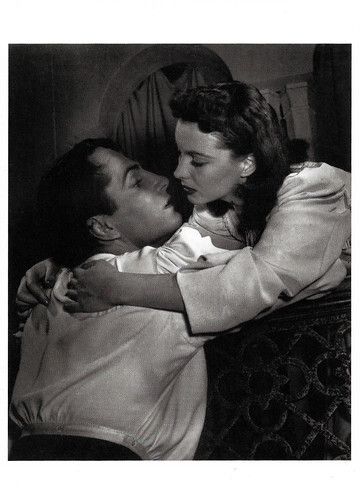
Swiss postcard by News Productions, Baulmes, no. 55833. Photo: W. Eugene Smith. Vivien Leigh and Laurence Olivier in a stage production of 'Romeo and Juliet' in 1940.
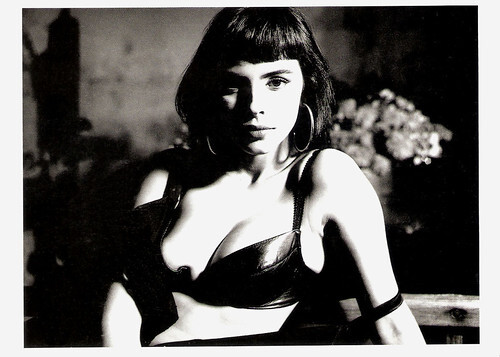
French postcard by Musée de l'Elysée, Lausanne / News Productions, Baulmes, no. 55951. Photo: Bettina Rheims / Sygma. Caption: Mathilda May - La Beauce, 1987.
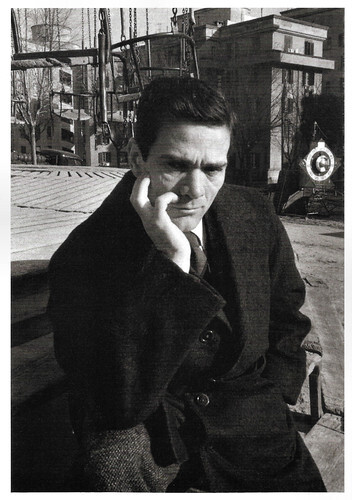
Swiss postcard by Musée de l'Élysée, Lausanne / News Productions, Baulmes, no. 56409. Photo: John Philips. Caption: Pier Paolo Pasolini, Rome, 1962.
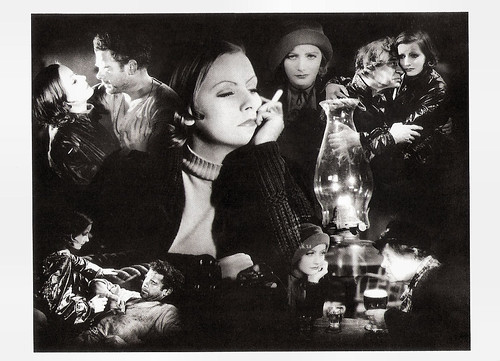
Swiss postcard by News Productions, Baulmes, no. 56490. Photo: Cinémathèque Suisse / Metro-Goldwyn-Mayer. Greta Garbo in Anna Christie (Clarence Brown, 1930). Design: Clarence Sinclair Bull, 1930.
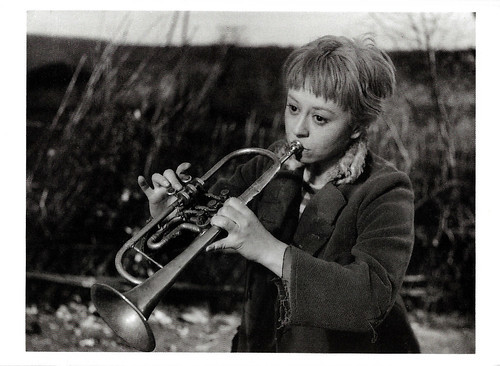
Swiss postcard by News Productions, Baulmes, no. 56518. Photo: Collection Cinémathéque Suisse, Lausanne / Ponti - De Laurentis. Giulietta Masina as Gelsomina in La Strada (Federico Fellini, 1954).
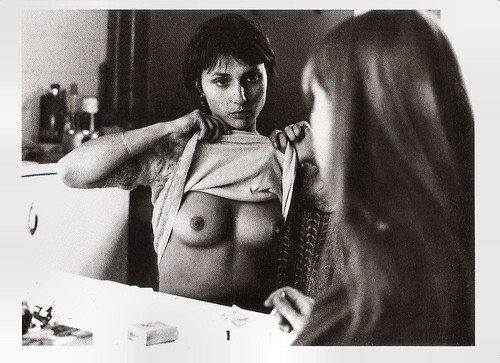
Vintage postcard by News Productions, Baulmes & Stroud / Filmwelt Berlin, no. 56528. Photo: Collection Cinémathéque Suisse, Lausanne. Anna Baldaccini and Isabelle Huppert in Sauve qui peut (la vie)/Every Man for Himself (Jean-Luc Godard, 1980).
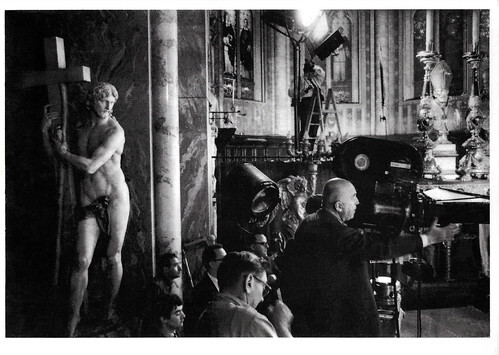
Swiss postcard by News Productions, Baulmes / Filmwelt Berlin, Bakede / News Productions, Stroud, no. 56573. Photo: Sam Shaw. Otto Preminger on the set of The Cardinal (Otto Preminger, 1963). Caption: Otto Preminger directing "The Cardinal", Rome, 1993 (sic).
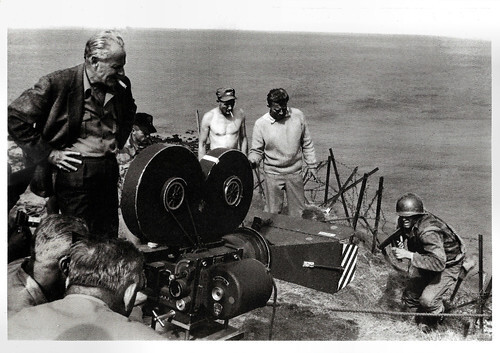
Vintage postcard by News Productions, Baulmes and Stroud / Filmwelt Berlin, Bakede, no. 56574, 1994. Photo: Sam Shaw. Darryl F. Zanuck on the set of The Longest Day (Ken Annakin, Andrew Marton, Bernhard Wicki, Darryl F. Zanuck (uncredited), 1962). Caption: "The Longest Day". Daryl Zanuck [sic], Normandie, 1964 [sic].
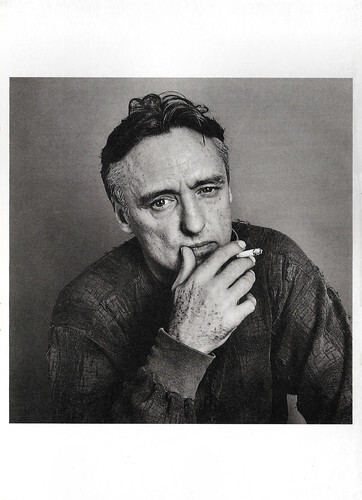
Swiss postcard by News Productions, Baulmes, no. 55726. Photo: Laurence Sudre. Dennis Hopper .
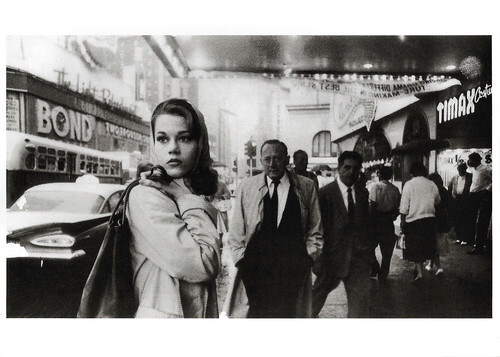
Swiss-British postcard by News Productions, Baulmes / Stroud, no. 56736, 1996. Photo: Sam Shaw. Caption: Jane Fonda , New York City, 1960.
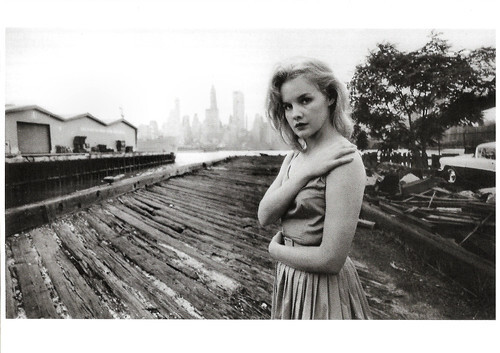
Swiss-British postcard by News Productions, Baulmes / Stroud, no. 56737, 1996. Photo: Larry Shaw. Caption: Carroll Baker , New York City, 1960.
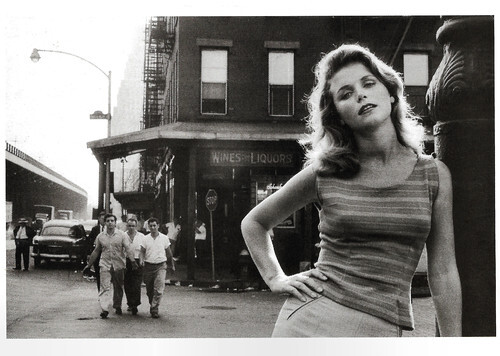
Swiss-British postcard by News Productions, Baulmes / Stroud, no. 56738, 1996. Photo: Sam Shaw. Caption: Lee Remick, on the Bowery, New York City, 1960.
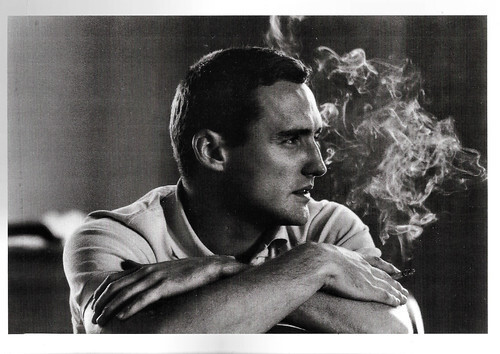
Swiss postcard by CVB Publishers / News Productions, no. 56778, 1996. Photo: Sam Shaw. Caption: Dennis Hopper , NYC, 1957.
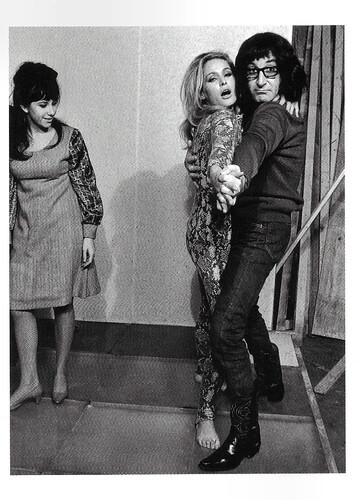
Swiss postcard by CVB Publishers / News Productions, no. 56961. Photo: Larry Shaw. Peter Sellers and Ursula Andress on the set of What's New Pussycat (Clive Donner, 1965).
Sources: Fotostiftung Schweiz and Dunne & Bradstreet.

Swiss postcard by News Productions, Baulmes, no. 55087. Photo: John Phillips / Musée de l'Elysée, Lausanne. Roberto Rossellini on the set of Viva l'Italia/Garibaldi (Roberto Rossellini, 1961). Caption: Italy, Sicily, 1960. Neo-realist film director, Roberto Rossellini shooting on location 'Viva L'Italia'.

Swiss postcard by Musée de l'Elysée, Lausanne / News Productions, Baulmes, no. 55108. Photo: Michelangelo Durazzo / AMA, Paris. Federico Fellini directing a scene of the film 8½ (1963).

Swiss postcard by News Productions, Baulmes, no. 55207. Photo: Sam Tata. Caption: Buster Keaton , Montreal, 1964. In Canada, Buster Keaton played in the short film The Railrodder (Gerald Potterton, 1965), which Keaton uncredited co-directed.

Swiss postcard by Musée de l'Elysée, Lausanne / News Productions, Baulmes, no. 55458. Photo: Horst von Harbou / Collection de la Cinemathèque française, Paris. Caption: Fritz Lang during the shooting of Metropolis, 1926.

Swiss postcard by Musée de l'Elysée, Lausanne / News Productions, Baulmes, no. 55459. Photo: Horst von Harbou, 1926 / Collection de la Cinemathèque française, Paris. Brigitte Helm in Metropolis (Fritz Lang, 1927).

Swiss postcard by Musée de l'Elysée, Lausanne / News Productions, Baulmes, no. 55468. Photo: Horst von Harbou / Collection de la Cinemathèque française, Paris. Caption: Fritz Lang during the shooting of Metropolis, 1926.

Swiss-British-German postcard by News Productions, Baulmes and Stroud / Filmwelt Berlin, Bakede, no. 56537. Photo: Collection Cinémathèque Suisse / Nero Film. Peter Lorre in M – Eine Stadt sucht einen Mörder/M (Fritz Lang, 1931).

Swiss postcard by News Productions, Baulmes, no. 55592. Photo: Michelangelo Durazzo / ANA, Paris. Caption: Federico Fellini during the shooting of the film Casanova. At right Donald Sutherland who played Casanova.

Swiss postcard by Musée de l'Elysée, Lausanne / News Productions, Baulmes, no. 55594. Photo: Laurence Sudre. Jane Birkin .

Swiss postcard by Musée de l'Elysée, Lausanne / News Productions, Baulmes, no. 55598. Photo: Laurence Sudre. Jean-Louis Trintignant .

Swiss postcard by News Productions, Baulmes, no. 55873, 1988. Photo: Dennis Hopper / Kunsthalle, Bâle / Musée de l'Elysée, Lausanne / Tony Shafrazi Gallery. Caption: Photography 1961-67.

Swiss postcard by News Productions, Baulmes / Filmwelt Berlin, Bakede / News Productions, Stroud, no. 56511. Photo: COKS / Collection Cinémathèque Suisse, Lausanne. Nikolay Cherkasov in Ivan Groznyy/Ivan the Terrible (Sergei Eisenstein, 1944).

Swiss postcard by Musée de l'Elysée, Lausanne / News Productions, Baulmes, no. 55603. Photo: Laurence Sudre. Michel Piccoli .

Swiss postcard by Musée de l'Elysée, Lausanne / News Productions, Baulmes, no. 55736. Photo: Bruce Weber. Caption: Matt Dillon , New York City, 1982.

Swiss-British postcard by News Productions, Baulmes / Stroud, no. 56760. Photo: Larry Shaw. Elia Kazan on the set of Splendor in the Grass (Elia Kazan, 1960).

Swiss postcard by News Productions, Baulmes, no. 55833. Photo: W. Eugene Smith. Vivien Leigh and Laurence Olivier in a stage production of 'Romeo and Juliet' in 1940.

French postcard by Musée de l'Elysée, Lausanne / News Productions, Baulmes, no. 55951. Photo: Bettina Rheims / Sygma. Caption: Mathilda May - La Beauce, 1987.

Swiss postcard by Musée de l'Élysée, Lausanne / News Productions, Baulmes, no. 56409. Photo: John Philips. Caption: Pier Paolo Pasolini, Rome, 1962.

Swiss postcard by News Productions, Baulmes, no. 56490. Photo: Cinémathèque Suisse / Metro-Goldwyn-Mayer. Greta Garbo in Anna Christie (Clarence Brown, 1930). Design: Clarence Sinclair Bull, 1930.

Swiss postcard by News Productions, Baulmes, no. 56518. Photo: Collection Cinémathéque Suisse, Lausanne / Ponti - De Laurentis. Giulietta Masina as Gelsomina in La Strada (Federico Fellini, 1954).

Vintage postcard by News Productions, Baulmes & Stroud / Filmwelt Berlin, no. 56528. Photo: Collection Cinémathéque Suisse, Lausanne. Anna Baldaccini and Isabelle Huppert in Sauve qui peut (la vie)/Every Man for Himself (Jean-Luc Godard, 1980).

Swiss postcard by News Productions, Baulmes / Filmwelt Berlin, Bakede / News Productions, Stroud, no. 56573. Photo: Sam Shaw. Otto Preminger on the set of The Cardinal (Otto Preminger, 1963). Caption: Otto Preminger directing "The Cardinal", Rome, 1993 (sic).

Vintage postcard by News Productions, Baulmes and Stroud / Filmwelt Berlin, Bakede, no. 56574, 1994. Photo: Sam Shaw. Darryl F. Zanuck on the set of The Longest Day (Ken Annakin, Andrew Marton, Bernhard Wicki, Darryl F. Zanuck (uncredited), 1962). Caption: "The Longest Day". Daryl Zanuck [sic], Normandie, 1964 [sic].

Swiss postcard by News Productions, Baulmes, no. 55726. Photo: Laurence Sudre. Dennis Hopper .

Swiss-British postcard by News Productions, Baulmes / Stroud, no. 56736, 1996. Photo: Sam Shaw. Caption: Jane Fonda , New York City, 1960.

Swiss-British postcard by News Productions, Baulmes / Stroud, no. 56737, 1996. Photo: Larry Shaw. Caption: Carroll Baker , New York City, 1960.

Swiss-British postcard by News Productions, Baulmes / Stroud, no. 56738, 1996. Photo: Sam Shaw. Caption: Lee Remick, on the Bowery, New York City, 1960.

Swiss postcard by CVB Publishers / News Productions, no. 56778, 1996. Photo: Sam Shaw. Caption: Dennis Hopper , NYC, 1957.

Swiss postcard by CVB Publishers / News Productions, no. 56961. Photo: Larry Shaw. Peter Sellers and Ursula Andress on the set of What's New Pussycat (Clive Donner, 1965).
Sources: Fotostiftung Schweiz and Dunne & Bradstreet.
Published on December 19, 2021 22:00
December 18, 2021
Toy Story (1995)
December is Pixar month at EFSP! In the coming weeks, we will share our collection of postcards of the Pixar Animation Studios with you at EFSP in a series of posts that started two weeks ago. In Pixar's groundbreaking Toy Story (John Lasseter, 1995), a cowboy doll is profoundly threatened and jealous when a new spaceman figure supplants him as the top toy in a boy's room. Toy Story was the first successful CGI full-length movie.
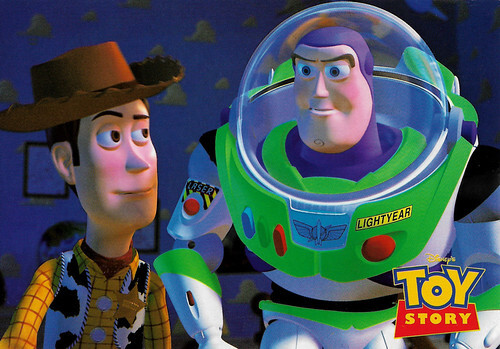
French postcard by Chromovogue, no. 7201-2. Image: Pixar / Disney / Hasbro. Film image of Toy Story (John Lasseter, 1995).
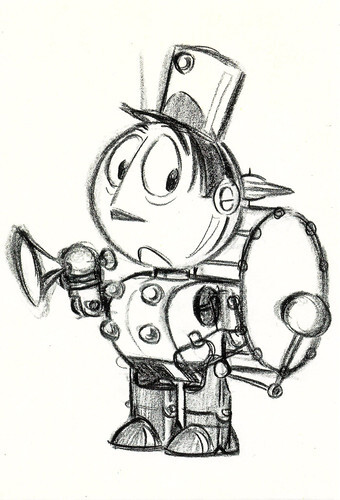
Tinny. American postcard by Disney Enterprises / Pixar Animation Studios, 2005. Image: Pixar Animation Studios. Concept art by Jeff Pidgeon for Toy Story (John Lasseter, 1995). From 'The Art of Pixar: 100 Collectible Postcards, published by Chronicle Books.
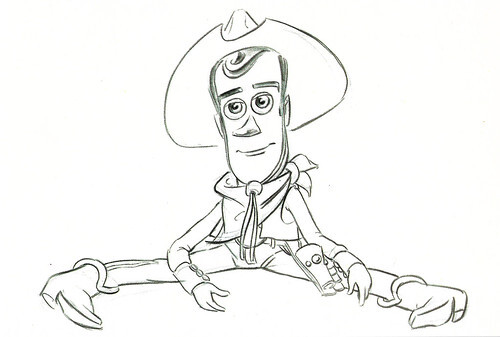
Woody. American postcard by Disney Enterprises / Pixar Animation Studios, 2005. Image: Pixar Animation Studios. Concept art by Bud Luckey for Toy Story (John Lasseter, 1995). From 'The Art of Pixar: 100 Collectible Postcards, published by Chronicle Books.
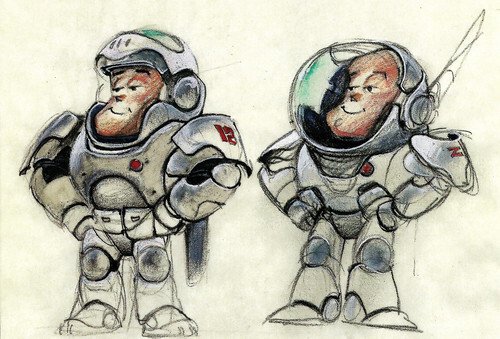
Buzz Lightyear. American postcard by Disney Enterprises / Pixar Animation Studios, 2005. Image: Pixar Animation Studios. Concept art by Nilo Rodis for Toy Story (John Lasseter, 1995). From 'The Art of Pixar: 100 Collectible Postcards, published by Chronicle Books.
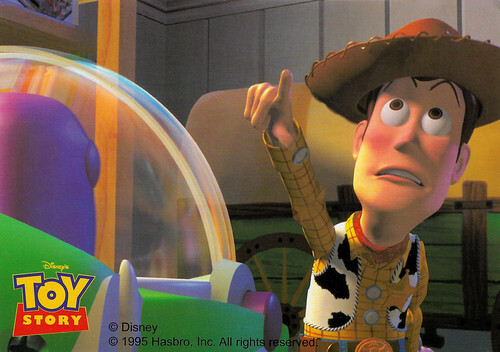
Polish postcard by Z & Z, Sulejówek, no. 20 35. Image: Pixar / Disney / Hasbro. Film image of Toy Story (John Lasseter, 1995).
A cowboy doll named "Woody"
Toy Story (1995) was produced by Pixar Animation Studios and released by Walt Disney Pictures. It was the first entirely computer-animated feature film, as well as the first feature film from Pixar.
Pixar's short film Tin Toy (1988) referenced already Lasseter's love of classic toys. It won the 1989 Academy Award for Best Animated Short Film, the first computer-generated film to do so. After that, Pixar was approached by Disney to produce a computer-animated feature film told from a small toy's perspective.
The protagonist of Tin Toy, a tin drummer called Tinny, was originally going to star in Toy Story. However, he turned out to be too immobile for a major film, so his appearance was changed to that of a space character.
In Toy Story (1995), a little boy named Andy loves to be in his room, playing with his toys, especially his cowboy doll named "Woody". But, what do the toys do when Andy is not with them? They come to life.
Woody believes that his life as a toy is good. However, he must worry about Andy's family moving, and what Woody does not know is about Andy's birthday party. Woody does not realise that Andy's mother gave him an action figure known as Buzz Lightyear, who does not believe that he is a toy and quickly becomes Andy's new favourite toy.
Woody, who is now consumed with jealousy, tries to get rid of Buzz. Then, both Woody and Buzz are lost. They must find a way to get back to Andy before he moves without them, but they will have to pass through a ruthless toy killer, Sid Phillips...
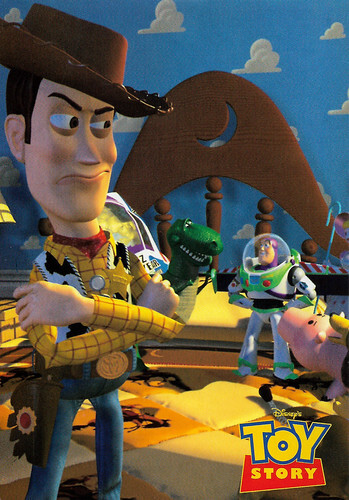
French postcard by Chromovogue, no. 7201-6. Image: Pixar / Disney / Hasbro. Film image of Toy Story (John Lasseter, 1995).
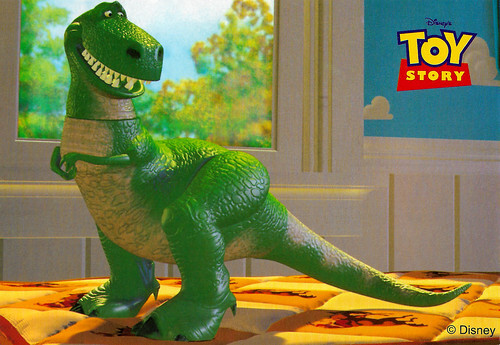
Polish postcard by Z & Z, Sulejówek, no. 020 25. Image: Pixar / Disney. Film image of Toy Story (John Lasseter, 1995).
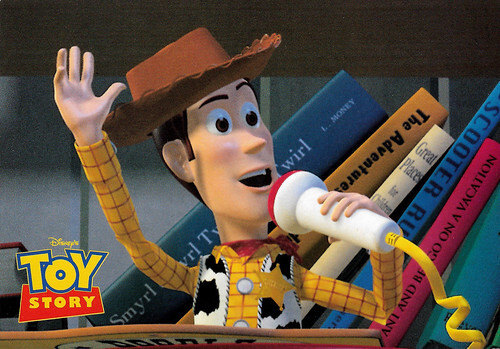
French postcard by Chromovogue, no. 7201-5. Image: Pixar / Disney / Hasbro. Film image of Toy Story (John Lasseter, 1995).
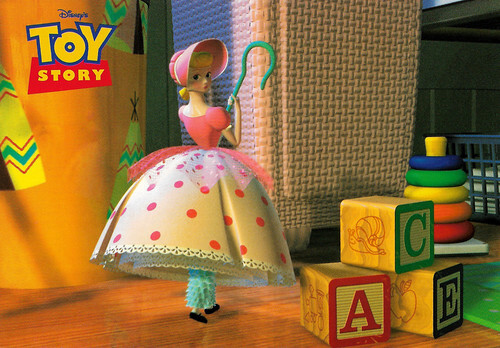
French postcard by Hasbro, Inc., no. 7201-1, 1995. Image: Pixar / Disney. Film image of Toy Story (John Lasseter, 1995).
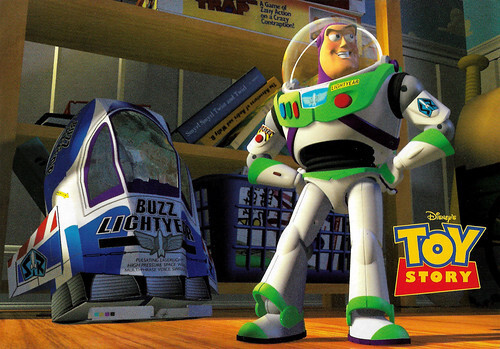
French postcard by Chromovogue, no. 7201-4. Image: Pixar / Disney / Hasbro. Film image of Toy Story (John Lasseter, 1995).
Enormously successful and equally as enjoyable
Toy Story (John Lassiter, 1995) was a revelation in 1995 and a big hit for Disnney and Pixar. The film grossed $354 million worldwide against a budget of $30 million.
Hal Erickson at AllMovie : "Toy Story was the first feature-length film animated entirely by computer. If this seems to be a sterile, mechanical means of moviemaking, be assured that the film is as chock-full of heart and warmth as any Disney cartoon feature."
Toy Story was directed by John Lasseter and was written by Joss Whedon, Andrew Stanton, Joel Cohen, and Alec Sokolow from a story by Lasseter, Stanton, Pete Docter, and Joe Ranft.
The computer-animated film won several awards. It was nominated for the Oscar for Best Writing, Screenplay Written Directly for the Screen, and a Special Achievement Award (for the creation of a feature-length computer-animated film). It was also nominated for the BAFTA for Best Special Visual Effects, and the Golden Globe for Best Motion Picture - Comedy/Musical.
And then there was the Oscar and Golden Globe-nominated theme song 'You've Got a Friend' by Randy Newman and Lyle Lovett and Oscar-nominated music by Randy Newman.
Three sequels would follow, Toy Story 2 (John Lasseter, Lee Unkrich, Ash Brannon, 1999), Toy Story 3 (Lee Unkrich, 2010), and Toy Story 4 (Josh Cooley, 2019), all enormously successful and equally as enjoyable.
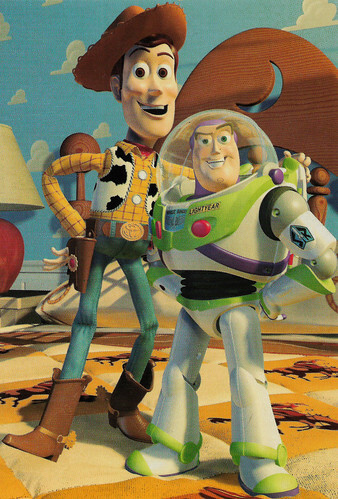
American postcard by Disney Enterprises / Pixar Animation Studios, 2005. Image: Pixar Animation Studios. Film image of Toy Story (John Lasseter, 1995). From 'The Art of Pixar: 100 Collectible Postcards, published by Chronicle Books.
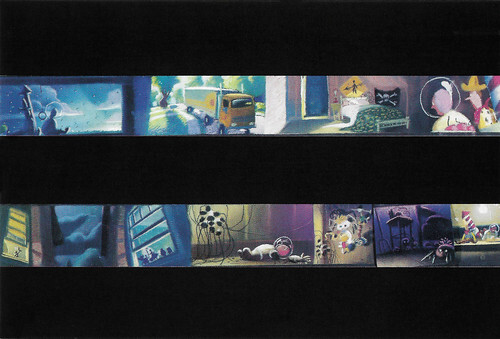
American postcard by Disney Enterprises / Pixar Animation Studios, 2005. Image: Pixar Animation Studios. Concept art by Ralph Eggleston for Toy Story (John Lasseter, 1995). From 'The Art of Pixar: 100 Collectible Postcards, published by Chronicle Books.
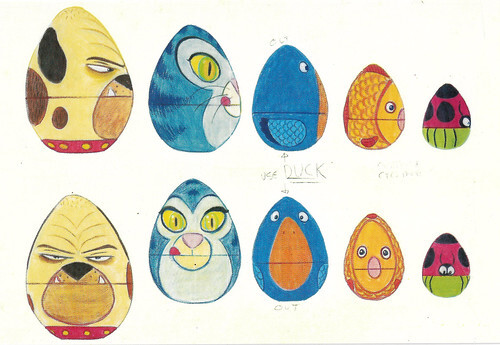
American postcard by Disney Enterprises / Pixar Animation Studios, 2005. Image: Pixar Animation Studios. Concept art by Ralph Eggleston for Toy Story (John Lasseter, 1995). From 'The Art of Pixar: 100 Collectible Postcards, published by Chronicle Books.
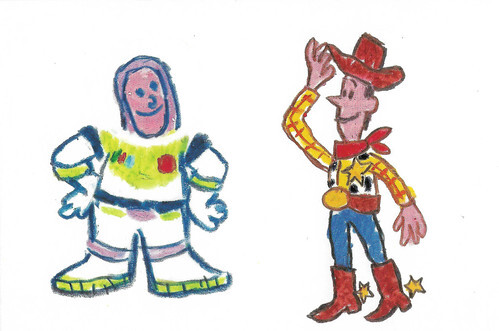
American postcard by Disney Enterprises / Pixar Animation Studios, 2005. Image: Pixar Animation Studios. Concept art by Ralph Eggleston for Toy Story (John Lasseter, 1995). From 'The Art of Pixar: 100 Collectible Postcards, published by Chronicle Books.
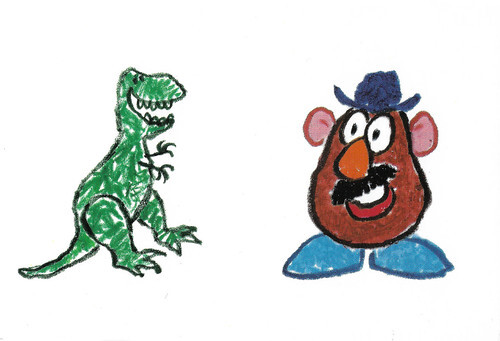
American postcard by Disney Enterprises / Pixar Animation Studios, 2005. Image: Pixar Animation Studios. Concept art by Ralph Eggleston for Toy Story (John Lasseter, 1995). From 'The Art of Pixar: 100 Collectible Postcards, published by Chronicle Books.
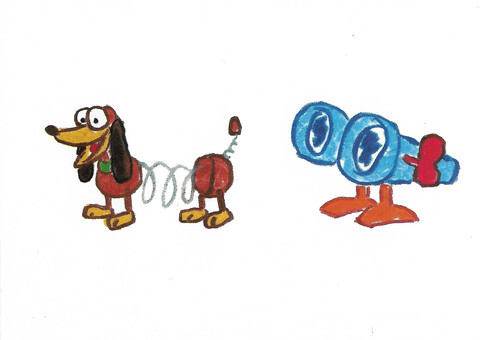
American postcard by Disney Enterprises / Pixar Animation Studios, 2005. Image: Pixar Animation Studios. Concept art by Ralph Eggleston for Toy Story (John Lasseter, 1995). From 'The Art of Pixar: 100 Collectible Postcards, published by Chronicle Books.
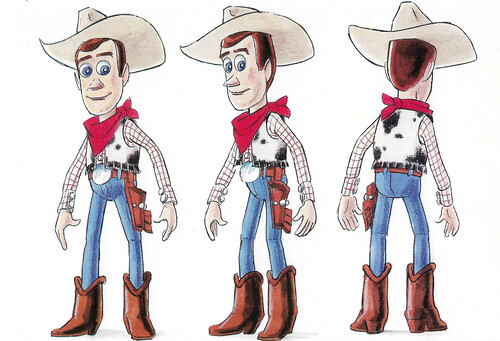
American postcard by Disney Enterprises / Pixar Animation Studios, 2005. Image: Pixar Animation Studios. Concept art by Bud Luckey for Toy Story (John Lasseter, 1995). From 'The Art of Pixar: 100 Collectible Postcards, published by Chronicle Books.
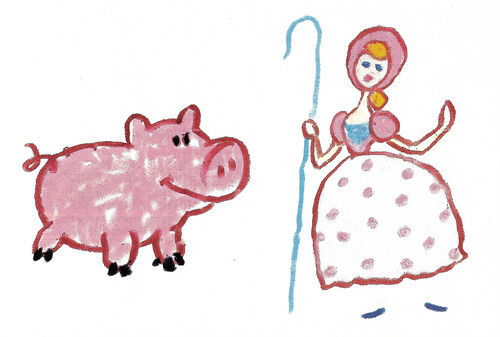
American postcard by Disney Enterprises / Pixar Animation Studios, 2005. Image: Pixar Animation Studios. Concept art by Ralph Eggleston for Toy Story (John Lasseter, 1995). From 'The Art of Pixar: 100 Collectible Postcards, published by Chronicle Books.
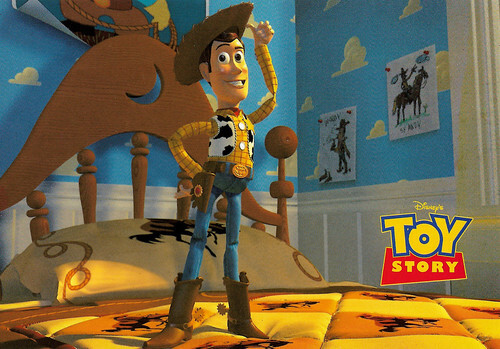
French postcard by Chromovogue, no. 7201-3. Image: Pixar / Disney / Hasbro. Film image of Toy Story (John Lasseter, 1995).
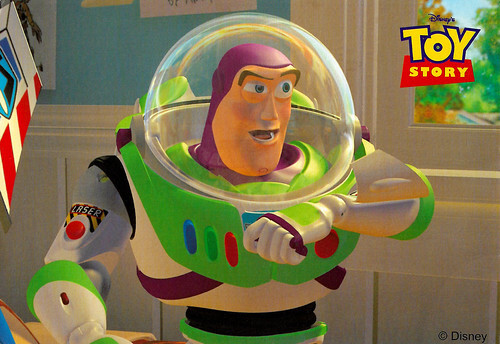
Polish postcard by Z & Z, Sulejówek, no. 020 22. Image: Pixar / Disney / Hasbro. Film image of Toy Story (John Lasseter, 1995).

French postcard by Chromovogue, no. 7201-6. Image: Pixar / Disney / Hasbro. Film image of Toy Story (John Lasseter, 1995).
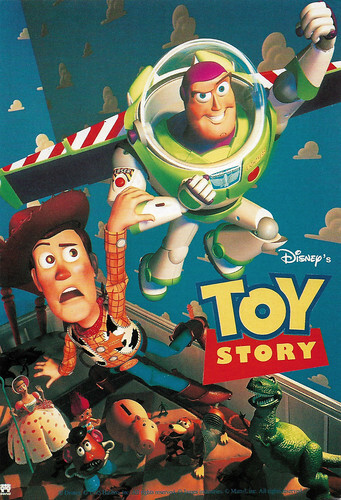
French postcard by Sonis, no. C. 620. Image: Pixar / Disney / Hasbro / Mattel / James Industries. Film poster for Toy Story (John Lasseter, 1995).
Sources: Hal Erickson (AllMovie), Wikipedia (Dutch and English), and IMDb.

French postcard by Chromovogue, no. 7201-2. Image: Pixar / Disney / Hasbro. Film image of Toy Story (John Lasseter, 1995).

Tinny. American postcard by Disney Enterprises / Pixar Animation Studios, 2005. Image: Pixar Animation Studios. Concept art by Jeff Pidgeon for Toy Story (John Lasseter, 1995). From 'The Art of Pixar: 100 Collectible Postcards, published by Chronicle Books.

Woody. American postcard by Disney Enterprises / Pixar Animation Studios, 2005. Image: Pixar Animation Studios. Concept art by Bud Luckey for Toy Story (John Lasseter, 1995). From 'The Art of Pixar: 100 Collectible Postcards, published by Chronicle Books.

Buzz Lightyear. American postcard by Disney Enterprises / Pixar Animation Studios, 2005. Image: Pixar Animation Studios. Concept art by Nilo Rodis for Toy Story (John Lasseter, 1995). From 'The Art of Pixar: 100 Collectible Postcards, published by Chronicle Books.

Polish postcard by Z & Z, Sulejówek, no. 20 35. Image: Pixar / Disney / Hasbro. Film image of Toy Story (John Lasseter, 1995).
A cowboy doll named "Woody"
Toy Story (1995) was produced by Pixar Animation Studios and released by Walt Disney Pictures. It was the first entirely computer-animated feature film, as well as the first feature film from Pixar.
Pixar's short film Tin Toy (1988) referenced already Lasseter's love of classic toys. It won the 1989 Academy Award for Best Animated Short Film, the first computer-generated film to do so. After that, Pixar was approached by Disney to produce a computer-animated feature film told from a small toy's perspective.
The protagonist of Tin Toy, a tin drummer called Tinny, was originally going to star in Toy Story. However, he turned out to be too immobile for a major film, so his appearance was changed to that of a space character.
In Toy Story (1995), a little boy named Andy loves to be in his room, playing with his toys, especially his cowboy doll named "Woody". But, what do the toys do when Andy is not with them? They come to life.
Woody believes that his life as a toy is good. However, he must worry about Andy's family moving, and what Woody does not know is about Andy's birthday party. Woody does not realise that Andy's mother gave him an action figure known as Buzz Lightyear, who does not believe that he is a toy and quickly becomes Andy's new favourite toy.
Woody, who is now consumed with jealousy, tries to get rid of Buzz. Then, both Woody and Buzz are lost. They must find a way to get back to Andy before he moves without them, but they will have to pass through a ruthless toy killer, Sid Phillips...

French postcard by Chromovogue, no. 7201-6. Image: Pixar / Disney / Hasbro. Film image of Toy Story (John Lasseter, 1995).

Polish postcard by Z & Z, Sulejówek, no. 020 25. Image: Pixar / Disney. Film image of Toy Story (John Lasseter, 1995).

French postcard by Chromovogue, no. 7201-5. Image: Pixar / Disney / Hasbro. Film image of Toy Story (John Lasseter, 1995).

French postcard by Hasbro, Inc., no. 7201-1, 1995. Image: Pixar / Disney. Film image of Toy Story (John Lasseter, 1995).

French postcard by Chromovogue, no. 7201-4. Image: Pixar / Disney / Hasbro. Film image of Toy Story (John Lasseter, 1995).
Enormously successful and equally as enjoyable
Toy Story (John Lassiter, 1995) was a revelation in 1995 and a big hit for Disnney and Pixar. The film grossed $354 million worldwide against a budget of $30 million.
Hal Erickson at AllMovie : "Toy Story was the first feature-length film animated entirely by computer. If this seems to be a sterile, mechanical means of moviemaking, be assured that the film is as chock-full of heart and warmth as any Disney cartoon feature."
Toy Story was directed by John Lasseter and was written by Joss Whedon, Andrew Stanton, Joel Cohen, and Alec Sokolow from a story by Lasseter, Stanton, Pete Docter, and Joe Ranft.
The computer-animated film won several awards. It was nominated for the Oscar for Best Writing, Screenplay Written Directly for the Screen, and a Special Achievement Award (for the creation of a feature-length computer-animated film). It was also nominated for the BAFTA for Best Special Visual Effects, and the Golden Globe for Best Motion Picture - Comedy/Musical.
And then there was the Oscar and Golden Globe-nominated theme song 'You've Got a Friend' by Randy Newman and Lyle Lovett and Oscar-nominated music by Randy Newman.
Three sequels would follow, Toy Story 2 (John Lasseter, Lee Unkrich, Ash Brannon, 1999), Toy Story 3 (Lee Unkrich, 2010), and Toy Story 4 (Josh Cooley, 2019), all enormously successful and equally as enjoyable.

American postcard by Disney Enterprises / Pixar Animation Studios, 2005. Image: Pixar Animation Studios. Film image of Toy Story (John Lasseter, 1995). From 'The Art of Pixar: 100 Collectible Postcards, published by Chronicle Books.

American postcard by Disney Enterprises / Pixar Animation Studios, 2005. Image: Pixar Animation Studios. Concept art by Ralph Eggleston for Toy Story (John Lasseter, 1995). From 'The Art of Pixar: 100 Collectible Postcards, published by Chronicle Books.

American postcard by Disney Enterprises / Pixar Animation Studios, 2005. Image: Pixar Animation Studios. Concept art by Ralph Eggleston for Toy Story (John Lasseter, 1995). From 'The Art of Pixar: 100 Collectible Postcards, published by Chronicle Books.

American postcard by Disney Enterprises / Pixar Animation Studios, 2005. Image: Pixar Animation Studios. Concept art by Ralph Eggleston for Toy Story (John Lasseter, 1995). From 'The Art of Pixar: 100 Collectible Postcards, published by Chronicle Books.

American postcard by Disney Enterprises / Pixar Animation Studios, 2005. Image: Pixar Animation Studios. Concept art by Ralph Eggleston for Toy Story (John Lasseter, 1995). From 'The Art of Pixar: 100 Collectible Postcards, published by Chronicle Books.

American postcard by Disney Enterprises / Pixar Animation Studios, 2005. Image: Pixar Animation Studios. Concept art by Ralph Eggleston for Toy Story (John Lasseter, 1995). From 'The Art of Pixar: 100 Collectible Postcards, published by Chronicle Books.

American postcard by Disney Enterprises / Pixar Animation Studios, 2005. Image: Pixar Animation Studios. Concept art by Bud Luckey for Toy Story (John Lasseter, 1995). From 'The Art of Pixar: 100 Collectible Postcards, published by Chronicle Books.

American postcard by Disney Enterprises / Pixar Animation Studios, 2005. Image: Pixar Animation Studios. Concept art by Ralph Eggleston for Toy Story (John Lasseter, 1995). From 'The Art of Pixar: 100 Collectible Postcards, published by Chronicle Books.

French postcard by Chromovogue, no. 7201-3. Image: Pixar / Disney / Hasbro. Film image of Toy Story (John Lasseter, 1995).

Polish postcard by Z & Z, Sulejówek, no. 020 22. Image: Pixar / Disney / Hasbro. Film image of Toy Story (John Lasseter, 1995).

French postcard by Chromovogue, no. 7201-6. Image: Pixar / Disney / Hasbro. Film image of Toy Story (John Lasseter, 1995).

French postcard by Sonis, no. C. 620. Image: Pixar / Disney / Hasbro / Mattel / James Industries. Film poster for Toy Story (John Lasseter, 1995).
Sources: Hal Erickson (AllMovie), Wikipedia (Dutch and English), and IMDb.
Published on December 18, 2021 22:00
December 17, 2021
Carla's 12 feel-good postcards of 2021
At first, I wanted to compile a list of actors who had or have jobs other than acting. These jobs could be prior to, during, or after their acting career. But then I bought a card with Linda Blair in The Exorcist, and I thought wow, she must have had professional help. I thought a list with child actors and what had become of them might be interesting too. I immediately sought in my collection whether I had cards of other child actors. Both lists stranded. They have to wait. Paul then suggested I’d make a list with 12 cards that I bought this year which made me feel good. Easy: all the cards I buy, make me feel good. Thus, I began the difficult task of selecting 12 cards I bought this past year. I start with:
Linda Blair in The Exorcist
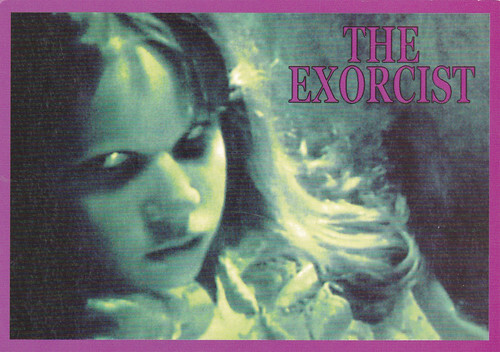
Vintage postcard, no. 2171. Caption: Exorcist green. Linda Blair in The Exorcist (William Friedkin, 1973).
This is not a card that makes me feel good, but it is one that made an impression. I thought this must not have been easy for Linda Blair. I read an article about child actors in horror movies and immediately thought this would make a list. Not only children in horror movies but child actors in general: what has become of them. As said, this list has been put on hold.
Beerbohm The Theatre Cat
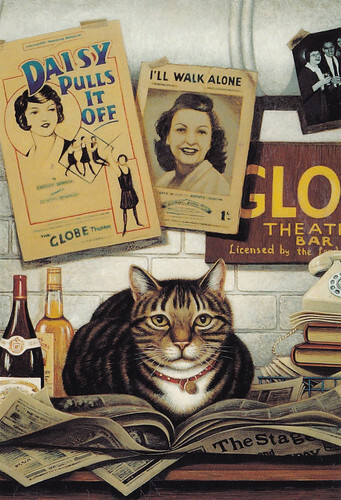
British postcard by Mayfair Cards of London, no. FB 28. Illustration: Frances Broomfield. Caption: Beerbohm was an habitué of London's Theatreland, equally at home at The Globe or Her Majesty's. Although very much a backstage cat, his occasional on-stage appearances won him much applause.
English theatres often had a theatre cat. They were useful in helping to keep the theatre free of mice, but they became also useful in helping actors to overcome stage fright. Often the cats felt so much at home that they walked on stage during a play or performance. One of the most famous theatre cats was called Beerbohm, named after the British actor Sir Herbert Beerbohm Tree . Beerbohm is the spitting image of our cat. Yes, a feel-good card.
Joan Crawford
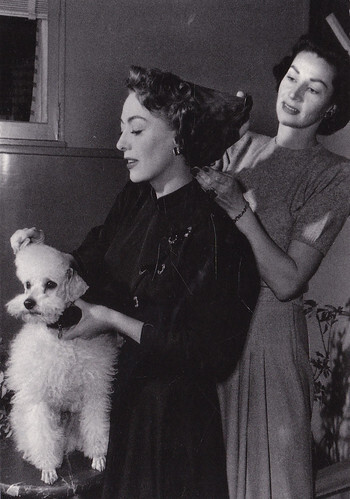
German postcard by pwe Verlag, München (Munich). From the Prestel book 'Fashion in Film'. Caption: Cliquot the poodle, Joan Crawford , Gertrude Wheeler during a break in shooting The Damned Don't Cry, 1950. Directed by Vincent Sherman. Costumes by Sheila O'Brian.
I like pictures that seem to have been taken as if people did not notice they were being photographed. I think Joan Crawford knows full well that her picture is taken, but it is nevertheless a picture that made me smile: hair stylist Gertrude Wheeler does Joan’s hair, while Joan is brushing Cliquot, her pet poodle.
Johnny Hallyday and Sylvie Vartan
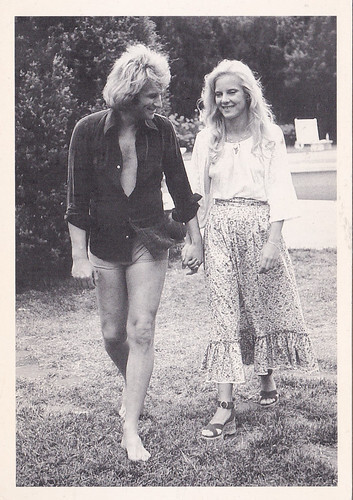
French postcard, no. LRCP 030.
Johnny Hallyday and Sylvie Vartan were called “the golden couple”. I doubt whether that is true; they had a rather troublesome relationship and divorced after 15 years of marriage. However, they remained friends until Johnny’s death in 2017. In this picture they seem happy, the Hallydays on holiday in the seventies, I guess.
Tommy Cooper

British postcard by Boomerang Media Cards in the Best of British Quirky Traits series, no. 6, Humour. Photo: Jon Lyons.
Back in the seventies we always watched Tommy Cooper. I don’t remember whether we stayed at home to watch Tommy on tv, but I do remember we watched him with the whole family. We regularly got the giggles. Nostalgia.
Faye Dunaway
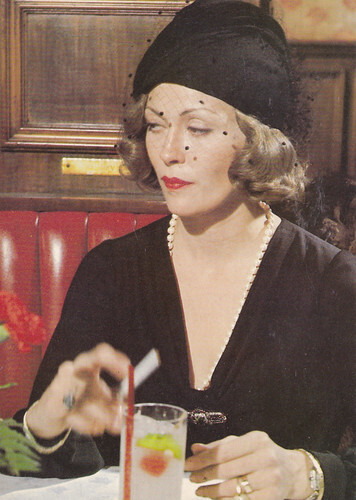
British postcard by Star-Graphics, London, no. S 118. Faye Dunaway in Chinatown (Roman Polanski, 1974).
Faye Dunaway in Chinatown (1974). I did not possess a card of Faye Dunaway yet. Now I do. That feels good.
Laura La Plante
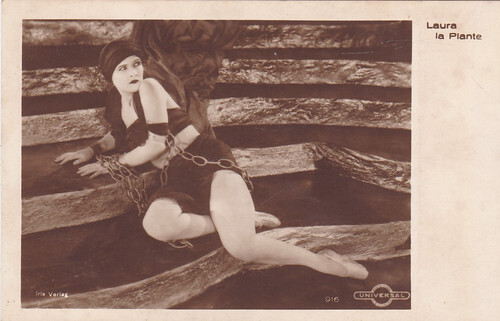
Austrian postcard by Iris Verlag, no. 916. Photo: Universal Pictures Corporation. Laura La Plante in The Midnight Sun (Dimitri Buchowetzki, 1926).
I bought this card because I find it a curious image. It is Laura La Plante in The Midnight Sun (1926). She plays a prima ballerina in this movie and I guess she is in a ballet performance on this card. Again, a wonderful addition to the collection.
Rudolph Valentino
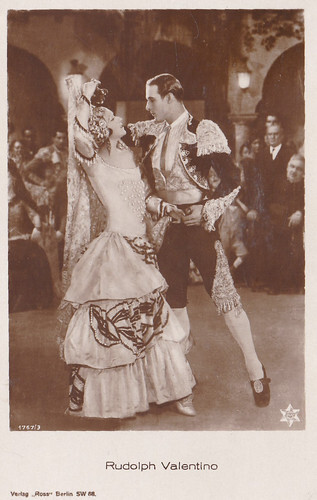
German postcard by Ross Verlag, no. 1767/3, 1927-1928. Photo: Paramount Pictures. Rudolph Valentino and Helena D’Algy in A Sainted Devil (Joseph Henabery, 1924).
I bought this card because Rudolph Valentino is in it. I had to look up which film this is: A Sainted Devil (1924). His dance partner is Helena D’Algy. Again, a feel-good card. I have a few cards of Rudolph Valentino in my collection, but this one is my favourite.
Jayne Mansfield
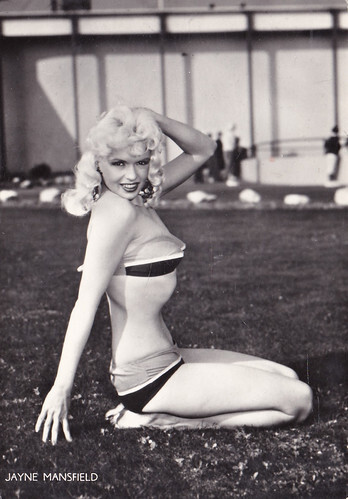
Italian postcard, no. 584.
I like old vintage cards with pin-ups. Especially ‘kitschy’ pin-ups. I think Jayne Mansfield is one of those kitschy pin-ups. This is my latest purchase of her. I am wondering, does she suck in her stomach?
Mamie van Doren
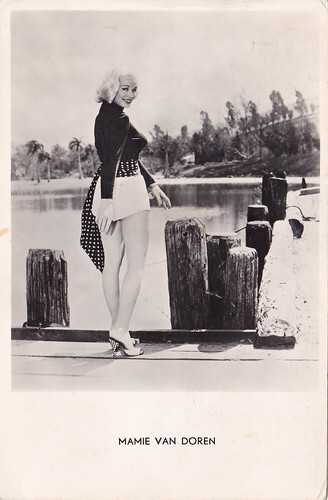
Belgian postcard.
Another pin-up card I am very happy with, Mamie Van Doren . I have a few cards of Mamie Van Doren. They are all wonderful cards, but every last card I buy is the most beautiful. A few weeks ago, I bought this card. It is my most wonderful card of Mamie…. Until I find another one.
Johnny Weissmuller
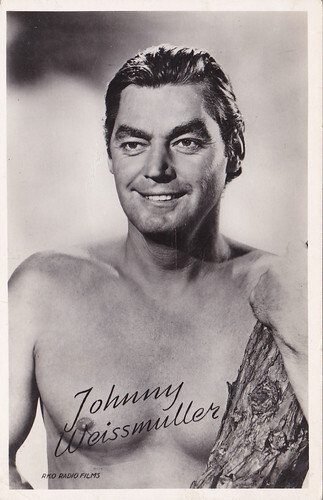
Dutch postcard by Archief Film en Toneel, no. 3458. Photo: RKO Radio Films.
My first Tarzan card! This card of Johnny Weissmuller was also destined to be a card for the list of actors who had other jobs. Johnny Weissmuller was a swimmer, and he was Tarzan The Apeman. It is also the first and only card of Johnny Weissmuller in my collection.
Marilyn Monroe
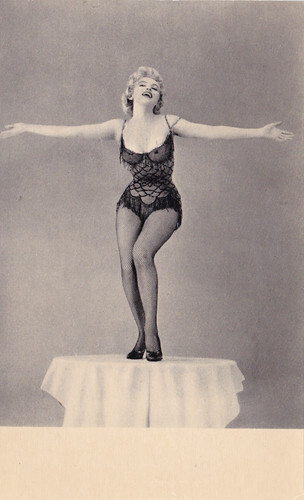
Yugoslavian postcard by Epoha, Zagreb, no. 4. Marilyn Monroe in Bus Stop (Joshua Logan, 1956).
And of course Marilyn Monroe . This card was a present from my English friend. She is one of the biggest fans of Marilyn I know. A card like this makes my day. I must write this friend and send her this list.
All cards I buy (or receive as a present) make me happy. They make me happy because of different reasons. I selected twelve cards from the ones I bought last year. Not an easy task, but easier than compiling a list with child actors, because I could not find the cards I wanted. And easier than a list of actors with other jobs because most of them were active in sports or bodybuilding. (One actor even became president…) Moreover, I don’t know whether singing and dancing fall under the same ‘skill’ as acting. Of course, they are not the same, but there are many actors who practice all…. Musical stars, opera singers. In what category does Gene Kelly e.g. fit. Difficult. So those lists are on hold. Temporarily, I hope.
Text and postcards: Carla Bosch. Postcard collector and friend Carla Bosch regularly contributes guest posts to EFSP. Check out e.g. her post of last year, Let the sun shine in.
Linda Blair in The Exorcist

Vintage postcard, no. 2171. Caption: Exorcist green. Linda Blair in The Exorcist (William Friedkin, 1973).
This is not a card that makes me feel good, but it is one that made an impression. I thought this must not have been easy for Linda Blair. I read an article about child actors in horror movies and immediately thought this would make a list. Not only children in horror movies but child actors in general: what has become of them. As said, this list has been put on hold.
Beerbohm The Theatre Cat

British postcard by Mayfair Cards of London, no. FB 28. Illustration: Frances Broomfield. Caption: Beerbohm was an habitué of London's Theatreland, equally at home at The Globe or Her Majesty's. Although very much a backstage cat, his occasional on-stage appearances won him much applause.
English theatres often had a theatre cat. They were useful in helping to keep the theatre free of mice, but they became also useful in helping actors to overcome stage fright. Often the cats felt so much at home that they walked on stage during a play or performance. One of the most famous theatre cats was called Beerbohm, named after the British actor Sir Herbert Beerbohm Tree . Beerbohm is the spitting image of our cat. Yes, a feel-good card.
Joan Crawford

German postcard by pwe Verlag, München (Munich). From the Prestel book 'Fashion in Film'. Caption: Cliquot the poodle, Joan Crawford , Gertrude Wheeler during a break in shooting The Damned Don't Cry, 1950. Directed by Vincent Sherman. Costumes by Sheila O'Brian.
I like pictures that seem to have been taken as if people did not notice they were being photographed. I think Joan Crawford knows full well that her picture is taken, but it is nevertheless a picture that made me smile: hair stylist Gertrude Wheeler does Joan’s hair, while Joan is brushing Cliquot, her pet poodle.
Johnny Hallyday and Sylvie Vartan

French postcard, no. LRCP 030.
Johnny Hallyday and Sylvie Vartan were called “the golden couple”. I doubt whether that is true; they had a rather troublesome relationship and divorced after 15 years of marriage. However, they remained friends until Johnny’s death in 2017. In this picture they seem happy, the Hallydays on holiday in the seventies, I guess.
Tommy Cooper

British postcard by Boomerang Media Cards in the Best of British Quirky Traits series, no. 6, Humour. Photo: Jon Lyons.
Back in the seventies we always watched Tommy Cooper. I don’t remember whether we stayed at home to watch Tommy on tv, but I do remember we watched him with the whole family. We regularly got the giggles. Nostalgia.
Faye Dunaway

British postcard by Star-Graphics, London, no. S 118. Faye Dunaway in Chinatown (Roman Polanski, 1974).
Faye Dunaway in Chinatown (1974). I did not possess a card of Faye Dunaway yet. Now I do. That feels good.
Laura La Plante

Austrian postcard by Iris Verlag, no. 916. Photo: Universal Pictures Corporation. Laura La Plante in The Midnight Sun (Dimitri Buchowetzki, 1926).
I bought this card because I find it a curious image. It is Laura La Plante in The Midnight Sun (1926). She plays a prima ballerina in this movie and I guess she is in a ballet performance on this card. Again, a wonderful addition to the collection.
Rudolph Valentino

German postcard by Ross Verlag, no. 1767/3, 1927-1928. Photo: Paramount Pictures. Rudolph Valentino and Helena D’Algy in A Sainted Devil (Joseph Henabery, 1924).
I bought this card because Rudolph Valentino is in it. I had to look up which film this is: A Sainted Devil (1924). His dance partner is Helena D’Algy. Again, a feel-good card. I have a few cards of Rudolph Valentino in my collection, but this one is my favourite.
Jayne Mansfield

Italian postcard, no. 584.
I like old vintage cards with pin-ups. Especially ‘kitschy’ pin-ups. I think Jayne Mansfield is one of those kitschy pin-ups. This is my latest purchase of her. I am wondering, does she suck in her stomach?
Mamie van Doren

Belgian postcard.
Another pin-up card I am very happy with, Mamie Van Doren . I have a few cards of Mamie Van Doren. They are all wonderful cards, but every last card I buy is the most beautiful. A few weeks ago, I bought this card. It is my most wonderful card of Mamie…. Until I find another one.
Johnny Weissmuller

Dutch postcard by Archief Film en Toneel, no. 3458. Photo: RKO Radio Films.
My first Tarzan card! This card of Johnny Weissmuller was also destined to be a card for the list of actors who had other jobs. Johnny Weissmuller was a swimmer, and he was Tarzan The Apeman. It is also the first and only card of Johnny Weissmuller in my collection.
Marilyn Monroe

Yugoslavian postcard by Epoha, Zagreb, no. 4. Marilyn Monroe in Bus Stop (Joshua Logan, 1956).
And of course Marilyn Monroe . This card was a present from my English friend. She is one of the biggest fans of Marilyn I know. A card like this makes my day. I must write this friend and send her this list.
All cards I buy (or receive as a present) make me happy. They make me happy because of different reasons. I selected twelve cards from the ones I bought last year. Not an easy task, but easier than compiling a list with child actors, because I could not find the cards I wanted. And easier than a list of actors with other jobs because most of them were active in sports or bodybuilding. (One actor even became president…) Moreover, I don’t know whether singing and dancing fall under the same ‘skill’ as acting. Of course, they are not the same, but there are many actors who practice all…. Musical stars, opera singers. In what category does Gene Kelly e.g. fit. Difficult. So those lists are on hold. Temporarily, I hope.
Text and postcards: Carla Bosch. Postcard collector and friend Carla Bosch regularly contributes guest posts to EFSP. Check out e.g. her post of last year, Let the sun shine in.
Published on December 17, 2021 22:00
December 16, 2021
Cher
Sonny & Cher were an American pop music duo, actors, singers, and entertainers made up of husband-and-wife team Sonny and Cher Bono. They achieved fame with two hit songs in 1965, Baby Don't Go and I Got You Babe. Performing under her first name, Cher (1946) went on to a highly successful career as a solo singer and actress, while Sonny Bono was eventually elected to Congress as a U.S. Representative from California.

Dutch postcard by 't Sticht, Utrecht. no. AX 6383.
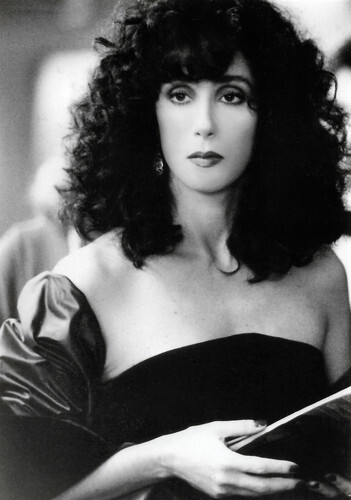
Vintage photo. Cher in Moonstruck (Norman Jewison, 1987).
I Got You Babe
Cherilyn Sarkisian was born in 1946 in El Centro, California, the daughter of Georgia Holt (the former Jackie Jean Crouch) and truck driver John Sarkisian. She has a sister, Georganne LaPiere. The father deserted the family when Cher was young, and her mother later married banker Gilbert LaPiere.
Her mother, who aspired to be an actress and model, paid for Cher's acting classes. Cher had undiagnosed dyslexia, which acutely affected her studies; frustrated, she quit Fresno High School at 16 to pursue her dream. At that time, she had a brief relationship with actor Warren Beatty.
In 1962 Cher's life changed forever when she met the older-by-11-years Sonny Bono. He was working for record producer Phil Spector at Gold Star Studios in Hollywood and managed to persuade Spector to hire Cher as a session singer. She recorded backup vocals on Spector classics like 'You've Lost That Lovin' Feelin'' and 'Be My Baby.'
The couple's relationship evolved and they married in 1964. At first, Cher sang solo with Sonny behind the scenes writing, arranging, and producing her songs. When the records went nowhere, Sonny decided they needed to perform as a team, They signed with Atco/Atlantic Records and put out two songs in 1964 under the recording names of Caesar and Cleo ('The Letter' and 'Baby Don't Go'). Again, no success.
The changing of their names, however, made a difference and in 1965, they officially took on the music world as Sonny & Cher and earned instant rewards. The now 19-year-old Cher and 30-year-old Sonny became huge hits following the release of their first album, 'Look at Us' (1965), which contained the hit single 'I Got You Babe'. With the song catapulting to #1, they decided to re-release their earlier single 'Baby Don't Go', and it also raced up the charts to #8. An assembly line of mild hits dotted the airwaves over the next year or two, culminating in the huge smash hit 'The Beat Goes On' (#6, 1967). Between 1965 and 1972 Sonny & Cher charted a total of six Top 10 hits.
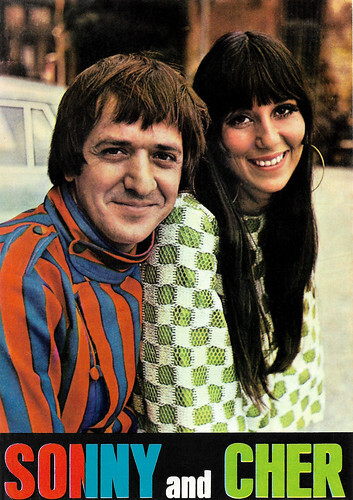
Italian postcard by Silvercart, Milano, no. 530/1. Photo: Dischi Ariston.
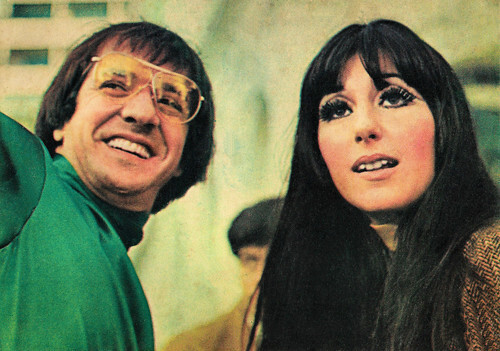
Italian postcard by Litografice Diesse / Cristo S. Pietro in Carte, Montecelli.
Bang, Bang
Sonny and Cher released three studio albums in the late 1960s. Gary Brumburgh at IMDb : "The kooky couple became icons of the late '60s 'flower power' scene, wearing garish garb and outlandish hairdos and makeup. However, they found a way to make it trendy and were embraced around the world. TV musical variety and teen pop showcases relished their contrasting styles - the short, excitable, mustachioed, nasal-toned simpleton and the taller, exotic, unflappable fashion maven. They found a successful formula with their repartee, which became a central factor in their live concert shows, even more than their singing."
With all this going on, Sonny still endeavored to promote Cher as a solo success. Other than such hits with 'All I Really Want to Do' (#16) and 'Bang, Bang' (#2), she struggled to find a separate identity. Sonny arranged film projects for her but Good Times (William Friedkin, 1967), an offbeat fantasy starring the couple, and Cher's serious solo effort Chastity (Alessio de Paola, 1969) both flickered out and died a quick death.
Gary Brumburgh: "By the end of the 1960s, Sonny & Cher's career had stumbled as they witnessed the American pop culture experience a drastic evolutionary change. The couple maintained their stage act and all the while Sonny continued to polish it up in a shrewd gamble for TV acceptance. While Sonny on stage played the ineffectual object of Cher's stinging barbs on stage, he was actually the highly motivated mastermind off stage and, amazingly enough, his foresight and chutzpah really paid off. Although the couple had lost favor with the new 70s generation, Sonny encouraged TV talent scouts to catch their live act."
In 1972, after four years of silence, the couple returned to the studio and released two other albums under the MCA/Kapp Records label. They also positioned themselves as media personalities. The Sonny and Cher Comedy Hour (1971) was given the green light as a summer replacement series and it was an instant sensation when the show earned its own time spot that fall season. The show received numerous Emmy Award nominations during its run and the couple became stars all over again. Their lively, off-the-wall comedy sketch routines, her outré Bob Mackie fashions, and their harmless, edgy banter were the highlights of the hour-long program. Their daughter Chaz Bono occasionally appeared on the show.
Cher's TV success also generated renewed interest in her as a solo recording artist and she came up with three #1 hits during this time ('Gypsys, Tramps & Thieves', 'Half-Breed', and 'Dark Lady'). A now-confident Cher yearned to be free of her husband Sonny's Svengali-like control over her life and career. The marriage split at the seams in 1974 and they publicly announced their separation. The couple's career as a duo ended in 1975 following their divorce.
In late June of 1975, only three days after the couple's divorce, Cher married rock musician Gregg Allman of The Allman Brothers Band. That marriage imploded rather quickly amid reports of out-of-control drug use on his part. They were divorced by 1977 with only one bright outcome - son Elijah Allman. In 1976 Sonny and Cher attempted to 'make up' again, this time to the tune of a second The Sonny and Cher Show (1976). Audiences, however, did not accept the "friendly" divorced couple after so much tabloid nastiness. After the initial curiosity factor wore off, the show was canceled amid poor ratings. In the decade they spent together, Sonny and Cher sold 80 million records worldwide. The duo was inducted into the Hollywood Walk of Fame in 1998, right after Sonny's death.
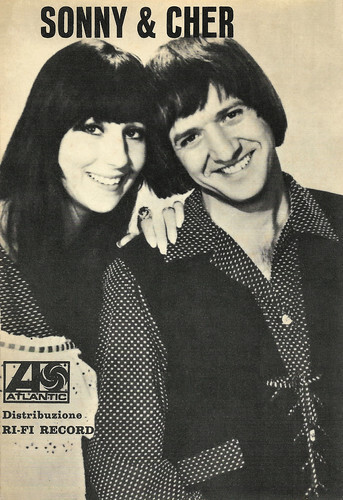
Italian promotion card by Ri-Fi Record Co., Milano. Photo: Atlantic / Ri-Fi Record.
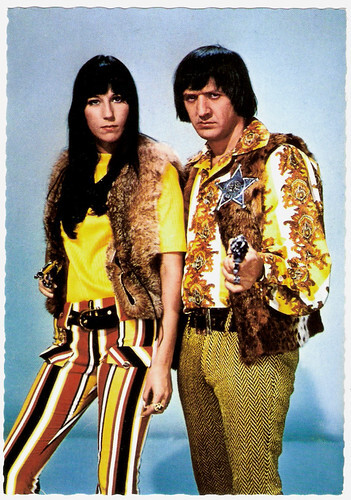
German postcard by ISV, no. H 129.
If I Could Turn Back Time
Cher found mild success with the disco hit 'Take Me Home' in 1979, but not much else. Not one to be counted out, however, the ever-resourceful singer decided to lay back and focus on acting instead. At age 36, Cher made her Broadway debut in 1982 in what was essentially her first live acting role with 'Come Back to the Five and Dime, Jimmy Dean, Jimmy Dean'.
Centering around a reunion of girlfriends from an old James Dean fan club, her performance was critically lauded. This earned her the right to transfer her stage triumph to film alongside Karen Black and Sandy Dennis. Cher earned critical raves for Come Back to the 5 & Dime Jimmy Dean, Jimmy Dean (Robert Altman, 1982), her first film role since 1969.
With film #2 came a Best Supporting Actress Oscar nomination and a Golden Globe win for her portrayal of a lesbian toiling in a nuclear parts factory in Silkwood (Mike Nichols, 1983), starring Meryl Streep and Kurt Russell.
This in turn was followed by her star turn in Mask (Peter Bogdanovich, 1985) as the blunt, footloose mother of a son afflicted with a rare disease, played beautifully by Eric Stoltz. Once again Cher received high praise and copped a win from the Cannes Film Festival for her poignant performance. Fully accepted by this time as an actress of high caliber, she integrated well into the Hollywood community.
Proving that she could hold up a film outright, she was handed three hit vehicles to star in: The Witches of Eastwick (George Miller, 1987), Suspect (Pewter Yates, 1987), and Moonstruck (Norman Jewison, 1987), for which she won the Academy Award for Best Actress. Along with all this newfound Hollywood celebrity came the interest in her as a singer and recording artist again. 'If I Could Turn Back Time' (#3) and the Peter Cetera duet 'After All' (#6) placed her back on the Billboard charts.
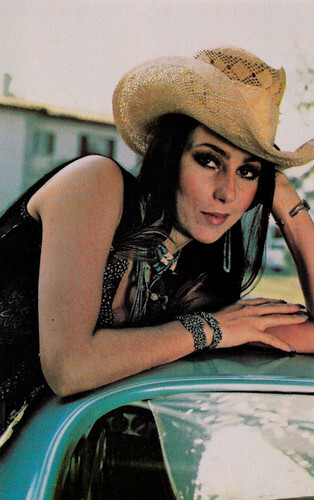
American postcard by Coral-Lee, Rancho Cordova, CA, no. CL/Personality #5 Photo: Douglas Kirkland / Contact, 1977.
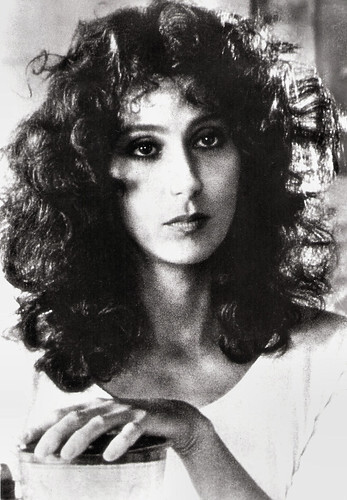
East-German postcard by Progress Film-Verleih, Berlin, no. 500/12/89. Photo: Filmspiegel. Cher in Mask (Peter Bogdanovich, 1985).
Believe
During the 1990s Cher continued to veer back and forth among films, TV specials, and expensively mounted concerts. In January of 1998, tragedy struck when Cher's ex-husband Sonny Bono, who had forsaken an entertainment career for California politics and became a popular Republican congressman in the process, was killed in a freak skiing accident.
In the meantime, an astounding career adrenaline rush came in the form of the monstrous, disco-flavored hit single 'Believe'. The song became a #1 hit and the same-titled album the biggest hit of her career. 'Believe' reached #1 in 23 different countries.
Having little to prove anymore to anyone, Cher decided to embark on a 'Farewell Tour' in the early part of the millennium and, after much stretching, her show finally closed in 2005 in Los Angeles. It didn't take long, however, for Cher to return from this self-imposed exile. In 2008, she finalized a deal with Las Vegas' Caesars Palace for the next three years to play the Colosseum and has since returned live on numerous 'farewell' tour extravaganzas. Never say never.
Cher returned to films with her co-starring role opposite Christina Aguilera in Burlesque (Steve Antin, 2010), but has since only provided a glitzy cameo in Mamma Mia! Here We Go Again (Ol Parker, 2018).
In other facets of her life, Cher has been involved with many humanitarian groups and charity efforts over the years. Gary Brumburgh, once again: "The beat goes on ... and on ... and as strong as ever for this superstar entertainer who has well surpassed the four-decade mark while improbably transforming herself from an artificial, glossy "fashion plate" singer into a serious, Oscar-worthy, dramatic actress ... and back again! With more ups and downs than the 2008 Dow Jones Industrial Average, Cher managed to rise like a phoenix from the ashes each time she was down, somehow re-inventing herself with every decade and finding herself on top all over again."
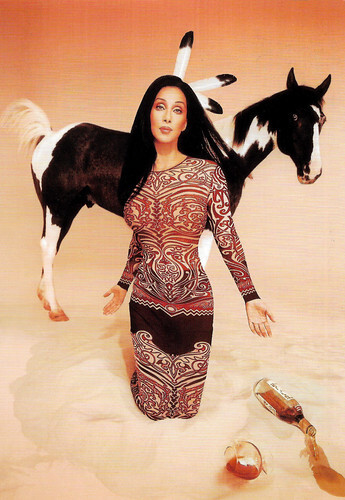
American postcard by Fotofolio. Photo: David LaChapelle. Caption: Cher and pretty pony, 1996.
Sources: (IMDb), Wikipedia, and .

Dutch postcard by 't Sticht, Utrecht. no. AX 6383.

Vintage photo. Cher in Moonstruck (Norman Jewison, 1987).
I Got You Babe
Cherilyn Sarkisian was born in 1946 in El Centro, California, the daughter of Georgia Holt (the former Jackie Jean Crouch) and truck driver John Sarkisian. She has a sister, Georganne LaPiere. The father deserted the family when Cher was young, and her mother later married banker Gilbert LaPiere.
Her mother, who aspired to be an actress and model, paid for Cher's acting classes. Cher had undiagnosed dyslexia, which acutely affected her studies; frustrated, she quit Fresno High School at 16 to pursue her dream. At that time, she had a brief relationship with actor Warren Beatty.
In 1962 Cher's life changed forever when she met the older-by-11-years Sonny Bono. He was working for record producer Phil Spector at Gold Star Studios in Hollywood and managed to persuade Spector to hire Cher as a session singer. She recorded backup vocals on Spector classics like 'You've Lost That Lovin' Feelin'' and 'Be My Baby.'
The couple's relationship evolved and they married in 1964. At first, Cher sang solo with Sonny behind the scenes writing, arranging, and producing her songs. When the records went nowhere, Sonny decided they needed to perform as a team, They signed with Atco/Atlantic Records and put out two songs in 1964 under the recording names of Caesar and Cleo ('The Letter' and 'Baby Don't Go'). Again, no success.
The changing of their names, however, made a difference and in 1965, they officially took on the music world as Sonny & Cher and earned instant rewards. The now 19-year-old Cher and 30-year-old Sonny became huge hits following the release of their first album, 'Look at Us' (1965), which contained the hit single 'I Got You Babe'. With the song catapulting to #1, they decided to re-release their earlier single 'Baby Don't Go', and it also raced up the charts to #8. An assembly line of mild hits dotted the airwaves over the next year or two, culminating in the huge smash hit 'The Beat Goes On' (#6, 1967). Between 1965 and 1972 Sonny & Cher charted a total of six Top 10 hits.

Italian postcard by Silvercart, Milano, no. 530/1. Photo: Dischi Ariston.

Italian postcard by Litografice Diesse / Cristo S. Pietro in Carte, Montecelli.
Bang, Bang
Sonny and Cher released three studio albums in the late 1960s. Gary Brumburgh at IMDb : "The kooky couple became icons of the late '60s 'flower power' scene, wearing garish garb and outlandish hairdos and makeup. However, they found a way to make it trendy and were embraced around the world. TV musical variety and teen pop showcases relished their contrasting styles - the short, excitable, mustachioed, nasal-toned simpleton and the taller, exotic, unflappable fashion maven. They found a successful formula with their repartee, which became a central factor in their live concert shows, even more than their singing."
With all this going on, Sonny still endeavored to promote Cher as a solo success. Other than such hits with 'All I Really Want to Do' (#16) and 'Bang, Bang' (#2), she struggled to find a separate identity. Sonny arranged film projects for her but Good Times (William Friedkin, 1967), an offbeat fantasy starring the couple, and Cher's serious solo effort Chastity (Alessio de Paola, 1969) both flickered out and died a quick death.
Gary Brumburgh: "By the end of the 1960s, Sonny & Cher's career had stumbled as they witnessed the American pop culture experience a drastic evolutionary change. The couple maintained their stage act and all the while Sonny continued to polish it up in a shrewd gamble for TV acceptance. While Sonny on stage played the ineffectual object of Cher's stinging barbs on stage, he was actually the highly motivated mastermind off stage and, amazingly enough, his foresight and chutzpah really paid off. Although the couple had lost favor with the new 70s generation, Sonny encouraged TV talent scouts to catch their live act."
In 1972, after four years of silence, the couple returned to the studio and released two other albums under the MCA/Kapp Records label. They also positioned themselves as media personalities. The Sonny and Cher Comedy Hour (1971) was given the green light as a summer replacement series and it was an instant sensation when the show earned its own time spot that fall season. The show received numerous Emmy Award nominations during its run and the couple became stars all over again. Their lively, off-the-wall comedy sketch routines, her outré Bob Mackie fashions, and their harmless, edgy banter were the highlights of the hour-long program. Their daughter Chaz Bono occasionally appeared on the show.
Cher's TV success also generated renewed interest in her as a solo recording artist and she came up with three #1 hits during this time ('Gypsys, Tramps & Thieves', 'Half-Breed', and 'Dark Lady'). A now-confident Cher yearned to be free of her husband Sonny's Svengali-like control over her life and career. The marriage split at the seams in 1974 and they publicly announced their separation. The couple's career as a duo ended in 1975 following their divorce.
In late June of 1975, only three days after the couple's divorce, Cher married rock musician Gregg Allman of The Allman Brothers Band. That marriage imploded rather quickly amid reports of out-of-control drug use on his part. They were divorced by 1977 with only one bright outcome - son Elijah Allman. In 1976 Sonny and Cher attempted to 'make up' again, this time to the tune of a second The Sonny and Cher Show (1976). Audiences, however, did not accept the "friendly" divorced couple after so much tabloid nastiness. After the initial curiosity factor wore off, the show was canceled amid poor ratings. In the decade they spent together, Sonny and Cher sold 80 million records worldwide. The duo was inducted into the Hollywood Walk of Fame in 1998, right after Sonny's death.

Italian promotion card by Ri-Fi Record Co., Milano. Photo: Atlantic / Ri-Fi Record.

German postcard by ISV, no. H 129.
If I Could Turn Back Time
Cher found mild success with the disco hit 'Take Me Home' in 1979, but not much else. Not one to be counted out, however, the ever-resourceful singer decided to lay back and focus on acting instead. At age 36, Cher made her Broadway debut in 1982 in what was essentially her first live acting role with 'Come Back to the Five and Dime, Jimmy Dean, Jimmy Dean'.
Centering around a reunion of girlfriends from an old James Dean fan club, her performance was critically lauded. This earned her the right to transfer her stage triumph to film alongside Karen Black and Sandy Dennis. Cher earned critical raves for Come Back to the 5 & Dime Jimmy Dean, Jimmy Dean (Robert Altman, 1982), her first film role since 1969.
With film #2 came a Best Supporting Actress Oscar nomination and a Golden Globe win for her portrayal of a lesbian toiling in a nuclear parts factory in Silkwood (Mike Nichols, 1983), starring Meryl Streep and Kurt Russell.
This in turn was followed by her star turn in Mask (Peter Bogdanovich, 1985) as the blunt, footloose mother of a son afflicted with a rare disease, played beautifully by Eric Stoltz. Once again Cher received high praise and copped a win from the Cannes Film Festival for her poignant performance. Fully accepted by this time as an actress of high caliber, she integrated well into the Hollywood community.
Proving that she could hold up a film outright, she was handed three hit vehicles to star in: The Witches of Eastwick (George Miller, 1987), Suspect (Pewter Yates, 1987), and Moonstruck (Norman Jewison, 1987), for which she won the Academy Award for Best Actress. Along with all this newfound Hollywood celebrity came the interest in her as a singer and recording artist again. 'If I Could Turn Back Time' (#3) and the Peter Cetera duet 'After All' (#6) placed her back on the Billboard charts.

American postcard by Coral-Lee, Rancho Cordova, CA, no. CL/Personality #5 Photo: Douglas Kirkland / Contact, 1977.

East-German postcard by Progress Film-Verleih, Berlin, no. 500/12/89. Photo: Filmspiegel. Cher in Mask (Peter Bogdanovich, 1985).
Believe
During the 1990s Cher continued to veer back and forth among films, TV specials, and expensively mounted concerts. In January of 1998, tragedy struck when Cher's ex-husband Sonny Bono, who had forsaken an entertainment career for California politics and became a popular Republican congressman in the process, was killed in a freak skiing accident.
In the meantime, an astounding career adrenaline rush came in the form of the monstrous, disco-flavored hit single 'Believe'. The song became a #1 hit and the same-titled album the biggest hit of her career. 'Believe' reached #1 in 23 different countries.
Having little to prove anymore to anyone, Cher decided to embark on a 'Farewell Tour' in the early part of the millennium and, after much stretching, her show finally closed in 2005 in Los Angeles. It didn't take long, however, for Cher to return from this self-imposed exile. In 2008, she finalized a deal with Las Vegas' Caesars Palace for the next three years to play the Colosseum and has since returned live on numerous 'farewell' tour extravaganzas. Never say never.
Cher returned to films with her co-starring role opposite Christina Aguilera in Burlesque (Steve Antin, 2010), but has since only provided a glitzy cameo in Mamma Mia! Here We Go Again (Ol Parker, 2018).
In other facets of her life, Cher has been involved with many humanitarian groups and charity efforts over the years. Gary Brumburgh, once again: "The beat goes on ... and on ... and as strong as ever for this superstar entertainer who has well surpassed the four-decade mark while improbably transforming herself from an artificial, glossy "fashion plate" singer into a serious, Oscar-worthy, dramatic actress ... and back again! With more ups and downs than the 2008 Dow Jones Industrial Average, Cher managed to rise like a phoenix from the ashes each time she was down, somehow re-inventing herself with every decade and finding herself on top all over again."

American postcard by Fotofolio. Photo: David LaChapelle. Caption: Cher and pretty pony, 1996.
Sources: (IMDb), Wikipedia, and .
Published on December 16, 2021 22:00
December 15, 2021
Bessie Barriscale
American actress Bessie Barriscale (1884-1965) was a major star for producer Thomas H. Ince in the second half of the 1910s, marketed as 'the girl with the biggest eyes'. Barriscale became one of the highest-paid actresses of the time but many of her most important films are now lost.
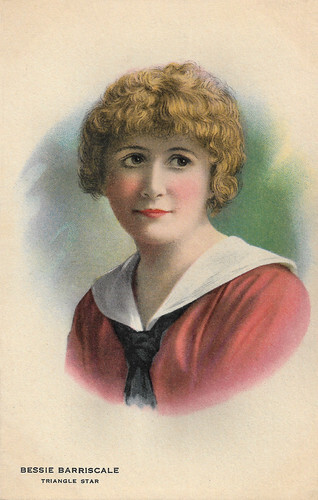
American postcard by Kline Poster Co. Inc., Phila. Image: Triangle.
The equally lovely and long-suffering girl
Bessie Barriscale was born in 1884 in Hoboken, New Jersey as Elizabeth Barry Scale. Her parents were Irish immigrants and the actresses Edith and Mabel Taliaferro were her cousins.
Since the 1900s, Barriscale was a regular on theatre stages and starred on Broadway. Upon completing her first film in 1913, Barriscale left the legitimate stage for what would be a period of seven years.
She became widely known to film audiences in 1914 with her leading role in the Western Rose of the Rancho, directed by Cecil B. DeMille , which was a big box-office hit at the time.
According to Maria Fosheim Lund at Women's Film Pioneer Project, Barriscale’s film career started when producer Jesse L. Lasky bought the film rights to ten plays produced by theatre impresario David Belasco: "Barriscale, who had starred in the successful Belasco play 'Rose of the Rancho' and may have originated the part of Juanita, was invited to repeat the performance in the 1914 film of the same name".
In the following years, she cemented her status as a Hollywood star with leading roles in melodramas directed by Thomas H. (Harper) Ince for the New York Motion Picture Company, where she stayed for three years. She made her mark in a seemingly never-ending series of melodramas with titles like Plain Jane (Thomas H. Ince, 1916) and A Corner in Colleenes (Thomas H. Ince, 1916). Maria Fosheim Lund: "While Barriscale had quickly become a major star with Ince’s company, the films she acted in were easily forgettable."
Mostly, Barriscale played the role of the equally lovely and long-suffering girl who has to fight her way through bad circumstances. Because of her beautiful eyes, Hollywood marketed her, among other things, as 'the girl with the biggest eyes'. When her contract expired, she left the company, which had been sold to Triangle Film Corporation.
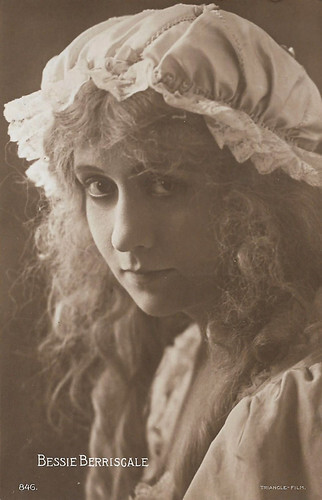
Swedish postcard by Förlag Nordisk Konst, Stockholm, no. 846. Photo: Triangle-Film.
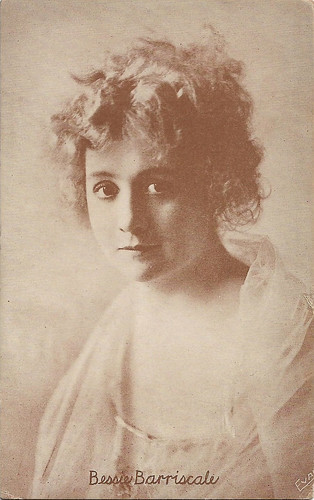
American postcard. Photo: Evans.
A one million US dollars contract
In 1918 Bessie Barriscale signed a contract for 16 films with Bessie Barriscale Features. The company was to start work in a new state-of-the-art studio in Hollywood, where, according to the Moving Picture World, they hoped to produce six to eight features per year. The contract earned her at least one million US dollars and made her one of the highest-paid actresses of the time. B.B. Features' first project was Rose O’Paradise (James Young, 1918).
The Bessie Barriscale Feature Company released eight films in 1918. She abandoned the ingenue role with which she had been associated at Triangle in favor of more varied, mature, and challenging parts. Her husband, Howard C. Hickman acted alongside his wife, but also directed her in films such as The White Lie (Howard Hickman, 1918).
About a year and a half after the start with Paralta Plays, Barriscale withdrew from the Paralta program after the release of The Heart of Rachael (Howard Hickman, 1919). She changed distributors, continuing with the Robertson-Cole Company. Barriscale’s company underwent a slight name change, now to release pictures as B. B. Features.
According to Wikipedia , Bessie was an excellent swimmer. Her film The Woman Michael Married (Henry Kolker, 1919) was adapted from a novel by famous swimmer Annette Kellermann. For the film, Barriscale hired a swimming and diving instructor and took lessons in Venice, California. A 90-foot pool was constructed at Brunton Studios where the scenes were shot.
In 1919, she traveled with her husband and their small son on a world tour. They anticipated producing motion pictures during their journey and traveled with a cameraman. Between 1918 and 1921, B. B. Features produced and released a total of sixteen titles of which none are known to have survived. In the early 1920s, Barriscale's career slowly passed its zenith and she subsequently made fewer films.
Hans J. Wollstein writes at AllMovie that Barriscale was "really too Edwardian to fit into the Roaring 1920s". In 1921, she returned to the stage to play in 'The Skirt'. The play was to travel to Philadelphia and Boston after opening in Washington, D.C. Later the production appeared in New York City. In 1928, Barriscale returned to Broadway in the play 'Women Go On Forever'.
At the beginning of the talkies, Barriscale only played character roles, mostly as a mother or servant in supporting roles. Barriscale's most significant performance of the talkies was probably her portrayal of Mary Pickford 's unfriendly daughter in Frank Borzage's epic Western Secrets (1933).
Her last film role was a bit part as a maid in The Man Who Reclaimed His Head (Edward Ludwig, 1934) alongside Claude Rains and Joan Bennett . Bessie was married to fellow actor Howard C. Hickman. They had met on the stage, and the two worked together as members of the same stock companies for years. The couple also worked together on many films. They remained together till his death in 1949 and had one son, born in 1908.
Bessie Barriscale passed away in 1965 in Kentfield, California. She was 80. She and her husband were buried in Mount Tamalpais Cemetery in San Rafael. In 1960, five years before her death, Bessie Barriscale received a star on the Hollywood Walk of Fame for her film work.
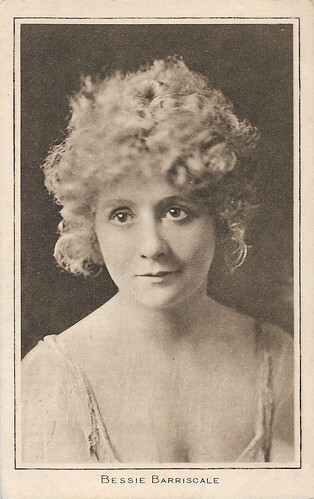
British postcard in the Pictures Portrait Gallery, London, no. 164.
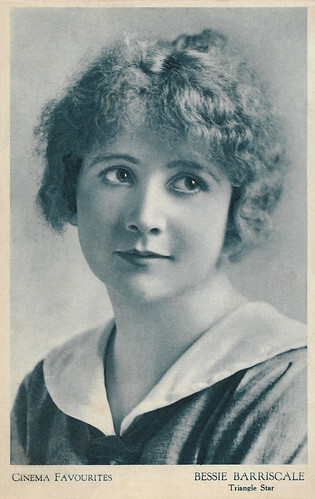
British postcard in the Cinema Favourites series by Photochrom Co. Ltd., London in Conjunction with Triangle Plays, no. 101. Photo: Triangle.
Sources: Maria Fosheim Lund (Women Film Pioneers Project), Hans J. Wollstein (AllMovie), Wikipedia (German and English), and .

American postcard by Kline Poster Co. Inc., Phila. Image: Triangle.
The equally lovely and long-suffering girl
Bessie Barriscale was born in 1884 in Hoboken, New Jersey as Elizabeth Barry Scale. Her parents were Irish immigrants and the actresses Edith and Mabel Taliaferro were her cousins.
Since the 1900s, Barriscale was a regular on theatre stages and starred on Broadway. Upon completing her first film in 1913, Barriscale left the legitimate stage for what would be a period of seven years.
She became widely known to film audiences in 1914 with her leading role in the Western Rose of the Rancho, directed by Cecil B. DeMille , which was a big box-office hit at the time.
According to Maria Fosheim Lund at Women's Film Pioneer Project, Barriscale’s film career started when producer Jesse L. Lasky bought the film rights to ten plays produced by theatre impresario David Belasco: "Barriscale, who had starred in the successful Belasco play 'Rose of the Rancho' and may have originated the part of Juanita, was invited to repeat the performance in the 1914 film of the same name".
In the following years, she cemented her status as a Hollywood star with leading roles in melodramas directed by Thomas H. (Harper) Ince for the New York Motion Picture Company, where she stayed for three years. She made her mark in a seemingly never-ending series of melodramas with titles like Plain Jane (Thomas H. Ince, 1916) and A Corner in Colleenes (Thomas H. Ince, 1916). Maria Fosheim Lund: "While Barriscale had quickly become a major star with Ince’s company, the films she acted in were easily forgettable."
Mostly, Barriscale played the role of the equally lovely and long-suffering girl who has to fight her way through bad circumstances. Because of her beautiful eyes, Hollywood marketed her, among other things, as 'the girl with the biggest eyes'. When her contract expired, she left the company, which had been sold to Triangle Film Corporation.

Swedish postcard by Förlag Nordisk Konst, Stockholm, no. 846. Photo: Triangle-Film.

American postcard. Photo: Evans.
A one million US dollars contract
In 1918 Bessie Barriscale signed a contract for 16 films with Bessie Barriscale Features. The company was to start work in a new state-of-the-art studio in Hollywood, where, according to the Moving Picture World, they hoped to produce six to eight features per year. The contract earned her at least one million US dollars and made her one of the highest-paid actresses of the time. B.B. Features' first project was Rose O’Paradise (James Young, 1918).
The Bessie Barriscale Feature Company released eight films in 1918. She abandoned the ingenue role with which she had been associated at Triangle in favor of more varied, mature, and challenging parts. Her husband, Howard C. Hickman acted alongside his wife, but also directed her in films such as The White Lie (Howard Hickman, 1918).
About a year and a half after the start with Paralta Plays, Barriscale withdrew from the Paralta program after the release of The Heart of Rachael (Howard Hickman, 1919). She changed distributors, continuing with the Robertson-Cole Company. Barriscale’s company underwent a slight name change, now to release pictures as B. B. Features.
According to Wikipedia , Bessie was an excellent swimmer. Her film The Woman Michael Married (Henry Kolker, 1919) was adapted from a novel by famous swimmer Annette Kellermann. For the film, Barriscale hired a swimming and diving instructor and took lessons in Venice, California. A 90-foot pool was constructed at Brunton Studios where the scenes were shot.
In 1919, she traveled with her husband and their small son on a world tour. They anticipated producing motion pictures during their journey and traveled with a cameraman. Between 1918 and 1921, B. B. Features produced and released a total of sixteen titles of which none are known to have survived. In the early 1920s, Barriscale's career slowly passed its zenith and she subsequently made fewer films.
Hans J. Wollstein writes at AllMovie that Barriscale was "really too Edwardian to fit into the Roaring 1920s". In 1921, she returned to the stage to play in 'The Skirt'. The play was to travel to Philadelphia and Boston after opening in Washington, D.C. Later the production appeared in New York City. In 1928, Barriscale returned to Broadway in the play 'Women Go On Forever'.
At the beginning of the talkies, Barriscale only played character roles, mostly as a mother or servant in supporting roles. Barriscale's most significant performance of the talkies was probably her portrayal of Mary Pickford 's unfriendly daughter in Frank Borzage's epic Western Secrets (1933).
Her last film role was a bit part as a maid in The Man Who Reclaimed His Head (Edward Ludwig, 1934) alongside Claude Rains and Joan Bennett . Bessie was married to fellow actor Howard C. Hickman. They had met on the stage, and the two worked together as members of the same stock companies for years. The couple also worked together on many films. They remained together till his death in 1949 and had one son, born in 1908.
Bessie Barriscale passed away in 1965 in Kentfield, California. She was 80. She and her husband were buried in Mount Tamalpais Cemetery in San Rafael. In 1960, five years before her death, Bessie Barriscale received a star on the Hollywood Walk of Fame for her film work.

British postcard in the Pictures Portrait Gallery, London, no. 164.

British postcard in the Cinema Favourites series by Photochrom Co. Ltd., London in Conjunction with Triangle Plays, no. 101. Photo: Triangle.
Sources: Maria Fosheim Lund (Women Film Pioneers Project), Hans J. Wollstein (AllMovie), Wikipedia (German and English), and .
Published on December 15, 2021 22:00
Paul van Yperen's Blog
- Paul van Yperen's profile
- 13 followers
Paul van Yperen isn't a Goodreads Author
(yet),
but they
do have a blog,
so here are some recent posts imported from
their feed.



